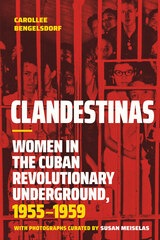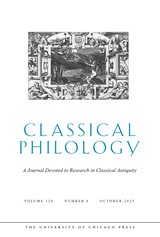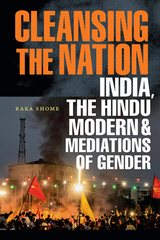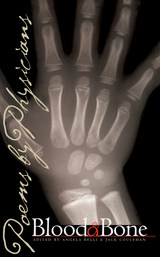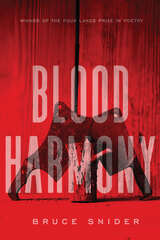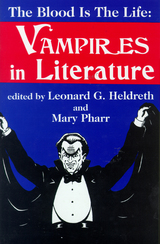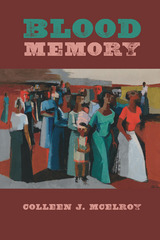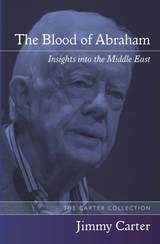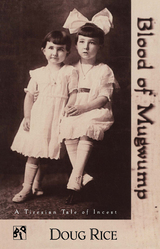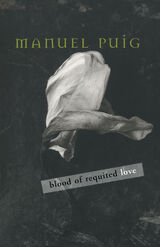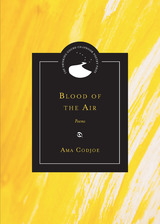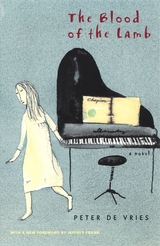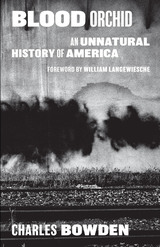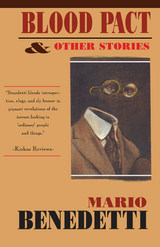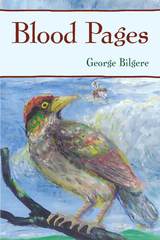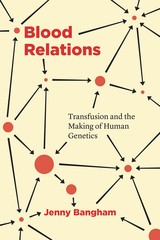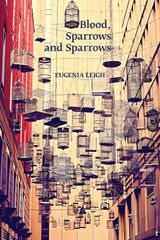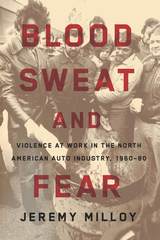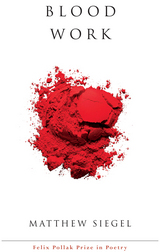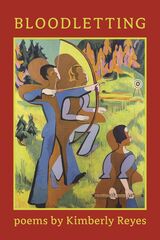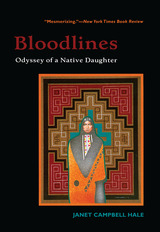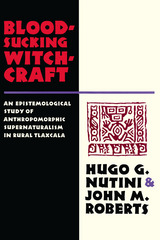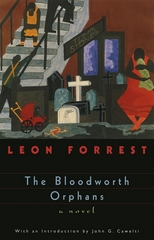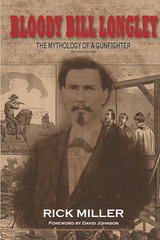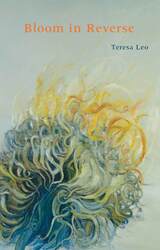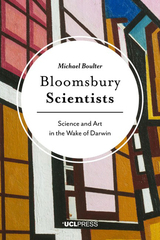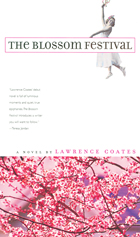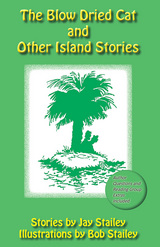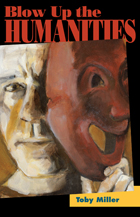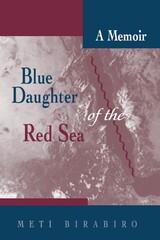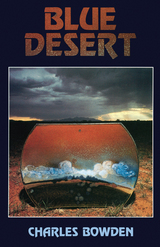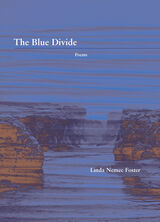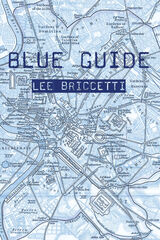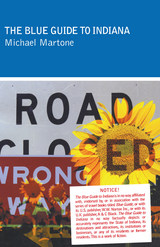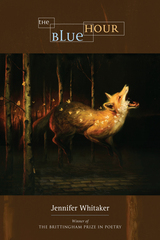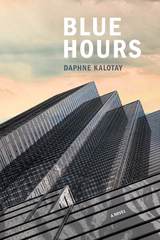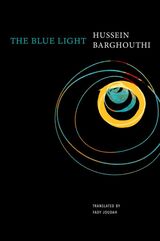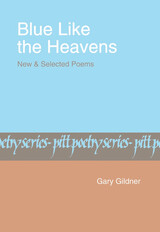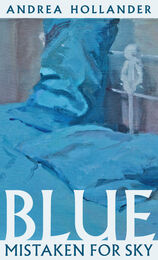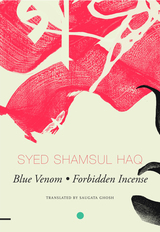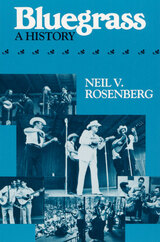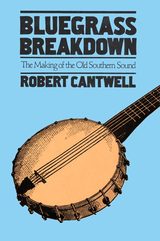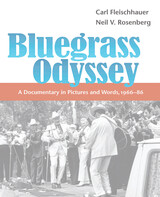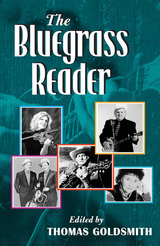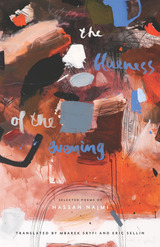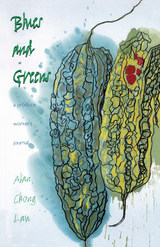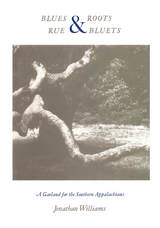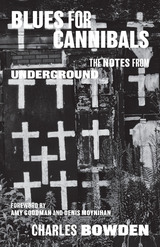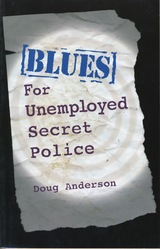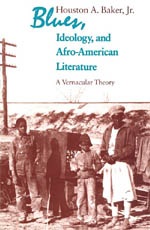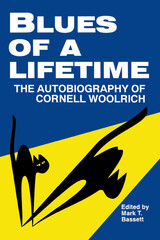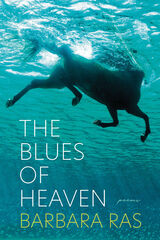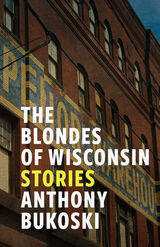 The Blondes of Wisconsin
Anthony Bukoski
University of Wisconsin Press, 2021 Like stones cast into a river, these sixteen moving, intimate stories illuminate how devotion and degeneration ripple through a working-class Polish American community in the postindustrial Midwest. At the heart of the collection is Eddie “The Bronko” Bronkowski, a boxer with a losing record whose reputation as a human punching bag precedes him. In each of Anthony Bukoski’s rich stories, tough yet sympathetic characters—the second cook on a Great Lakes freighter, a World War II veteran, the emcee of a female boxing troupe—take all that life throws at them, protecting those around them as best they can.
In Bukoski’s interconnected tales, the heart seeks its due despite familial conflict, the challenges of maritime work, and the slow yet inexorable decline of dementia. Beautiful vignettes express transformative moments: tenderness that can turn a cardboard crown into gold and the faint ghosts of memories long forgotten. A tour-de-force, The Blondes of Wisconsin knows what love is—and what it means to lose it.
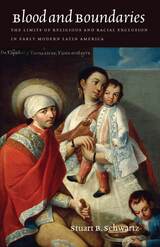 Blood and Boundaries: The Limits of Religious and Racial Exclusion in Early Modern Latin America
Stuart B. Schwartz
Brandeis University Press, 2020 In Blood and Boundaries, Stuart B. Schwartz takes us to late medieval Latin America to show how Spain and Portugal’s policies of exclusion and discrimination based on religious origins and genealogy were transferred to their colonies in Latin America. Rather than concentrating on the three principal divisions of colonial society—Indians, Europeans, and people of African origins—as is common in studies of these colonial societies, Schwartz examines the three minority groups of moriscos, conversos, and mestizos. Muslim and Jewish converts and their descendants, he shows, posed a special problem for colonial society: they were feared and distrusted as peoples considered ethnically distinct, but at the same time their conversion to Christianity seemed to violate stable social categories and identities. This led to the creation of “cleanliness of blood” regulations that explicitly discriminated against converts. Eventually, Schwartz shows, those regulations were extended to control the subject indigenous and enslaved African populations, and over time, applied to the growing numbers of mestizos, peoples of mixed ethnic origins. Despite the efforts of civil and church and state institutions to regulate, denigrate, and exclude, members of these affected groups often found legal and practical means to ignore, circumvent, or challenge the efforts to categorize and exclude them, creating in the process the dynamic societies of Latin America that emerged in the nineteenth century.
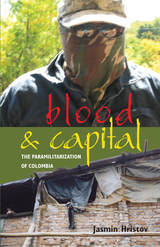 Blood and Capital: The Paramilitarization of Colombia
Jasmin Hristov
Ohio University Press, 2009 WOLA-Duke Book Award Finalist In Blood and Capital: The Paramilitarization of Colombia, Jasmin Hristov examines the complexities, dynamics, and contradictions of present-day armed conflict in Colombia. She conducts an in-depth inquiry into the restructuring of the state’s coercive apparatus and the phenomenon of paramilitarism by looking at its military, political, and legal dimensions. Hristov demonstrates how various interrelated forms of violence by state forces, paramilitary groups, and organized crime are instrumental to the process of capital accumulation by the local elite as well as the exercise of political power by foreign enterprises. She addresses, as well, issues of forced displacement, proletarianization of peasants, concentration of landownership, growth in urban and rural poverty, and human rights violations in relation to the use of legal means and extralegal armed force by local dominant groups and foreign companies.
Hristov documents the penetration of major state institutions by right-wing armed groups and the persistence of human rights violations against social movements and sectors of the low-income population. Blood and Capital raises crucial questions about the promised dismantling of paramilitarism in Colombia and the validity of the so-called demobilization of paramilitary groups, both of which have been widely considered by North American and some European governments as proof of Colombian president Álvaro Uribe’s advances in the wars on terror and drugs.
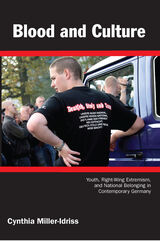 Blood and Culture: Youth, Right-Wing Extremism, and National Belonging in Contemporary Germany
Cynthia Miller-Idriss
Duke University Press, 2009 Over the past decade, immigration and globalization have significantly altered Europe’s cultural and ethnic landscape, foregrounding questions of national belonging. In Blood and Culture, Cynthia Miller-Idriss provides a rich ethnographic analysis of how patterns of national identity are constructed and transformed across generations. Drawing on research she conducted at German vocational schools between 1999 and 2004, Miller-Idriss examines how the working-class students and their middle-class, college-educated teachers wrestle with their different views about citizenship and national pride. The cultural and demographic trends in Germany are broadly indicative of those underway throughout Europe, yet the country’s role in the Second World War and the Holocaust makes national identity, and particularly national pride, a difficult issue for Germans. Because the vocational-school teachers are mostly members of a generation that came of age in the 1960s and 1970s and hold their parents’ generation responsible for National Socialism, many see national pride as symptomatic of fascist thinking. Their students, on the other hand, want to take pride in being German. Miller-Idriss describes a new understanding of national belonging emerging among young Germans—one in which cultural assimilation takes precedence over blood or ethnic heritage. Moreover, she argues that teachers’ well-intentioned, state-sanctioned efforts to counter nationalist pride often create a backlash, making radical right-wing groups more appealing to their students. Miller-Idriss argues that the state’s efforts to shape national identity are always tempered and potentially transformed as each generation reacts to the official conception of what the nation “ought” to be.
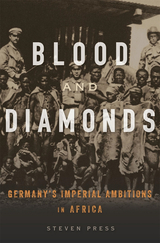 Blood and Diamonds: Germany’s Imperial Ambitions in Africa
Steven Press
Harvard University Press, 2021 Diamonds have long been bloody. A new history shows how Germany’s ruthless African empire brought diamond rings to retail display cases in America—at the cost of African lives.
Since the late 1990s, activists have campaigned to remove “conflict diamonds” from jewelry shops and department stores. But if the problem of conflict diamonds—gems extracted from war zones—has only recently generated attention, it is not a new one. Nor are conflict diamonds an exception in an otherwise honest industry. The modern diamond business, Steven Press shows, owes its origins to imperial wars and has never escaped its legacy of exploitation.
In Blood and Diamonds, Press traces the interaction of the mass-market diamond and German colonial domination in Africa. Starting in the 1880s, Germans hunted for diamonds in Southwest Africa. In the decades that followed, Germans waged brutal wars to control the territory, culminating in the genocide of the Herero and Nama peoples and the unearthing of vast mineral riches. Press follows the trail of the diamonds from the sands of the Namib Desert to government ministries and corporate boardrooms in Berlin and London and on to the retail counters of New York and Chicago. As Africans working in terrifying conditions extracted unprecedented supplies of diamonds, European cartels maintained the illusion that the stones were scarce, propelling the nascent US market for diamond engagement rings. Convinced by advertisers that diamonds were both valuable and romantically significant, American purchasers unwittingly funded German imperial ambitions into the era of the world wars.
Amid today’s global frenzy of mass consumption, Press’s history offers an unsettling reminder that cheap luxury often depends on an alliance between corporate power and state violence.
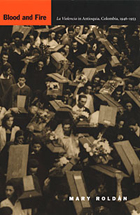 Blood and Fire: La Violencia in Antioquia, Colombia, 1946-1953
Mary Roldan
Duke University Press, 2003 Between 1946 and 1966a surge of violence in Colombia left 200,000 dead in one of the worst conflicts the western hemisphere has ever experienced. the first seven years of this little-studied period of terror, known as la Violencia, is the subject of Blood and Fire. Scholars have traditionally assumed that partisan politics drove La Violencia, but Mary Roldán challenges earlier assessments by providing a nuanced account of the political and cultural motives behind the fratricide. Although the author acknowledges that partisan animosities played an important role in the disintegration of peaceful discourse into violence, she argues that conventional political conflicts were intensified by other concerns.
Through an analysis of the evolution of violence in Antioquia, which at the time was the wealthiest and most economically diverse region of Colombia, Roldán demonstrates how tensions between regional politicians and the weak central state, diverse forms of social prejudice, and processes of economic development combined to make violence a preferred mode of political action. Privatization of state violence into paramilitary units and the emergence of armed resistance movements exacted a horrible cost on Colombian civic life, and these processes continue to plague the country.
Roldan’s reading of the historical events suggests that Antioquia’s experience of la Violencia was the culmination of a brand of internal colonialism in which regional identity formation based on assumptions of cultural superiority was used to justify violence against racial or ethnic "others" and as a pretext to seize land and natural resources. Blood and Fire demonstrates that, far from being a peculiarity of the Colombians, la Violencia was a logical product of capitalist development and state formation in the modern world.
This is the first study to analyze intersections of ethnicity, geography, and class to explore the genesis of Colombian violence, and it has implications for the study of repression in many other nations.
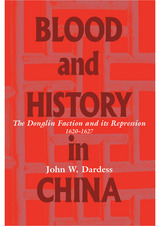 Blood and History in China: The Donglin Faction and its Repression, 1620-1627
John W. Dardess
University of Hawaii Press, 2002 From 1625 to 1627 scholar-officials belonging to a militant Confucianist group known as the "Donglin Faction" suffered one of the most gruesome political repressions in China's history. Many were purged from key positions in the central government for their relentless push for a national moral rearmament under the Tianqi emperor. While their martyrs' deaths won them a lasting reputation for heroism and steadfastness, their opponents are remembered for fatally degrading the quality of Ming political life with their arrests and tortures of Donglin partisans. John Dardess employs a wide range of little-used primary sources (letters, diaries, eyewitness accounts, memorials, imperial edicts) to provide a remarkably detailed narrative of the inner workings of Ming government and of this dramatic period as a whole. Comparing the repression with the Tiananmen demonstrations of 1989, he argues that Tiananmen offers compelling clues to a rereading of the events of the 1620s. Leaders of both movements were less interested in practical reform than in communicating sincere moral feelings to rulers and the public. In the end the protesters succeeded in commemorating their dead and imprisoned and in disgracing those responsible for the violence.
A work of unprecedented depth skillfully told, Blood and History in China will be appreciated by specialists in intellectual history and Ming and early Qing studies.<
 Blood and Homeland: Eugenics and Racial Nationalism in Central and Southeast Europe, 1900-1940
Paul J. Weindling
Central European University Press, 2007 The history of eugenics and racial nationalism in Central and Southeast Europe is a neglected topic of analysis in contemporary scholarship. The 20 essays in this volume, written by distinguished scholars of eugenics and fascism alongside a new generation of scholars, excavate the hitherto unknown eugenics movements in Central and Southeast Europe, including Austria and Germany. Eugenics and racial nationalism are topics that have constantly been marginalized and rated as incompatible with local national traditions in Central and Southeast Europe. These topics receive a new treatment here. On the one hand, the historiographic perspective connects developments in the history of anthropology and eugenics with political ideologies such as racial nationalism and anti-Semitism; on the other hand, it contests the 'Sonderweg' approach adopted by scholars dealing with these issues.
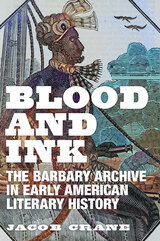 Blood and Ink: The Barbary Archive in Early American Literary History
Jacob Crane
University of Massachusetts Press, 2023 In the late eighteenth and early nineteenth centuries, Algerian piracy in the Mediterranean loomed large in the American imagination. An estimated seven hundred American citizens, sailors, and naval officers were taken captive over the course of the Barbary Crises (1784–1815), and this overseas danger threatened to grow and irreparably harm the young republic. Blood and Ink reconstructs the largely forgotten influence of these early American conflicts with North Africa on notions of publicity, print culture, and racial and national identity from independence to the Civil War. Exploring the extensive archive of texts inspired by the conflicts—from captivity narratives, novels, plays, and poems to broadsides, travel narratives, children’s literature, newspaper articles, and visual ephemera—Jacob Crane connects anxieties surrounding North African piracy and white slavery to both the development of American abolitionism and representations of transatlantic African and Jewish identities in the early national and antebellum periods.
 Blood and Religion: The Unmasking of the Jewish and Democratic State
Jonathan Cook
Pluto Press, 2006 "Timely and important . . . by far the most penetrarting and comprehensive [book] on the subject to date. . . . This work should be required reading." --Nur Masalha, Director of Holy Land Studies, St. Mary's College, University of Surrey, and author of The Politics of Denial
"An original and powerful book." --Ilan Pappe, Senior Lecturer in Political Science, Haifa University, and author of A Modern History of Palestine
"Very impressive. . . . Some of his findings will astound even the knowledgeable reader." --Salim Tamari, Director, Institute of Jerusalem Studies
What is Israel hoping to achieve with its recent withdrawal from Gaza and the buildiing of a 700 km wall? Journalist Jonathan Cook presents a lucid account of the motives. The heart of the issue, he argues, is demography. Israel fears the moment when the region's Palestinians--Israel's own Palestinian citizens and those in the Occupied Territories--become a majority. Inevitable omparisons with apartheid in South Africa will be drawn. The book charts Israel's increasingly desperate responses, including military repression of Palestinian dissent; a ban on marriages between Israel's Palestinian population and Palestinians living under occupation to prevent a right of return "through the back door;" and the redrawing of the Green Line to create an expanded state. Ultimately, the author concludes, these abuses will lead to a third, far deadlier intifada.
Jonathan Cook, a former staff journalist of the Guardian newspaper, has written for the Times, Le Monde diplomatique, the International Herald Tribune, al-Ahram Weekly, and Aljazeera.net. He is based in Nazareth.
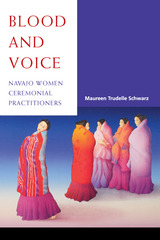 Blood and Voice: Navajo Women Ceremonial Practitioners
Maureen Trudelle Schwarz
University of Arizona Press, 2003 Adulthood in the Navajo world is marked by the onset of menstruation in females and by the deepening of the voice in males. Accordingly, young adults must accept responsibility over the powers manifest in blood and voice: for women, the forces that control reproduction and growth; for men, the powers of protection and restoration of order that come through maintaining Navajo oral tradition.
The maintenance of the latter tradition has long been held to be the function of the Navajo singer, a role usually viewed as male. But despite this longstanding assumption, women can and do fill this role. Drawing on interviews with seventeen Navajo women practitioners and five apprentices, Maureen Trudelle Schwarz explicates women's role as ceremonial practitioners and shows that it is more complex than has previously been thought. She examines gender differences dictated by the Navajo origin story, details how women came to be practitioners, and reveals their experiences and the strategies they use to negotiate being both woman and singer.
Women who choose careers as singers face complex challenges, since some rules prohibit menstruating women from conducting ceremonies and others regarding sexual continence can strain marital relationships. Additionally, oral history places men in charge of all ceremonial matters. Schwarz focuses on how the reproductive life courses of Navajo women influence their apprenticeships and practices to demonstrate how they navigate these issues to preserve time-honored traditions. Through the words of actual practitioners, she shows how each woman brings her own unique life experience to the role. While differing among individuals, these experiences represent a commitment to shared cultural symbols and result in a consensus that sustains social cohesion.
By showing the differences and similarities between the apprenticeship, initiation, and practice of men and women singers, Blood and Voice offers a better understanding of the role of Navajo women in a profession usually viewed as a male activity—and of the symbolic construction of the self in Navajo culture. It also addresses classic questions concerning the sexual division of labor, menstrual taboos, gender stereotypes, and the tension between tradition and change that will enlighten students of other cultures.
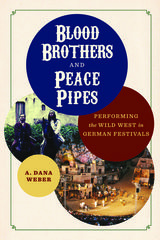 Blood Brothers and Peace Pipes: Performing the Wild West in German Festivals
A. Dana Weber
University of Wisconsin Press, 2019 "Nineteenth-century writer Karl May wrote novels about a fictionalized American Wild West that count among the most popular books of German literature to this day. His stories left an imprint on German culture, resulting in a variety of Wild West festivals featuring Native Americans and frontier settlers. These Karl May festivals are hosted widely throughout German-speaking countries today.
This book, based on years of fieldwork observing and studying the festivals, plays, events, and groups that comprise this subculture, addresses a larger, timely issue: cultural transfer and appropriations. Are Germans dressing up in American Indian costumes paying tribute or offending the cultures they are representing? Avoiding simplistic answers, A. Dana Weber considers the complexity of cultural enactments as they relate both to the distinctly German phenomenon as well as to larger questions of cultural representations in American and European live performance traditions."
 Blood Feather
Karla Kelsey
Tupelo Press, 2020 An inspired and engaging perspective of feminist art-making in a fractured world, Blood Feather reimagines resistance. With the help of three fictive narrators, an actress, a thinker, and a filmmaker create boundless opportunities for relatability. Caught up in a hurricane of identities, the actress wonders where the performance of character stops, saying, “rain has/a way of showing costumes for/what they really are”. The thinker, a so-called muse for her architect husband, searches for her self in a lyric embodying the molting process of a bird. This kind of evolution is central to all narratives, inspiring the reader to reflect on their own passages of growth. Taking its title from a vulnerable new feather of a bird that contains a constant flow of blood, Blood Feather reminds us of the essential yet fragile position of art. Protest and resistance can take that vital place of the blood inside of the feather in order to assert the importance of artful poetry such as this.
Blood Harmony
Bruce Snider
University of Wisconsin Press, 2025 An unflinching tale of selfishness and sacrifice, guilt and resentment, hope and despair, Bruce Snider’s fourth collection tells the story of two brothers torn apart by opioid addiction. These sublime poems paint a singular portrait of rural working-class America populated by shuttered tool factories and country gay bars, hidden fishing holes and Dolly Parton drag queens. Drawing on music and myth, science and history, Snider interrogates the bonds of family, exploring themes of masculinity, devotion, sexuality, and the biology of addiction. Yet for all its competing tensions, Blood Harmony leaves us with an enduring portrait of brotherhood defined as much by tenderness as by pain.
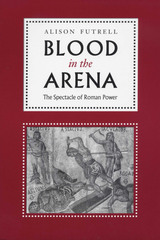 Blood in the Arena: The Spectacle of Roman Power
By Alison Futrell
University of Texas Press, 1997 From the center of Imperial Rome to the farthest reaches of ancient Britain, Gaul, and Spain, amphitheaters marked the landscape of the Western Roman Empire. Built to bring Roman institutions and the spectacle of Roman power to conquered peoples, many still remain as witnesses to the extent and control of the empire. In this book, Alison Futrell explores the arena as a key social and political institution for binding Rome and its provinces. She begins with the origins of the gladiatorial contest and shows how it came to play an important role in restructuring Roman authority in the later Republic. She then traces the spread of amphitheaters across the Western Empire as a means of transmitting and maintaining Roman culture and control in the provinces. Futrell also examines the larger implications of the arena as a venue for the ritualized mass slaughter of human beings, showing how the gladiatorial contest took on both religious and political overtones. This wide-ranging study, which draws insights from archaeology and anthropology, as well as Classics, broadens our understanding of the gladiatorial contest and its place within the highly politicized cult practice of the Roman Empire.
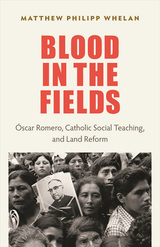 Blood in the Fields: Óscar Romero, Catholic Social Teaching, and Land Reform
Matthew Philipp Whelan
Catholic University of America Press, 2020 On March 24, 1980, a sniper shot and killed Archbishop Óscar Romero as he celebrated mass. Today, nearly four decades after his death, the world continues to wrestle with the meaning of his witness.
Blood in the Fields: Óscar Romero, Catholic Social Teaching, and Land Reform treats Romero’s role in one of the central conflicts that seized El Salvador during his time as archbishop and that plunged the country into civil war immediately after his death: the conflict over the concentration of agricultural land and the exclusion of the majority from access to land to farm. Drawing extensively on historical and archival sources, Blood in the Fields examines how and why Romero advocated for justice in the distribution of land, and the cost he faced in doing so.
In contrast to his critics, who understood Romero’s calls for land reform as a communist-inspired assault on private property, Blood in the Fields shows how Romero relied upon what Catholic Social Teaching calls the common destination of created goods, drawing out its implications for what property is and what possessing it entails. For Romero, the pursuit of land reform became part of a more comprehensive politics of common use, prioritizing access of all peoples to God’s gift of creation.
In this way, Blood in the Fields reveals how close consideration of this conflict over land opened up into a much more expansive moral and theological landscape, in which the struggle for justice in the distribution of land also became a struggle over what it meant to be human, to live in society with others, and even to be a follower of Christ. Understanding this conflict and its theological stakes helps clarify the meaning of Romero’s witness and the way God’s work to restore creation in Christ is cruciform.
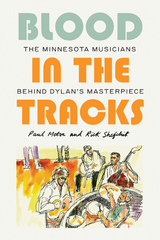 Blood in the Tracks: The Minnesota Musicians behind Dylan's Masterpiece
Paul Metsa
University of Minnesota Press, 2023 The story of the Minneapolis musicians who were unexpectedly summoned to re-record half of the songs on Bob Dylan's most acclaimed album When Bob Dylan recorded Blood on the Tracks in New York in September 1974, it was a great album. But it was not the album now ranked by Rolling Stone as one of the ten best of all time. “When something’s not right, it’s wrong,” as Dylan puts it in “You’re Gonna Make Me Lonesome When You Go”—and something about that original recording led him to a studio in his native Minnesota to re-record five songs, including “Idiot Wind” and “Tangled Up in Blue.” Six Minnesota musicians participated in that two-night recording session at Sound 80, bringing their unique sound to some of Dylan’s best-known songs—only to have their names left off the album and their contribution unacknowledged for more than forty years. This book tells the story of those two nights in Minneapolis, introduces the musicians who gave the album so much of its ultimate form and sound, and describes their decades-long fight for recognition. Blood in the Tracks takes readers behind the scenes with these “mystery” Minnesota musicians: twenty-one-year-old mandolin virtuoso Peter Ostroushko; drummer Bill Berg and bass player Billy Peterson, the house rhythm section at Sound 80; progressive rock keyboardist Gregg Inhofer; guitarist Chris Weber, who owned The Podium guitar shop in Dinkytown; and Kevin Odegard, whose own career as a singer-songwriter had paralleled Dylan’s until he had to take a job as a railroad brakeman to make ends meet. Through in-depth interviews and assiduous research, Paul Metsa and Rick Shefchik trace the twists of fate that brought these musicians together and then set them on different paths in its wake: their musical experiences leading up to the December 1974 recording session, the divergent careers that followed, and the painstaking work required to finally obtain the official credit that they were due. A rare look at the making—or remaking—of an all-time great album, and a long overdue recognition of the musicians who made it happen, Blood in the Tracks brings to life a transformative moment in the history of rock and roll, for the first time in its true context and with its complete cast of players.
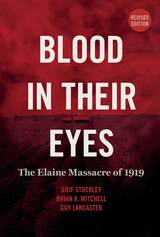 Blood in Their Eyes: The Elaine Massacre of 1919
Grif Stockley
University of Arkansas Press, 2020 On September 30, 1919, local law enforcement in rural Phillips County, Arkansas, attacked black sharecroppers at a meeting of the Progressive Farmers and Household Union of America. The next day, hundreds of white men from the Delta, along with US Army troops, converged on the area “with blood in their eyes.” What happened next was one of the deadliest incidents of racial violence in the history of the United States, leaving a legacy of trauma and silence that has persisted for more than a century. In the wake of the massacre, the NAACP and Little Rock lawyer Scipio Jones spearheaded legal action that revolutionized due process in America.
The first edition of Grif Stockley’s Blood in Their Eyes, published in 2001, brought renewed attention to the Elaine Massacre and sparked valuable new studies on racial violence and exploitation in Arkansas and beyond. With contributions from fellow historians Brian K. Mitchell and Guy Lancaster, this revised edition draws from recently uncovered source material and explores in greater detail the actions of the mob, the lives of those who survived the massacre, and the regime of fear and terror that prevailed under Jim Crow.
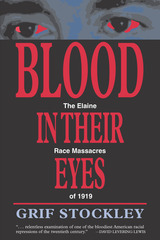 Blood in Their Eyes: The Elaine Race Massacres of 1919
Grif Stockley
University of Arkansas Press, 2016 Winner of the 2002 Booker Worthen Literary Prize American Association of State and Local History Award 2003 In late September 1919, black sharecroppers met to protest unfair settlements for their cotton crops from white plantation owners. Local law enforcement broke up the union's meeting, and the next day a thousand white men from the Delta—and troops of the U.S. Army itself—converged on Phillips County, Arkansas, to "put down" the black sharecroppers' "insurrection." In riveting, novelistic prose, writer and Delta native Grif Stockley considers the evidence and tells the full story of this incident for the first time, concluding that black people were murdered in Elaine by white mobs and federal soldiers. Five white men died as a result of the conflict; contemporary estimates of African American deaths ranged from 20 to an even more horrifying 856. White officials jailed hundreds of black workers, torturing some of them. Twelve black men were charged with first-degree murder. Their legal battles lasted six years, but national and local silence has persisted much longer. Stockley takes on this silence and shows that it resulted from sustained official efforts to convince the public that only blacks who had resisted lawful authority were killed. He shows too that it is part of a larger silence in which the fear and terror that were the daily staples of the African American experience have been summed up all too easily in the term "Jim Crow" in a failure to fully confront the anguish of the period.
 The Blood in Their Veins: The Kimballs, Polygamy, and the Shaping of Mormonism
Kimball, Andrew
Signature Books, 2025 This meticulously documented, deeply engaging book represents a unique approach to Utah and Latter-day Saint history, drawing on previously untapped private letters and diaries of members of the large and widely known polygamist family of the prominent Latter-day Saint leader, Heber C. Kimball. The story includes compelling accounts of Helen Kimball Whitney, who married Joseph Smith polygamously at fourteen and became, according to Emmeline B. Wells, “one of the best known and most estimable women of the Church,” and of her son Orson F. Whitney, who forswore his embrace of reincarnation only six years before his call as an apostle of the Church of Jesus Christ of Latter-day Saints. Another daughter, Alice Kimball Smith, married a man who was tracked to a brothel and arrested for armed robbery and assault in 1883, after which Alice turned to family friend and apostle Joseph F. Smith and became his fifth wife. Heber’s son, J. Golden Kimball, one of the most beloved and colorful personalities in Mormon and Utah history, is brought to life in another sketch. The Kimballs had to navigate the ticklish business of explaining or obfuscating polygamy to disapproving family in the East, including the extended claim by Heber’s wife Christeen to her New Jersey family that she had married a Mr. Chase monogamously. Two of Heber’s sons, both stake presidents, contemplated plural marriage in the first decade of the twentieth century, well after the church publicly disavowed the practice. Additional light is shone on the now-defunct Latter-day Saint practices of adult adoptions and speaking in tongues, Mormon-settler relations with the Utes and Pahvants, the 1856 handcart rescue, the John Hyrum Koyle “Dream Mine,” the Jackson County, Missouri, Temple Lot suit of 1892, and federal pursuit of polygamists.
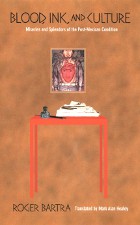 Blood, Ink, and Culture: Miseries and Splendors of the Post-Mexican Condition
Roger Bartra
Duke University Press, 2002 Pens and swords, words and blows: for Roger Bartra, the culture of ink and the culture of blood offer two contrasting approaches to the political transformations of our time. In this compilation of essays, Bartra thinks through these transformations by tracing the complex interplay between popular culture, nationalist ideology, civil society, and the state in contemporary Mexico. Written with verve over a period of twenty years, these essays—most translated into English here for the first time—suggest why Bartra has become one of Latin America’s leading public intellectuals. The essays cover a broad range of topics, from the canonical forms of Mexican culture to the meaning of postnational identity in a globalizing age, from the repercussions of the 1994 Zapatista uprising to the 2000 election of Vicente Fox and the end of the PRI’s seven-decade rule. Across this range of topics, Bartra imparts astute insights into a critical period of transition in Mexican history, stressing throughout the importance of democracy, the complexity of identity, and the vibrancy of the Left. In Blood, Ink, and Culture, he provides a stimulating inside look at political and intellectual life in the southern reaches of North America.
Blood is the Life: Vampires in Literature
Leonard G. Heldreth
University of Wisconsin Press, 1999 Today the vampire is a major cultural icon and can be found in breakfast foods, comics, television, computer games, films, and books from academic studies to best-selling novels. While readers may be familiar with such figures as Dracula and Lestat, few are aware of the range of the vampire legacy that stretches from the early nineteenth century through the end of the twentieth. The essays in this volume use a humanistic viewpoint to explore the evolution and significance of the vampire in literature. Contributors examine—besides Dracula—characters such as Lord Ruthven, Carmilla Karnstein, Stephen King’s Kurt Barlow, Chelsea Quinn Yarbro’s Saint-Germain, and Anne Rice’s recoded vampires. Other authors investigated include George R. R. Martin, Brian Stableford, Kim Newman, Colin Wilson, Poppy Z. Brite, and Tanith Lee.
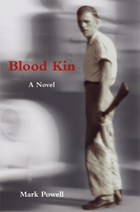 Blood Kin: A Novel
Mark Powell
University of Tennessee Press, 2012 Set in the South Carolina foothills of the Blue Ridge Mountains in the late summer of 1970, Blood Kin tells the story of the Burden family and the community of outcasts that surrounds them. James Burden is the eldest son in the Burden family. A Korean War veteran and former prisoner-of-war, he struggles with inner demons and drug addiction. He has returned home after almost two decades of absence to find his family members consumed with struggles all their own. His former wife is haunted by her thoughts of an unborn child. His brothers, both Vietnam veterans, are troubled by their experiences there. Roy Burden returned a hero, while Enis Burden saw no combat at all. The younger brothers are also dealing with troubles with love and the hopes of starting their own families. James’s father is himself disturbed by his memories of his own father’s dark deeds and death. And James’s mother is plagued by worry for her husband and sons. The Burdens face their struggles within a community of misfits, including a reluctant sheriff, a runaway thief, a forgotten fire-talker, a religious con man and his actress girlfriend, a local apple baron, and a failed prophet. All of them are living on the fringes of a rural South racing toward a middle-class modernity that has little use for any of them. Blood Kin was awarded the 2005 Peter Taylor Prize for the Novel, an award named for one of the South’s most celebrated writers. The annual prize, co-sponsored by the Knoxville Writers’ Guild and the University of Tennessee Press, endeavors to bring to light novels of high literary quality, thereby honoring Peter Taylor’s own practice of assisting writers who care about the craft of fiction.
 The Blood Libel in Medieval Antisemitism
François Soyer
Arc Humanities Press, 2025 The claim that Jews abducted and murdered Christian children for alleged ritual purposes or in order to consume their blood during Passover is the most extreme of all the libels that have been used to attack Jews and present them as an existential threat to Christians. From the twelfth century to the modern era, it has been a staple of extreme antisemitic discourse seeking to dehumanize Jews and rationalize anti-Jewish violence. In the popular mind, “Ritual Murder” and “Blood Libel” have become synonymous but in medieval times they were different accusations with different origins. Why did the accusations appear in some areas and not others? What local factors contributed to accusations receiving support from some religious or lay authorities despite papal condemnation? How have modern historians and sociologists explained the phenomenon? This book offers a critical survey of the child murder libel in medieval Europe as well as an analysis of its history.
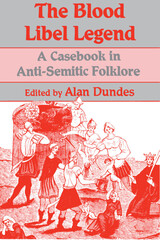 The Blood Libel Legend: A Casebook in Anti-Semitic Folklore
Alan Dundes
University of Wisconsin Press, 1991 Alan Dundes, in this casebook of an anti-Semitic legend, demonstrates the power of folklore to influence thought and history. According to the blood libel legend, Jews murdered Christian infants to obtain blood to make matzah. Dundes has gathered here the work of leading scholars who examine the varied sources and elaborations of the legend. Collectively, their essays constitute a forceful statement against this false accusation.
The legend is traced from the murder of William of Norwich in 1144, one of the first reported cases of ritualized murder attributed to Jews, through nineteenth-century Egyptian reports, Spanish examples, Catholic periodicals, modern English instances, and twentieth-century American cases. The essays deal not only with historical cases and surveys of blood libel in different locales, but also with literary renditions of the legend, including the ballad “Sir Hugh, or, the Jew’s Daughter” and Chaucer’s “The Prioress’s Tale.”
These case studies provide a comprehensive view of the complex nature of the blood libel legend. The concluding section of the volume includes an analysis of the legend that focuses on Christian misunderstanding of the Jewish feast of Purim and the child abuse component of the legend and that attempts to bring psychoanalytic theory to bear on the content of the blood libel legend. The final essay by Alan Dundes takes a distinctly folkloristic approach, examining the legend as part of the belief system that Christians developed about Jews.
This study of the blood libel legend will interest folklorists, scholars of Catholicism and Judaism, and many general readers, for it is both the literature and the history of anti-Semitism.
 Blood Libel: On the Trail of an Antisemitic Myth
Magda Teter
Harvard University Press, 2019 A landmark history of the antisemitic blood libel myth—how it took root in Europe, spread with the invention of the printing press, and persists today.
Accusations that Jews ritually killed Christian children emerged in the mid-twelfth century, following the death of twelve-year-old William of Norwich, England, in 1144. Later, continental Europeans added a destructive twist: Jews murdered Christian children to use their blood. While charges that Jews poisoned wells and desecrated the communion host waned over the years, the blood libel survived.
Initially blood libel stories were confined to monastic chronicles and local lore. But the development of the printing press in the mid-fifteenth century expanded the audience and crystallized the vocabulary, images, and “facts” of the blood libel, providing a lasting template for hate. Tales of Jews killing Christians—notably Simon of Trent, a toddler whose body was found under a Jewish house in 1475—were widely disseminated using the new technology. Following the paper trail across Europe, from England to Italy to Poland, Magda Teter shows how the blood libel was internalized and how Jews and Christians dealt with the repercussions.
The pattern established in early modern Europe still plays out today. In 2014 the Anti-Defamation League appealed to Facebook to take down a page titled “Jewish Ritual Murder.” The following year white supremacists gathered in England to honor Little Hugh of Lincoln as a sacrificial victim of the Jews. Based on sources in eight countries and ten languages, Blood Libel captures the long shadow of a pernicious myth.
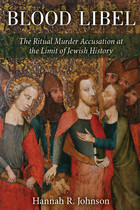 Blood Libel: The Ritual Murder Accusation at the Limit of Jewish History
Hannah R. Johnson
University of Michigan Press, 2012 The ritual murder accusation is one of a series of myths that fall under the label blood libel, and describes the medieval legend that Jews require Christian blood for obscure religious purposes and are capable of committing murder to obtain it. This malicious myth continues to have an explosive afterlife in the public sphere, where Sarah Palin's 2011 gaffe is only the latest reminder of its power to excite controversy. Blood Libel is the first book-length study to analyze the recent historiography of the ritual murder accusation and to consider these debates in the context of intellectual and cultural history as well as methodology. Hannah R. Johnson articulates how ethics shapes methodological decisions in the study of the accusation and how questions about methodology, in turn, pose ethical problems of interpretation and understanding. Examining recent debates over the scholarship of historians such as Gavin Langmuir, Israel Yuval, and Ariel Toaff, Johnson argues that these discussions highlight an ongoing paradigm shift that seeks to reimagine questions of responsibility by deliberately refraining from a discourse of moral judgment and blame in favor of an emphasis on historical contingencies and hostile intergroup dynamics.
 Blood Libels, Hostile Archives: Reclaiming Interrupted Jewish Lives
Magda Teter
Central European University Press, 2025 As a minority group for most of their history, Jews were often marginalized and persecuted. Traces of their lives can be found in the archives of the dominant societies, but only as they intersected with the concerns of those in power. Just as Natalie Zemon Davis, Emmanuel Le Roy Ladurie, Carlo Ginzburg, and others recovered the voices of the peasants, so, too, scholars of Jewish history and culture have productively mined these reservoirs of evidence to retrieve glimpses of the ordinary lives of Jews. Blood Libels, Hostile Archives explores what can be reclaimed about everyday lives from what can be called “hostile archives”—from archival evidence produced and collected explicitly to manufacture malicious tales and pass them as “facts.” For Jewish history, in some places, these archival sources may be the only remaining records documenting the lives of Jews there. The book explores two places: Trent, in northern Italy, and Sandomierz, in eastern Poland. Though hundreds of miles away, the towns have many things in common: both had been sites of anti-Jewish libels falsely accusing Jews of killing Christian children, Trent in 1475 and Sandomierz twice—in 1698 and 1710; in both, the instigators of the Jews’ persecution left unique and extensive archives, both towns have physical remnants of these deadly affairs, and, finally, neither town has an existing Jewish population. Yet, centuries later, these anti-Jewish libels have not been relegated to the past; in both towns, their legacies still reverberate today.
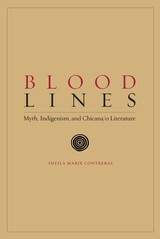 Blood Lines: Myth, Indigenism, and Chicana/o Literature
By Sheila Marie Contreras
University of Texas Press, 2008 2009 — Runner-up, Modern Language Association Prize in United States Latina and Latino and Chicana and Chicano Literary and Cultural Studies Blood Lines: Myth, Indigenism, and Chicana/o Literature examines a broad array of texts that have contributed to the formation of an indigenous strand of Chicano cultural politics. In particular, this book exposes the ethnographic and poetic discourses that shaped the aesthetics and stylistics of Chicano nationalism and Chicana feminism. Contreras offers original perspectives on writers ranging from Alurista and Gloria Anzaldúa to Lorna Dee Cervantes and Alma Luz Villanueva, effectively marking the invocation of a Chicano indigeneity whose foundations and formulations can be linked to U.S. and British modernist writing. By highlighting intertextualities such as those between Anzaldúa and D. H. Lawrence, Contreras critiques the resilience of primitivism in the Mexican borderlands. She questions established cultural perspectives on "the native," which paradoxically challenge and reaffirm racialized representations of Indians in the Americas. In doing so, Blood Lines brings a new understanding to the contradictory and richly textured literary relationship that links the projects of European modernism and Anglo-American authors, on the one hand, and the imaginary of the post-revolutionary Mexican state and Chicano/a writers, on the other hand.
 Blood Loss: A Love Story of AIDS, Activism, and Art
Keiko Lane
Duke University Press, 2024 In 1991, sixteen-year-old activist Keiko Lane joined the Los Angeles chapters of Queer Nation and ACT UP. Their members protested legislation aimed at dismantling rights for LGBTQ people, people living with HIV, and immigrants while fighting for needle-exchange programs, reproductive justice, safer-sex education, hospice funding, and the right to die with dignity. At the same time, the activists were a queer chosen family of friends and lovers who took care of one another in sickness and in health. Sometimes they helped each other die. By the time Lane turned twenty-two, most had died of AIDS. In her evocative memoir, Lane weaves together love stories and afterlives of queer resistance and survival against the landscape of the Rodney King Rebellion, the movement for queer rights, and the censorship of queer artists and sexualities. Lane interrogates the social construction of power against and in queer communities of color and the recovery of sexual agency in the midst and aftermath of violence. Luminous and powerfully moving, Blood Loss explores survival after those we love have died.
Blood Memory
Colleen J. McElroy
University of Pittsburgh Press, 2016 Blood Memory, Colleen J. McElroy's collection of narrative poetry, emerges from deep seated memories with enormous emotion. Through the rhythms and musicality unique to McElroy's voice, it portrays an extended family, a complex culture spanning several decades, multiple victories and failures, and a single brilliant soul that frames the poems. Dedicated to McElroy's mother, the book is universal in its scope, inescapable in its earthy particularity. McElroy writes, “I am the last female of a family/ of women who wove the fabric/ of stories into doilies and slip covers…/" Blood Memory offers consummate storytelling and unforgettable poetry capturing a place and time gone forever. And as an evolving history, the poetry has a cinematic quality, large and intimate and at the same time, characters utterly vivid.
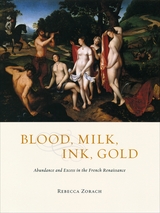 Blood, Milk, Ink, Gold: Abundance and Excess in the French Renaissance
Rebecca Zorach
University of Chicago Press, 2005 Most people would be hard pressed to name a famous artist from Renaissance France. Yet sixteenth-century French kings believed they were the heirs of imperial Rome and commissioned a magnificent array of visual arts to secure their hopes of political ascendancy with images of overflowing abundance. With a wide-ranging yet richly detailed interdisciplinary approach, Rebecca Zorach examines the visual culture of the French Renaissance, where depictions of sacrifice, luxury, fertility, violence, metamorphosis, and sexual excess are central. Zorach looks at the cultural, political, and individual roles that played out in these artistic themes and how, eventually, these aesthetics of exuberant abundance disintegrated amidst perceptions of decadent excess.
Throughout the book, abundance and excess flow in liquids-blood, milk, ink, and gold-that highlight the materiality of objects and the human body, and explore the value (and values) accorded to them. The arts of the lavish royal court at Fontainebleau and in urban centers are here explored in a vibrant tableau that illuminates our own contemporary relationship to excess and desire.
From marvelous works by Francois Clouet to oversexed ornamental prints to Benvenuto Cellini's golden saltcellar fashioned for Francis I, Blood, Milk, Ink, Gold covers an astounding range of subjects with precision and panache, producing the most lucid, well-rounded portrait of the cultural politics of the French Renaissance to date.
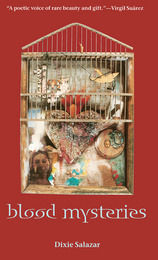 Blood Mysteries
Dixie Salazar
University of Arizona Press, 2003 A Jehovah's Witness is stabbed in her home by a stranger she once allowed in. A homeless woman masturbates on a park bench. A statue of the Virgin Mary, "plaster receptacle of petitions and foolish pleas," is found in a dump, a missing hand suggesting the sound of a one-handed rosary.
Through images brutally honest and disarmingly off-center, Dixie Salazar explores the hidden lives of everyday people, objects, and experiences—and their transformation in the hidden realms of the heart. Charting furious descents into the darkest crevices of our souls, Salazar paints for us a lost city that exists below our mundane consciousness. Blood Mysteries is a tribute to lost souls, from a suicidal mental patient who doesn't believe she exists—"melting out of a landscape spotted with shadows, washing her hands in an empty basin of light"—to Marilyn Monroe, victim even in the morgue. In finely tuned lyricism showing an uncanny grasp of frayed lives, she gives flesh and vitality to women normally encountered only as statistics. The incarcerated, the homeless, the hopeless. Missing young girls who turn up violated and murdered.
Salazar presents us with blood mysteries not only of women, but of family as well. In poems invoking her dual heritage, she explores the identity crises brought on by having a Spanish father and a mother from the deep South, leaving her a product of American meltdown with a predisposition to check "other" for race on applications. "Other can be a place," she reminds us, "a residence for those of us without / papers, where halos of lightning bugs / swarm the rickety family tree." Salazar writes with toughness and grit "for all the shipwrecked saints / and wretches among us." But beneath the surface of words sometimes gritty, sometimes playful, lies a testament to the power of empathy, giving voice to those whose voices have been stifled and offering hope for those who have found none. Blood Mysteries is a forceful prayer for the disenfranchised that offers not merely hope, but transcendence.
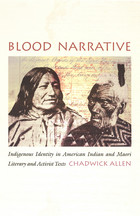 Blood Narrative: Indigenous Identity in American Indian and Maori Literary and Activist Texts
Chadwick Allen
Duke University Press, 2002 Blood Narrative is a comparative literary and cultural study of post-World War II literary and activist texts by New Zealand Maori and American Indians—groups who share much in their responses to European settler colonialism. Chadwick Allen reveals the complex narrative tactics employed by writers and activists in these societies that enabled them to realize unprecedented practical power in making both their voices and their own sense of indigeneity heard.
Allen shows how both Maori and Native Americans resisted the assimilationist tide rising out of World War II and how, in the 1960s and 1970s, they each experienced a renaissance of political and cultural activism and literary production that culminated in the formation of the first general assembly of the World Council of Indigenous Peoples. He focuses his comparison on two fronts: first, the blood/land/memory complex that refers to these groups' struggles to define indigeneity and to be freed from the definitions of authenticity imposed by dominant settler cultures. Allen's second focus is on the discourse of treaties between American Indians and the U.S. government and between Maori and Great Britain, which he contends offers strong legal and moral bases from which these indigenous minorities can argue land and resource rights as well as cultural and identity politics.
With its implicit critique of multiculturalism and of postcolonial studies that have tended to neglect the colonized status of indigenous First World minorities, Blood Narrative will appeal to students and scholars of literature, American and European history, multiculturalism, postcolonialism, and comparative cultural studies.
The Blood of Abraham: Insights into the Middle East
Jimmy Carter
University of Arkansas Press, 2007 In The Blood of Abraham, originally published in 1985 with updates to the afterword in 1993 and 2007, President Carter explains his understanding of the Middle East and seeks to provide an enlightening and reconciling vision for greater peace in the region.
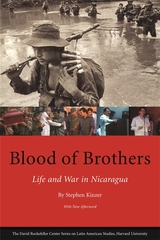 Blood of Brothers: Life and War in Nicaragua, With New Afterword
Stephen Kinzer
Harvard University Press, 2007 In 1976, at age twenty-five, Stephen Kinzer arrived in Nicaragua as a freelance journalist—and became a witness to history. He returned many times during the years that followed, becoming Latin America correspondent for the Boston Globe in 1981 and joining the foreign staff of the New York Times in 1983. That year he opened the New York Times Managua bureau, making that newspaper the first daily in America to maintain a full-time office in Nicaragua.
Widely considered the best-connected journalist in Central America, Kinzer personally met and interviewed people at every level of the Somoza, Sandinistas and contra hierarchies, as well as dissidents, heads of state, and countless ordinary citizens throughout the region.
Blood of Brothers is Kinzer’s dramatic story of the centuries-old power struggle that burst into the headlines in 1979 with the overthrow of the Somoza dictatorship. It is a vibrant portrait of the Nicaraguan people and their volcanic land, a cultural history rich in poetry and bloodshed, baseball and insurrection.
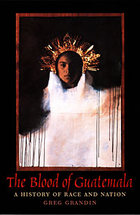 The Blood of Guatemala: A History of Race and Nation
Greg Grandin
Duke University Press, 2000 Over the latter half of the twentieth century, the Guatemalan state slaughtered more than two hundred thousand of its citizens. In the wake of this violence, a vibrant pan-Mayan movement has emerged, one that is challenging Ladino (non-indigenous) notions of citizenship and national identity. In The Blood of Guatemala Greg Grandin locates the origins of this ethnic resurgence within the social processes of eighteenth- and nineteenth-century state formation rather than in the ruins of the national project of recent decades.
Focusing on Mayan elites in the community of Quetzaltenango, Grandin shows how their efforts to maintain authority over the indigenous population and secure political power in relation to non-Indians played a crucial role in the formation of the Guatemalan nation. To explore the close connection between nationalism, state power, ethnic identity, and political violence, Grandin draws on sources as diverse as photographs, public rituals, oral testimony, literature, and a collection of previously untapped documents written during the nineteenth century. He explains how the cultural anxiety brought about by Guatemala’s transition to coffee capitalism during this period led Mayan patriarchs to develop understandings of race and nation that were contrary to Ladino notions of assimilation and progress. This alternative national vision, however, could not take hold in a country plagued by class and ethnic divisions. In the years prior to the 1954 coup, class conflict became impossible to contain as the elites violently opposed land claims made by indigenous peasants.
This “history of power” reconsiders the way scholars understand the history of Guatemala and will be relevant to those studying nation building and indigenous communities across Latin America.
Blood of Mugwump: A Tiresian Tale of Incest
Doug Rice
University of Alabama Press, 1996 Rice's parasitical language is akin to the acts of those naked 18th century pirates of desire. In Blood of Mugwump, Rice cannibalizes the likes of Joyce, Faulkner, Burroughs, Eliot, and a whole host of angelic others. Now trapped inside a kinetic body that is always changing from male to female, Doug Rice (the youngest Mugwump) sets out to discover himself in his sister's body. All the while the familial matriarch, Grandma Mugwump, feeds on the flesh of young Doug. Once through the looking glass, Doug realizes that Caddie (his polysexual Faulknerian nightmare of a sister) is more terrifying and holy than the average saint. A frenzied sexual virus, genetically conveyed, mutates and possesses the meat of Doug's and Caddie's bodies forcing them to love each other in unspeakable, yet classical, ways.
Blood of the Air: Poems
Ama Codjoe
Northwestern University Press, 2020 Blood of the Air creates a new mythology, repurposing spectacle, stereotype, and song. Inspired by the fictions and frictions of the past, each poem in this collection complicates the next. Lush lyrical moments give way to fracture, vulnerability, and reinvention. The title poem—one of several found poems—calls attention to stories told in the wake of sexual violence. In “She Said,” the collection’s longest piece, language culled from the transcript of a seventeenth-century rape trial feels eerily familiar. Formally dexterous and refreshingly bold, the poems in Blood of the Air are urgent, moving, and fiercely imagined. Though blood can flow from the site of a wound, Codjoe seems to say, blood is also a sign of life.
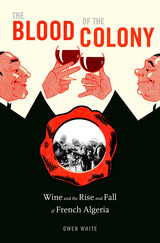 The Blood of the Colony: Wine and the Rise and Fall of French Algeria
Owen White
Harvard University Press, 2020 The surprising story of the wine industry’s role in the rise of French Algeria and the fall of empire.
“We owe to wine a blessing far more precious than gold: the peopling of Algeria with Frenchmen,” stated agriculturist Pierre Berthault in the early 1930s. In the last decades of the nineteenth century, Europeans had displaced Algerians from the colony’s best agricultural land and planted grapevines. Soon enough, wine was the primary export of a region whose mostly Muslim inhabitants didn’t drink alcohol.
Settlers made fortunes while drawing large numbers of Algerians into salaried work for the first time. But the success of Algerian wine resulted in friction with French producers, challenging the traditional view that imperial possessions should complement, not compete with, the metropole. By the middle of the twentieth century, amid the fight for independence, Algerians had come to see the rows of vines as an especially hated symbol of French domination. After the war, Algerians had to decide how far they would go to undo the transformations the colonists had wrought—including the world’s fourth-biggest wine industry. Owen White examines Algeria’s experiment with nationalized wine production in worker-run vineyards, the pressures that resulted in the failure of that experiment, and the eventual uprooting of most of the country’s vines.
With a special focus on individual experiences of empire, from the wealthiest Europeans to the poorest laborers in the fields, The Blood of the Colony shows the central role of wine in the economic life of French Algeria and in its settler culture. White makes clear that the industry left a long-term mark on the development of the nation.
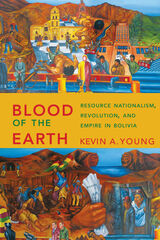 Blood of the Earth: Resource Nationalism, Revolution, and Empire in Bolivia
By Kevin A. Young
University of Texas Press, 2017 Conflicts over subterranean resources, particularly tin, oil, and natural gas, have driven Bolivian politics for nearly a century. “Resource nationalism”—the conviction that resource wealth should be used for the benefit of the “nation”—has often united otherwise disparate groups, including mineworkers, urban workers, students, war veterans, and middle-class professionals, and propelled an indigenous union leader, Evo Morales, into the presidency in 2006. Blood of the Earth reexamines the Bolivian mobilization around resource nationalism that began in the 1920s, crystallized with the 1952 revolution, and continues into the twenty-first century. Drawing on a wide array of Bolivian and US sources, Kevin A. Young reveals that Bolivia became a key site in a global battle among economic models, with grassroots coalitions demanding nationalist and egalitarian alternatives to market capitalism. While US-supported moderates within the revolutionary regime were able to defeat more radical forces, Young shows how the political culture of resource nationalism, though often comprising contradictory elements, constrained government actions and galvanized mobilizations against neoliberalism in later decades. His transnational and multilevel approach to the 1952 revolution illuminates the struggles among Bolivian popular sectors, government officials, and foreign powers, as well as the competing currents and visions within Bolivia’s popular political cultures. Offering a fresh appraisal of the Bolivian Revolution, resource nationalism, and the Cold War in Latin America, Blood of the Earth is an ideal case study for understanding the challenges shared by countries across the Global South.
The Blood of the Lamb: A Novel
Peter De Vries
University of Chicago Press, 2005
One of John Green's "favorite books ever," a powerful, moving novel of family, parenthood, and loss
The most poignant of all Peter De Vries's novels, The Blood of the Lamb is also the most autobiographical. It follows the life of Don Wanderhop from his childhood in an immigrant Calvinist family living in Chicago in the 1950s through the loss of a brother, his faith, his wife, and finally his daughter-a tragedy drawn directly from De Vries's own life. Despite its foundation in misfortune, The Blood of the Lamb offers glimpses of the comic sensibility for which De Vries was famous. Engaging directly with the reader in a manner that buttresses the personal intimacy of the story, De Vries writes with a remarkableblend of grief, love, wit, and fury.
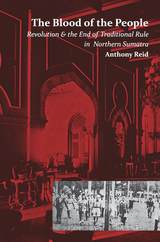 The Blood of the People: Revolution and the End of Traditional Rule in Northern Sumatra
Anthony Reid
National University of Singapore Press, 2014 In northern Sumatra, as in Malaya, colonial rule embraced an extravagant array of sultans, rajas, datuks and ulèëbalangs. In Malaya the traditional Malay elite served as a barrier to revolutionary change and survived the transition to independence, but in Sumatra a wave of violence and killing wiped out the traditional elite in 1945‒46. Anthony Reid’s The Blood of the People, now available in a new edition, explores the circumstances of Sumatra’s sharp break with the past during what has been labelled its “social revolution”.
The events in northern Sumatra were among the most dramatic episodes of Indonesia’s national revolution, and brought about more profound changes even than in Java, from where the revolution is normally viewed. Some ethnic groups saw the revolution as a popular, peasant-supported movement that liberated them from foreign rule. Others, though, felt victimised by a radical, levelling agenda imposed by outsiders. Java, with a relatively homogeneous population, passed through the revolution without significant social change. The ethnic complexity of Sumatra, in contrast, meant that the revolution demanded an altogether new “Indonesian” identity to override the competing ethnic categories of the past.
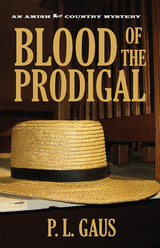 Blood of the Prodigal: An Amish Country Mystery
P. L. Gaus
Ohio University Press, 1999 P. L. Gaus’s Blood of the Prodigal, a mystery in the tradition of Tony Hillerman, is back in a new edition, including an exclusive interview with the author, discussion questions for reading groups, and a detailed map and driving guide to Holmes County, Ohio, with everything one needs to visit the iconic scenes depicted in the story. In Holmes County, Ohio—home to the largest Amish and Mennonite settlements in the world—mystery and foreboding lurk in the quiet Old Order Amish community led by Bishop Eli Miller. The illusion of peace is shattered one early morning when a young Amish boy goes missing—abducted from his home and from Bishop Miller’s care. At first, the bishop suspects the child’s father, who was exiled from the Old Order ten years ago, but a murder soon casts doubt on the bishop’s theory. With a strong distrust of law enforcement and the modern “English” ways, the bishop must put his faith in an unlikely partnership with Professor Michael Branden before it’s too late. With the help of the peaceful pastor Cal Troyer and the reckless Sheriff Bruce Robertson, Branden plunges headlong into the closed culture to unravel the mystery of the missing child and uncover truths many would prefer to leave undisturbed.
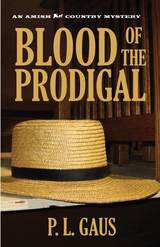 Blood of the Prodigal: An Amish Country Mystery
P. L. Gaus
Ohio University Press, 1999 P. L. Gaus’s Blood of the Prodigal, a mystery in the tradition of Tony Hillerman, is back in a new edition, including an exclusive interview with the author, discussion questions for reading groups, and a detailed map and driving guide to Holmes County, Ohio, with everything one needs to visit the iconic scenes depicted in the story. In Holmes County, Ohio—home to the largest Amish and Mennonite settlements in the world—mystery and foreboding lurk in the quiet Old Order Amish community led by Bishop Eli Miller. The illusion of peace is shattered one early morning when a young Amish boy goes missing—abducted from his home and from Bishop Miller’s care. At first, the bishop suspects the child’s father, who was exiled from the Old Order ten years ago, but a murder soon casts doubt on the bishop’s theory. With a strong distrust of law enforcement and the modern “English” ways, the bishop must put his faith in an unlikely partnership with Professor Michael Branden before it’s too late. With the help of the peaceful pastor Cal Troyer and the reckless Sheriff Bruce Robertson, Branden plunges headlong into the closed culture to unravel the mystery of the missing child and uncover truths many would prefer to leave undisturbed.
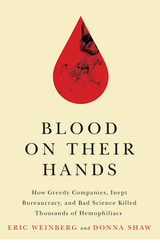 Blood on Their Hands: How Greedy Companies, Inept Bureaucracy, and Bad Science Killed Thousands of Hemophiliacs
Weinberg, Eric
Rutgers University Press, 2017 A few short years after HIV first entered the world blood supply in the late 1970s and early 1980s, over half the hemophiliacs in the United States were infected with the virus. But this was far more than just an unforeseeable public health disaster. Negligent doctors, government regulators, and Big Pharma all had a hand in this devastating epidemic.
Blood on Their Hands is an inspiring, firsthand account of the legal battles fought on behalf of hemophiliacs who were unwittingly infected with tainted blood. As part of the team behind the key class action litigation filed by the infected, young New Jersey lawyer Eric Weinberg was faced with a daunting task: to prove the negligence of a powerful, well-connected global industry worth billions. Weinberg and journalist Donna Shaw tell the dramatic story of how idealistic attorneys and their heroic, mortally-ill clients fought to achieve justice and prevent further infections. A stunning exposé of one of the American medical system’s most shameful debacles, Blood on Their Hands is a rousing reminder that, through perseverance, the victims of corporate greed can sometimes achieve great victory.
Blood Orchid: An Unnatural History of America
By Charles Bowden, Foreword by William Langewiesche
University of Texas Press, 2018 Through stark observations and visceral experiences, Blood Orchid begins Charles Bowden’s dizzying excavation of the brutal, systemic violence and corruption at the roots of American society. Like a nightmarish fever dream that turns out to be our own reality, Bowden visits dying friends in skid row apartments in Los Angeles, traverses San Francisco byways lined with clubs and joints, and roams through village bars and streets in the Sierra Madre mountains. In these wanderings resides a yearning for the understanding of past and present sins, the human penchant for warfare, abuse, and oppression, and the true war between humanity, the industrialized world, and the immense tolls of our shared land. Deeply personal, hauntingly prophetic, and bracingly sharp, the start to Bowden’s harrowed quest to unearth our ugly truths remains strikingly poignant today.
Blood Pact and Other Stories
Mario Benedetti
Northwestern University Press, 1997 This collection includes the best of renowned Uruguayan writer Mario Benedetti's stories from over 40 years of publishing. In these stories of powerful sudden impact, Benedetti plumbs with deep psychological insight both the dreams and frustrations of the middle-class in a bureaucratic society, as well as the pain and disorientation of political exile.
Blood Pages
George Bilgere
University of Pittsburgh Press, 2018 In Blood Pages George Bilgere continues his exploration of the joys and absurdities of being middle-aged and middle-class in the Midwest. OK, maybe he’s a bit beyond middle-aged at this point, and his rueful awareness of this makes these poems even more darkly hilarious, more deeply aware of the feckless and baffling times our nation has stumbled into. And the fact that Bilgere, relatively late in life, is now the father of two young boys brings a fresh sense of urgency to his work. Blood Pages is a guidebook to the fears, foibles, and beauties of our lovely old country as it makes its blundering, tentative way into the new century.
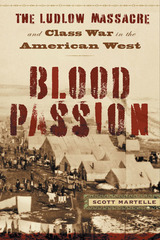 Blood Passion: The Ludlow Massacre and Class War in the American West, First Paperback Edition
Scott Martelle
Rutgers University Press, 2008 By early April 1914, Colorado Governor Elias Ammons thought the violence in his state’s strike-bound southern coal district had eased enough that he could begin withdrawing the Colorado National Guard, deployed six months earlier as military occupiers. But Ammons misread the signals, and on April 20, 1914, a full-scale battle erupted between the remaining militiamen and armed strikers living in a tent colony at the small railroad town of Ludlow. Eight men were killed in the fighting, which culminated in the burning of the colony. The next day, the bodies of two women and eleven children were found suffocated in a below-ground shelter. The “Ludlow Massacre,” as it quickly became known, launched a national call-to-arms for union supporters to join a ten-day guerrilla war along more than two hundred miles of the eastern Rockies. The convulsion of arson and violence killed more than thirty people and didn’t end until President Woodrow Wilson sent in the U.S. Army. Overall at least seventy-five men, women, and children were killed in seven months, likely the nation’s deadliest labor struggle.
In Blood Passion, journalist Scott Martelle explores this little-noted tale of political corruption and repression and immigrants’ struggles against dominant social codes of race, ethnicity, and class. More than a simple labor dispute, the events surrounding Ludlow embraced some of the most volatile social movements of the early twentieth century, pitting labor activists, socialists, and anarchists against the era’s powerful business class, including John D. Rockefeller, Jr., and helped give rise to the modern twins of corporate public relations and political “spin.” But at its heart, Blood Passion is the dramatic story of small lives merging into a movement for change and of the human struggle for freedom and dignity.
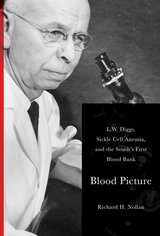 Blood Picture: L. W. Diggs, Sickle Cell Anemia, and the South's First Blood Bank
Richard Nollan
University of Tennessee Press, 2016
"L. W. Diggs was a pioneer in sickle cell disease research. He was there almost from the beginning when SCD was introduced to Western medicine in 1910, and Diggs’s contributions to SCD knowledge and the insights into SCD history through his life story merit recognition.”
—Todd L. Savitt, author of Medicine and Slavery: The Diseases and Health Care of Blacks in Antebellum Virginia
In 1929, Lemuel Whitley Diggs arrived in Memphis as a newly minted physician from the Johns Hopkins University School of Medicine. Rather than establish a private practice, which would have been a lucrative endeavor in a modern city such as Memphis, Diggs took a position as one of the first full-time faculty members with the University of Tennessee Medical Units, a position that afforded Diggs access to both patient care and clinical research, and a decision that would later define his career. As part of his position, Diggs saw patients at the Memphis City Hospital, a poor, inner-city facility constrained by Jim Crow laws and racial bias. He immediately recognized a high rate of sickle cell disease among his patients, a disease Diggs had been taught was rare and one laden with negative racial attributes. Diggs’s study of sickle cell disease would lead him to confront medical racism, establish the South’s first blood blank and the nation’s first sickle cell center, and help define the mission of St. Jude Children’s Research Hospital.
Essentially a biography of Diggs, Blood Picture relates the life of a physician and intellectual with strong convictions and medically forward thinking. Diggs’s career spanned the Great Depression, World War II, and the civil rights movement, and he pushed the limits of medicine and sicklecell research in times of turbulent social change. His life reveals the consciousness of the South as seen through the profession he admired and loved.
RICHARD H. NOLLAN is an associate professor and head of the Research and Learning Services at the University of Tennessee Health Science Center in Memphis. He helped produce a digital retrospective on sickle cell anemia entitled Sickle Cell Disease: Photographs and Photomicrographs from 60 Years of Study.
Blood Prism
Edward Haworth Hoeppner
Ohio State University Press, 2011 The poems in Blood Prism span a lifetime. Its three sections, “Memory,” “Politics,” and “Age,” frame meditations on a violence-blotched world with reflections on the author’s childhood and conclusions about a decades-long life of writing. “I’m 60 and still . . . alive in this world, with love and with its palindrome,” one poem says. And the argument of the book turns on that precise puzzle: on evol, invoking as it does both evil and evolve, both human wrong and life as something more than mere survival. In a variety of styles—prose poems, standard and dislocated forms—Hoeppner uses “blood” to represent family and history, his surprising and richly imagistic language rendering the emptiness he calls imagination “into remains. Into what persists.”
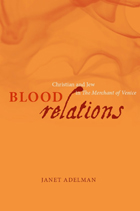 Blood Relations: Christian and Jew in The Merchant of Venice
Janet Adelman
University of Chicago Press, 2008 In Blood Relations, Janet Adelman confronts her resistance to The Merchant of Venice as both a critic and a Jew. With her distinctive psychological acumen, she argues that Shakespeare’s play frames the uneasy relationship between Christian and Jew specifically in familial terms in order to recapitulate the vexed familial relationship between Christianity and Judaism.
Adelman locates the promise—or threat—of Jewish conversion as a particular site of tension in the play. Drawing on a variety of cultural materials, she demonstrates that, despite the triumph of its Christians, The Merchant of Venice reflects Christian anxiety and guilt about its simultaneous dependence on and disavowal of Judaism. In this startling psycho-theological analysis, both the insistence that Shylock’s daughter Jessica remain racially bound to her father after her conversion and the depiction of Shylock as a bloody-minded monster are understood as antidotes to Christian uneasiness about a Judaism it can neither own nor disown.
In taking seriously the religious discourse of The Merchant of Venice, Adelman offers in Blood Relations an indispensable book on the play and on the fascinating question of Jews and Judaism in Renaissance England and beyond.
Blood Relations: Transfusion and the Making of Human Genetics
Jenny Bangham
University of Chicago Press, 2020 Blood is messy, dangerous, and charged with meaning. By following it as it circulates through people and institutions, Jenny Bangham explores the intimate connections between the early infrastructures of blood transfusion and the development of human genetics. Focusing on mid-twentieth-century Britain, Blood Relations connects histories of eugenics to the local politics of giving blood, showing how the exchange of blood carved out networks that made human populations into objects of medical surveillance and scientific research. Bangham reveals how biology was transformed by two world wars, how scientists have worked to define racial categories, and how the practices and rhetoric of public health made genetics into a human science. Today, genetics is a powerful authority on human health and identity, and Blood Relations helps us understand how this authority was achieved.
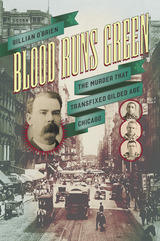 Blood Runs Green: The Murder That Transfixed Gilded Age Chicago
Gillian O'Brien
University of Chicago Press, 2015 The dramatic story of a Gilded Age murder that shocked people from Chicago to Ireland
It was the biggest funeral Chicago had seen since Lincoln’s. On May 26, 1889, four thousand mourners proceeded down Michigan Avenue, followed by a crowd forty thousand strong, in a howl of protest at what commentators called one of the ghastliest and most curious crimes in civilized history. The dead man, Dr. P. H. Cronin, was a respected Irish physician, but his brutal murder uncovered a web of intrigue, secrecy, and corruption that stretched across the United States and far beyond.
Blood Runs Green tells the story of Cronin’s murder from the police investigation to the trial. It is a story of hotheaded journalists in pursuit of sensational crimes, of a bungling police force riddled with informers and spies, and of a secret revolutionary society determined to free Ireland but succeeding only in tearing itself apart. It is also the story of a booming immigrant population clamoring for power at a time of unprecedented change.
From backrooms to courtrooms, historian Gillian O’Brien deftly navigates the complexities of Irish Chicago, bringing to life a rich cast of characters and tracing the spectacular rise and fall of the secret Irish American society Clan na Gael. She draws on real-life accounts and sources from the United States, Ireland, and Britain to cast new light on Clan na Gael and reveal how Irish republicanism swept across the United States. Destined to be a true crime classic, Blood Runs Green is an enthralling tale of a murder that captivated the world and reverberated through society long after the coffin closed.
Blood, Sparrows and Sparrows
Eugenia Leigh
Four Way Books, 2014 “Everyone warns us off the rocks. / But what will keep us from the river?” Leigh asks in her debut collection, which pieces together a kind of mythology in which the surreal and celestial coexist with the realities of childhood abuse as an adult speaker grapples with its lasting emotional trauma. Rooted in a place of deep faith and bottomless compassion, Leigh’s speaker struggles to remember, and to remind us all, “that to worship is to survive is to be / wholly human.”
Blood, Sweat, and Fear: Violence at Work in the North American Auto Industry, 1960-80
Jeremy Milloy
University of Illinois Press, 2017 Going postal. We hear the chilling phrase and think of the rogue employee who snaps. But Blood, Sweat, and Fear shows that on-the-job bloodshed never occurs in isolation. Using violence as a lens, Jeremy Milloy provides fresh insights into the everyday workings of capitalism, class conflict, race, and gender in the United States and Canada. The result is a study that reveals the workplace as a battleground--one that saw a late-century paradigm shift from the collective violence of strikes and riots to the individualized violence of assaults and shootings. Explosive and original, Blood, Sweat, and Fear brings historical perspective to contemporary debates about North American workplace violence.
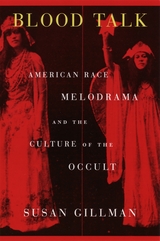 Blood Talk: American Race Melodrama and the Culture of the Occult
Susan Gillman
University of Chicago Press, 2003 The United States has seldom known a period of greater social and cultural volatility, especially in terms of race relations, than the years from the end of Reconstruction to the First World War. In this highly original study, Susan Gillman explores the rise during this period of a remarkable genre—the race melodrama—and the way in which it converged with literary trends, popular history, fringe movements, and mainstream interest in supernatural phenomena.
Blood Talk shows how race melodrama emerged from abolitionist works such as Uncle Tom's Cabin and surprisingly manifested itself in a set of more aesthetically and politically varied works, such as historical romances, sentimental novels, the travel literature of Mark Twain, the regional fiction of Kate Chopin and George Washington Cable, and the work of W. E. B. Du Bois. Gillman then uses the race melodrama to show how racial discourses in the United States have been entangled with occultist phenomena, from the rituals of the Ku Klux Klan and the concept of messianic second-sight to the production of conspiracy theories and studies of dreams and trances.
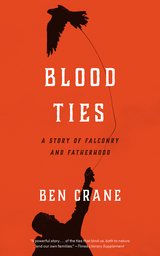 Blood Ties: A Story of Falconry and Fatherhood
Ben Crane
University of Chicago Press, 2020 Raised in rural England before the rise of the internet, Ben Crane grew up in the company of wild things, with hawks and other birds of prey alive in his mind—and woods and fields—as symbols of a kind of self-possessed, solitary power. He spent time with them, knew them, and loved them. But as Crane grew into adulthood, situations that may seem to many of us natural, or even comforting, were challenging: he found it difficult to be around other people and to read social cues, sometimes retreating in fear or lashing out in misunderstanding. Eventually, he was diagnosed as being on the autism spectrum. When Crane became a father, these challenges became unbearable, and he fled to isolation. Hawks brought him back.
In this artful and moving memoir, we follow Crane on his remarkable journey of flight and return. Traveling from the United Kingdom to Pakistan, we learn first about the history and practice of falconry, a beautiful and brutal partnership between humans and birds that has persisted for thousands of years. And as Crane’s personal story unfolds, we come to understand how he found solace and insight through his relationships with these animals. “I saw that my feelings toward nature, and birds of prey in particular, ran in parallel with my feelings for my son,” Crane writes. “I worked out that they were, in fact, two sides of the same coin—the deep love of one could, with gentle observation, inform and unlock the deep love for the other. . . . Perhaps this then is the central theme of my story.”
Many of us rely upon animal companions to provide a sense of joy, compassion, and empathy. But as Blood Ties teaches us, our relationships with the creatures among us can also transform us, illuminating what it means both to be human and to be part of the greater wild—what it means to be alive.
Blood Work
Matthew Siegel
University of Wisconsin Press, 2015 Blood Work reveals what happens to the self when the body is compromised by illness. These poems explore the struggle to remain whole in the shadow of Crohn’s disease and to make a home for oneself in the body and in the world.
Finalist, Poetry, Foreword Reviews IndieFab Book of the Year Awards
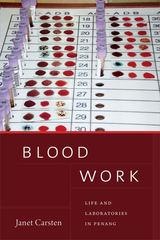 Blood Work: Life and Laboratories in Penang
Janet Carsten
Duke University Press, 2019 What is blood? How can we account for its enormous range of meanings and its extraordinary symbolic power? In Blood Work Janet Carsten traces the multiple meanings of blood as it moves from donors to labs, hospitals, and patients in Penang, Malaysia. She tells the stories of blood donors, their varied motivations, and the paperwork, payment, and other bureaucratic processes involved in blood donation, tracking the interpersonal relations between lab staff and revealing how their work with blood reflects the social, cultural, and political dynamics of modern Malaysia. Carsten follows hospital workers into factories and community halls on blood drives and brings readers into the operating theater as a machine circulates a bypass patient's blood. Throughout, she foregrounds blood's symbolic power, uncovering the processes that make the hospital, the blood bank, the lab, and science itself work. In this way, blood becomes a privileged lens for understanding the entanglements of modern life.
 The Blood-Dimmed Tide: Central Europe’s Long Great War, 1905–1921
Jesse Kauffman
Harvard University Press An expansive narrative of World War I’s Eastern Front challenges longstanding analytical frameworks, offering a novel and far-reaching explanation for the emergence of new nation-states from the wreckage of Europe’s land empires.
In August 1914, Germany, Austria, and Russia sent millions of soldiers hurtling toward one another across the volatile borderlands of Central Europe. The early battles produced appalling casualties but no decisive triumphs; the Great War’s Eastern Front would remain a cauldron of death and destruction for years. And unlike in western Europe, the killing would not end in 1918. With the collapse of the three empires, the front dissolved into a series of overlapping civil, international, and revolutionary wars that would continue for several years more.
The connections among prewar, wartime, and postwar events in Central Europe are so strong, argues Jesse Kauffman, that we should analyze the conflict there in new chronological terms: starting with the Russian Revolution in1905 and continuing until at least the 1921 Treaty of Riga. In particular, The Blood-Dimmed Tide shows that the emergence of sovereign nation-states in postwar Central Europe was neither the inevitable triumph of long-thwarted national ambitions nor a wholly contingent, unforeseeable outcome of the war. Rather, modern states emerged from a conscious decision taken by all the belligerents to encourage the nationalist aspirations of imperial subjects in their enemies’ territories.
Indeed, the repercussions of Central Europe’s long Great War can be felt all the way to today’s conflict in Ukraine. It might be time to retire Eric Hobsbawm’s famous notion of the “short twentieth century”—1914 to 1991—and to consider instead that the twentieth century has not yet drawn to a close.
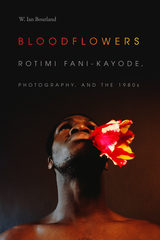 Bloodflowers: Rotimi Fani-Kayode, Photography, and the 1980s
W. Ian Bourland
Duke University Press, 2019 In Bloodflowers W. Ian Bourland examines the photography of Rotimi Fani-Kayode (1955–1989), whose art is a touchstone for cultural debates surrounding questions of gender and queerness, race and diaspora, aesthetics and politics, and the enduring legacy of slavery and colonialism. Born in Nigeria, Fani-Kayode moved between artistic and cultural worlds in Washington, DC, New York, and London, where he produced the bulk of his provocative and often surrealist and homoerotic photographs of black men. Bourland situates Fani-Kayode's work in a time of global transition and traces how it exemplified and responded to profound social, cultural, and political change. In addition to his formal analyses of Fani-Kayode's portraiture, Bourland outlines the important influence that surrealism, neo-Romanticism, Yoruban religion, the AIDS crisis, experimental film, loft culture, and house and punk music had on Fani-Kayode's work. In so doing, Bourland offers new perspectives on a pivotal artist whose brief career continues to resonate with deep aesthetic and social meaning.
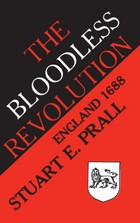 The Bloodless Revolution: England, 1688
Stuart E. Prall
University of Wisconsin Press, 1985 The Glorious Revolution of 1688 represented a crucial turning point in modern British history by decisively shifting political power from the monarchy to Parliament. In this cogent study, first published in 1972, Stuart Prall offers a well-balanced account of the Revolution, its roots, and its consequences. The events of 1688, Prall argues, cannot be viewed in isolation. Examining the tempestuous half-century that preceded and precipitated William and Mary’s accession, he provides a comprehensive overview of the Revolution’s context and of its historical meaning.
“[Prall] insists that the Revolution of 1688 was the culmination of a long crisis begun back in 1640, and the revolution settlement was the resolution of problems which the Puritan Revolution and the Restoration had left unsolved. This is an admirable combination of analysis, commentary upon views of historians, and chronological narrative, starting with the Restoration in 1660 and continuing through the Act of Settlement in 1701.”—Choice
Bloodletting
Kimberly Reyes
Omnidawn, 2025 Poetry that considers the nature of relationships in an age mediated by social media and impacted by violence.
This is a collection of poems about how we find and cultivate love amid wars, including wars that often go ignored. Throughout Bloodletting, Kimberly Reyes considers how we define love and who gets to experience it, paying special attention to the ways that race and sex influence how we are perceived and valued by society. Through the voice of a Black woman coming to terms with her own perspectives on relationship-building, Reyes shows the damage that contemporary culture can do to women, and Black women in particular. Resisting passivity, Reyes’s poetry cuts through pervasive doom scrolling, virtue signaling, and parasocial relationships, inviting readers to remember what care is really supposed to feel like.
Bloodlines: Odyssey of a Native Daughter
Janet Campbell Hale
University of Arizona Press, 1998 These autobiographical essays by a member of the Coeur d'Alene tribe interweave personal experiences with striking portraits of relatives, both living and dead, to form a rich tapestry of history, storytelling, and remembrance. Hale's is a story of intense and resonant beauty. Breathtaking in its range and authority, Bloodlines is an important addition to the literature of women of color.
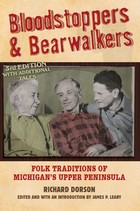 Bloodstoppers and Bearwalkers: Folk Traditions of Michigan’s Upper Peninsula
Richard M. Dorson
University of Wisconsin Press, 2008 Remote and rugged, Michigan’s Upper Peninsula (fondly known as “the U.P.”) has been home to a rich variety of indigenous peoples and Old World immigrants—a heritage deeply embedded in today’s “Yooper” culture. Ojibwes, French Canadians, Finns, Cornish, Poles, Italians, Slovenians, and others have all lived here, attracted to the area by its timber, mineral ore, and fishing grounds. Mixing local happenings with supernatural tales and creatively adapting traditional stories to suit changing audiences, the diverse inhabitants of the U.P. have created a wealth of lore populated with tricksters, outlaws, cunning trappers and poachers, eccentric bosses of the mines and lumber camps, “bloodstoppers” gifted with the lifesaving power to stop the flow of blood, “bearwalkers” able to assume the shape of bears, and more. For folklorist Richard M. Dorson, who ventured into the region in the late 1940s, the U.P. was a living laboratory, a storyteller’s paradise. Bloodstoppers and Bearwalkers, based on his extensive fieldwork in the area, is his richest and most enduring work. This new edition, with a critical introduction and an appendix of additional tales selected by James P. Leary, restores and expands Dorson’s classic contribution to American folklore. Engaging and well informed, the book presents and ponders the folk narratives of the region’s loggers, miners, lake sailors, trappers, and townsfolk. Unfolding the variously peculiar and raucous tales of the U.P., Bloodstoppers and Bearwalkers reveals a vital component of Upper Midwest culture and a fascinating cross-section of American society.
 Bloodstoppers and Bearwalkers: Folk Traditions of the Upper Peninsula
Richard M. Dorson
Harvard University Press Folklore as it comes from the mouths of living storytellers has a matchless authority and conviction. Richard Dorson, living for five months among the Indians, Finns, Canadiens, Cornishmen, lumberjacks, sailors, miners, and sagamen of the Upper Peninsula of Michigan, has listened to their tales, which this book reproduces with all their native thunder and salt. With this lively evidence he proves that America still has its myth-makers and purveyors of myth, who represent, both ethnically and historically, an enormous range of traditional oral folklore.
We meet the Chippewa and Potawatomi Indians, who tell their own heroic versions of the wars with the white men, and whose chief delight is to relate the adventures of the folk hero, Winabijou. For them, as for the French-Canadians and Finns, magical beliefs have been part of their daily education and entertainment. Each group has its own version of European folk tales: the old fairy stories find new form as dragons are conquered with razors and soap, and giants talk in the idiom of the backwoods and pioneer towns.
Some of these myths center around imaginary and semi-imaginary folk heroes; others spring from local politics, and even more from local occupations. The woods tales of lumberjacks, the tragic mysteries of the mines, the weird adventures on the Lakes, each kind of tale has its representative teller. Sometimes the raconteur's most exciting fables concern his own wonderful exploits—with women, drink, and wicked employers. Rooted deep in storytelling tradition, these tales hark back to the frontier and immigrant past of an America shaped by many peoples with extraordinary experiences.
Mr. Dorson provides, in his introduction, a simple account of the idea behind the book and his methods of procuring the tales, in concise and closely written notes at the end of the book he furnishes annotations to the tales which should satisfy and stimulate every folklorist, professional or otherwise. Mr. Dorson did much of the fieldwork for this book under a Library of Congress Fellowship; he has also held a Harvard Sheldon Traveling Fellowship, a Guggenheim Fellowship, and a Faculty Study Fellowship from the American Council of Learned Societies.
Bloodsucking Witchcraft: An Epistemological Study of Anthropomorphic Supernaturalism in Rural Tlaxcala
Hugo G. Nutini
University of Arizona Press, 1993 In the rural areas of south-central Mexico, there are believed to be witches who transform themselves into animals in order to suck the blood from the necks of sleeping infants. This book analyzes beliefs held by the great majority of the population of rural Tlaxcala a generation ago and chronicles its drastic transformation since then.
"The most comprehensive statement on this centrally important ethnographic phenomenon in the last forty years. It bears ready comparison with the two great classics, Evans-Pritchard's Witchcraft Among the Azande and Clyde Kluckhohn's Navaho Witchcraft."—Henry H. Selby
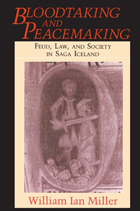 Bloodtaking and Peacemaking: Feud, Law, and Society in Saga Iceland
William Ian Miller
University of Chicago Press, 1990 Dubbed by the New York Times as "one of the most sought-after legal academics in the county," William Ian Miller presents the arcane worlds of the Old Norse studies in a way sure to attract the interest of a wide range of readers. Bloodtaking and Peacemaking delves beneath the chaos and brutality of the Norse world to discover a complex interplay of ordering and disordering impulses. Miller's unique and engaging readings of ancient Iceland's sagas and extensive legal code reconstruct and illuminate the society that produced them.
People in the saga world negotiated a maze of violent possibility, with strategies that frequently put life and limb in the balance. But there was a paradox in striking the balance—one could not get even without going one better. Miller shows how blood vengeance, law, and peacemaking were inextricably bound together in the feuding process.
This book offers fascinating insights into the politics of a stateless society, its methods of social control, and the role that a uniquely sophisticated and self-conscious law played in the construction of Icelandic society.
"Illuminating."—Rory McTurk, Times Literary Supplement
"An impressive achievement in ethnohistory; it is an amalgam of historical research with legal and anthropological interpretation. What is more, and rarer, is that it is a pleasure to read due to the inclusion of narrative case material from the sagas themselves."—Dan Bauer, Journal of Interdisciplinary History
The Bloodworth Orphans
Leon Forrest
University of Chicago Press, 2001 Leon Forrest, acclaimed author of Divine Days, uses a remarkable verbal intensity to evoke human tragedy, injustice, and spirituality in his writing. As Toni Morrison has said, "All of Forrest's novels explore the complex legacy of Afro-Americans. Like an insistent tide this history . . . swells and recalls America's past. . . . Brooding, hilarious, acerbic and profoundly valued life has no more astute observer than Leon Forrest." All of that is on display here in a novel that give readers a breathtaking view of the human experience, filled with humor and pathos.
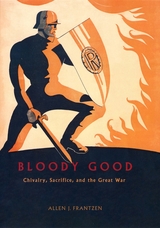 Bloody Good: Chivalry, Sacrifice, and the Great War
Allen J. Frantzen
University of Chicago Press, 2003 In the popular imagination, World War I stands for the horror of all wars. The unprecedented scale of the war and the mechanized weaponry it introduced to battle brought an abrupt end to the romantic idea that soldiers were somehow knights in shining armor who always vanquished their foes and saved the day. Yet the concept of chivalry still played a crucial role in how soldiers saw themselves in the conflict.
Here for the first time, Allen J. Frantzen traces these chivalric ideals from the Great War back to their origins in the Middle Ages and shows how they resulted in highly influential models of behavior for men in combat. Drawing on a wide selection of literature and images from the medieval period, along with photographs, memorials, postcards, war posters, and film from both sides of the front, Frantzen shows how such media shaped a chivalric ideal of male sacrifice based on the Passion of Jesus Christ. He demonstrates, for instance, how the wounded body of Christ became the inspiration for heroic male suffering in battle. For some men, the Crucifixion inspired a culture of revenge, one in which Christ's bleeding wounds were venerated as badges of valor and honor. For others, Christ's sacrifice inspired action more in line with his teachings—a daring stay of hands or reason not to visit death upon one's enemies.
Lavishly illustrated and eloquently written, Bloody Good will be must reading for anyone interested in World War I and the influence of Christian ideas on modern life.
 Bloody Numbers: The Early Atlantic Slave Trade and the Invention of Modern Corporeality
Pablo F. Gómez
University of Chicago Press Upends current thinking about how early modern people started to conceptualize human beings in terms of populations.
Bloody Numbers is a provocative account of the violent world of the sixteenth and early seventeenth-century South Atlantic slave-trading societies, where traders, officials, notaries, and ship captains began thinking about human bodies as aggregate populations understood through numbers: measurements, averages, and calculations of risk and value assessed through the tabulation of heights, weights, tumors, scars, and other characteristics. Pablo F. Gómez explores how figures within the Spanish, Portuguese, and African slave trades used this model for understanding human bodies to generalize about behavior and disease in ways that foreshadowed the work of modern epidemiologists and public health officials—though they employed their probabilities with the brutal aim of protecting their financial interests rather than caring for enslaved people. The ruthlessness inherent in these practices became ingrained in the modern corporeal mathematics that emerged from the early slave trade and diffused through its vast political, financial, logistical, and intellectual networks.
A pathbreaking work, Body Numbers reveals the historical actions that rendered populations quantifiable. In doing so, Gómez shows that confronting these origins is essential to understanding the violent political, legal, economic, and scientific practices that ascribe numbers to our own bodies.
 The Bloody Sunday Inquiry: The Families Speak Out
Edited by Eamonn McCann
Pluto Press, 2005 The Bloody Sunday Inquiry has been epic in its scale and implications. This is the story of how it came about and of the hopes and suspicions which surround it, told from a uniquely personal point of view.
Twenty-one wounded survivors and relatives of the dead describe the campaign which led to the establishment of the Inquiry under Lord Saville. They reveal their bitterness at the 'whitewash' of the first inquiry under Lord Chief Justice Widgery, and describe the frustrations and elations of their long struggle to force the British Government to launch a new search for the truth.
The relatives comment sharply on Saville’s performance, and on the attitudes of British and Irish politicians, the media and an array of celebrity lawyers. They reflect on whether soldiers and leading politicians should now be prosecuted for murder, and discuss whether the outcome of the Inquiry is likely to hinder or enhance the peace process. Will the truth about Bloody Sunday raise more ghosts than it sets to rest?
This is the story of the longest legal proceedings in British or Irish history in the raw words of those most intimately involved. What they have to say puts a new focus on the significance of State atrocities in shaping perceptions of the past and aspirations for the future in Ireland.
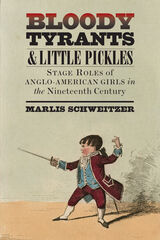 Bloody Tyrants and Little Pickles: Stage Roles of Anglo-American Girls in the Nineteenth Century
Marles Schweitzer
University of Iowa Press, 2020 Bloody Tyrants and Little Pickles traces the theatrical repertoire of a small group of white Anglo-American actresses as they reshaped the meanings of girlhood in Britain, North America, and the British West Indies during the first half of the nineteenth century. It is a study of the possibilities and the problems girl performers presented as they adopted the manners and clothing of boys, entered spaces intended for adults, and assumed characters written for men. It asks why masculine roles like Young Norval, Richard III, Little Pickle, and Shylock came to seem “normal” and “natural” for young white girls to play, and it considers how playwrights, managers, critics, and audiences sought to contain or fix the at-times dangerous plasticity they exhibited both on and off the stage. Schweitzer analyzes the formation of a distinct repertoire for girls in the first half of the nineteenth century, which delighted in precocity and playfulness and offered up a model of girlhood that was similarly joyful and fluid. This evolving repertoire reflected shifting perspectives on girls’ place within Anglo-American society, including where and how they should behave, and which girls had the right to appear at all.
Bloody Williamson: A Chapter in American Lawlessness
Paul M. Angle; Introduction by John Y. Simon
University of Illinois Press, 1952 "In Williamson County some men took to violence almost as a way of life. A shocking story, well told."--New Yorker Williamson County in southern Illinois has been the scene of almost unparalleled violence, from the Bloody Vendetta between two families in the 1870s through the Herrin Massacre of 1922, Ku Klux Klan activities that ended in fatalities, and the gang war of the 1920s between the Charlie Birger and Shelton brothers gangs. Paul Angle was fascinated by this more-than-fifty-year history, and his account of this violence has become a classic.
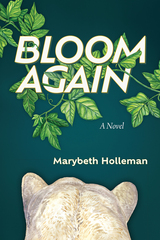 Bloom Again: A Novel
Marybeth Holleman
University of Alaska Press, 2025 Elyse is an empty-nest mother and artist in Alaska, and Astrid is a paleobotany professor in North Carolina. When the seemingly fulfilling lives of these distanced childhood friends are shaken, everything they’ve carefully established—from friends to careers to marriages—shifts, slips, unravels. This outer unraveling mirrors a growing discomfort with their safe lives. For Elyse, it begins with a mundane moment at the grocery store and a news story about polar bears. For Astrid, it happens during a faculty reception where a visiting lecturer’s talk sparks a rift with her mentor and father figure.
As the ground beneath them stirs, both women begin to recall their shared childhoods. Each must ignore the rumblings and fight for their comfortable existence—or leap. Before long, Elyse is following a Yup’ik marine mammal hunter along the windswept Siberian coast, and Astrid is risking her entire career to plant trees in India. As they navigate upheaval, they also confront the reminders of their past—a past whose full truth carries in it the promise of their future.
Bloom Again weaves together sophisticated narrative and characters, evocative travel and nature writing, and effective and reliable depictions of the climate change crisis in parts of the world underrepresented in mainstream literary fiction. A realistic work of ecoclimate fiction, it considers how people confront and respond to an amorphous yet unavoidable event like climate change in their everyday lives, as well as how women find new inspiration in their “second spring”—a time in life when career and family needs are fulfilled. It’s a book about waking up and finding our way, together.
Bloom in Reverse
Teresa Leo
University of Pittsburgh Press, 2014 Bloom in Reverse chronicles the aftermath of a friend's suicide and the end of a turbulent relationship, working through devastation and loss while on a search for solace that spans from local bars to online dating and beyond to ultimately find true connection and sustaining love. Things move backwards, from death to life, like a reverse time-lapse video of a dead flower morphing from brittle, scorched entity to floral glory to nacsent bud. The poems seek to find those places where the natural world connects to and informs experiences at the core of human relationships, and at times call upon principles and theories from physics and mathematics to describe the complexities of love and loss. It's a book where grief, melancholy, heartbreak, and disillusionment intersect with urban romanticism, hope, possibility, and love. Bloom is all of it, the terrible and the beautiful.
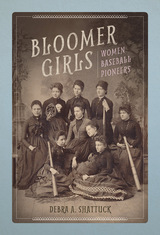 Bloomer Girls: Women Baseball Pioneers
Debra A Shattuck
University of Illinois Press, 2017 Disapproving scolds. Sexist condescension. Odd theories about the effect of exercise on reproductive organs. Though baseball began as a gender-neutral sport, girls and women of the nineteenth century faced many obstacles on their way to the diamond. Yet all-female nines took the field everywhere. Debra A. Shattuck pulls from newspaper accounts and hard-to-find club archives to reconstruct a forgotten era in baseball history. Her fascinating social history tracks women players who organized baseball clubs for their own enjoyment and even found roster spots on men's teams. Entrepreneurs, meanwhile, packaged women's teams as entertainment, organizing leagues and barnstorming tours. If the women faced financial exploitation and indignities like playing against men in women's clothing, they and countless ballplayers like them nonetheless staked a claim to the nascent national pastime. Shattuck explores how the determination to take their turn at bat thrust female players into narratives of the women's rights movement and transformed perceptions of women's physical and mental capacity. Vivid and eye-opening, Bloomer Girls is a first-of-its-kind portrait of America, its women, and its game.
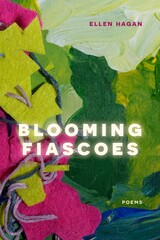 Blooming Fiascoes: Poems
Ellen Hagan
Northwestern University Press, 2021 Blooming Fiascoes is a collective of verse that deconstructs identity. We are beautiful and monstrous. We live in a beautiful and monstrous world. Ellen Hagan poetically mirrors these metaphoric adversaries, drawing on her experiences as a woman, an artist, a mother, a transplanted southerner, and above all, a human being. She plumbs origins in history, body, and living to question how we reckon our whole selves in the catacombs of a world gone mad: We mourn, we bless, / we blow, we wail, we / wind—down, we sip, / we spin, we blind, we / bend, bow & hem. We / hip, we blend, we bind, / we shake, we shine, / shine. We lips & we / teeth, we praise & protest. In these poems, Assyrian, Italian, and Irish lines seep deeper into a body that is growing older but remains engaged with unruly encounters: the experience of raising daughters, sexual freedom, and squaring body image against the body’s prohibitions. This is a work where the legacy is still evolving and always asking questions in real time. Blooming Fiascos spindles poetry that is not afraid to see itself and the lives it inhabits.
 Blooming through the Ashes: An International Anthology on Violence and the Human Spirit
Edited by Clifford Chanin and Aili McConnon
Rutgers University Press, 2008 The twentieth century is frequently characterized in terms of its unprecedented levels of bloodshed. More human beings were killed or allowed to die by human cause than ever before in history. The impact of the century’s carnage does not end with the lives that were taken; the atrocities continue to take their toll on those who survived, on those who bore witness, and on succeeding generations.
Blooming through the Ashes features over sixty writings about this historic violence and its aftermath in a global anthology that brings together the work of Nobel laureates Seamus Heaney, Toni Morrison, Czeslaw Milosz, Wole Soyinka, Elie Wiesel, Imre Kertesz, Alexandr Solzhenitsyn, Eugenio Montale, and Pablo Neruda. In non-fiction and fiction, these writers and others reflect on the litany of man-made violence that marred the twentieth century and that shadows the twenty-first, including the Holocaust, the Gulag, the Chinese Cultural Revolution, apartheid, repression in Latin America, genocides in Rwanda, Cambodia, and the attacks of 9/11.
The texts are arranged thematically, rather than by event, in order to highlight the shared themes of memory expressed across culture and geography. Starting with visceral reactions to a violent event, chapters proceed through recognitions of loss, and move into statements of public remembrance through which future generations attempt to understand the impact of past violence.
Bloomsbury Scientists: Science and Art in the Wake of Darwin
Michael Boulter
University College London, 2017 The Bloomsbury group is famous for its contributions to literature and art. What’s less well-known is that the milieu also included scientists. This book tells the story of the network of scientists living amid the writers and artists in that single square mile of London immediately before and after World War I. Michael Boulter weaves together Bloomsbury’s multidisciplinary narratives of genetics, ecology, postimpressionism, and literature, and draws intricate connections through the friendships, grievances, quarrels, and affections of the movement’s key players. Bloomsbury Scientists offers a fresh perspective on this history at a time when the complex relationship between science and art continues to be debated.
The Blossom Festival: (A Novel)
Lawrence Coates
University of Nevada Press, 1999 The Blossom Festival chronicles rural life in the Santa Clara Valley during the decades leading up to World War II. Against the lush backdrop of millions of fruit trees unfold the personal dramas of a fascinating cast of characters. This leisurely read explores the complex relationships between parents and children in the context of a rich California region bent on replacing agriculture with computer chips to become Silicon Valley.
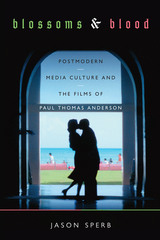 Blossoms and Blood: Postmodern Media Culture and the Films of Paul Thomas Anderson
By Jason Sperb
University of Texas Press, 2013 From his film festival debut Hard Eight to ambitious studio epics Boogie Nights, Magnolia, and There Will Be Blood, Paul Thomas Anderson’s unique cinematic vision focuses on postmodern excess and media culture. In Blossoms and Blood, Jason Sperb studies the filmmaker’s evolving aesthetic and its historical context to argue that Anderson’s films create new, often ambivalent, narratives of American identity in a media-saturated world. Blossoms and Blood explores Anderson’s films in relation to the aesthetic and economic shifts within the film industry and to America’s changing social and political sensibilities since the mid-1990s. Sperb provides an auteur study with important implications for film history, media studies, cultural studies, and gender studies. He charts major themes in Anderson’s work, such as stardom, self-reflexivity, and masculinity and shows how they are indicative of trends in late twentieth-century American culture. One of the first books to focus on Anderson’s work, Blossoms and Blood reveals the development of an under-studied filmmaker attuned to the contradictions of a postmodern media culture.
The Blow Dried Cat: And Other Island Stories
Jay Stailey
Parkhurst Brothers, Inc., 2014 The greatest hits of a school principal-turned-storyteller. A collection of humorous stories and tall tales, some based on urban legends and some original, honed in oral performance and written by a storyteller of national repute
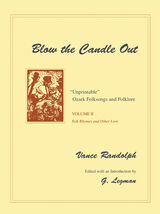 Blow the Candle Out: "Unprintable" Ozark Folksongs and Folklore, Volume II, Folk Rhymes and Other Lore
Vance Randolph
University of Arkansas Press, 1992 Collected in the field from 1915 through 1955, these tales and songs were considered by the publisher at the time to be too salacious for inclusion in Vance Randolph’s Ozark Folksongs. Randolph came to doubt that they would ever appear in print, and they did not in his lifetime.
<em>Roll Me in Your Arms</em>, Volume I of “Unprintable” Ozark Folksongs and Folklore, includes 180 unexpurgated songs collected by Randolph with tunes transcribed from the original singers. Volume II, <em><a href="https://wordpressua.uark.edu/uapress/product/blow-the-candle-out/">Blow the Candle Out</a></em>, contains rhymes and songs without music as well as other unexpurgated Ozark folk materials, including children’s lore, elements in speech, graffiti, riddles, dance calls, and beliefs.
G. Legman’s painstaking and patient editing, annotating, and crossreferencing richly complement the Randolph collection. The result is a look into a previously neglected area in the study of folksong and folklore in the Ozarks and further evidence of Randolph’s preeminence in the field.
The late Vance Randolph lived in the Ozark Mountains from 1920 until his death in 1980. Although he taught folklore at the University of Arkansas in Fayetteville, he is best remembered for his many years of field research resulting in the national bestseller <em>Pissing in the Snow & Other Ozark Folktales</em> and more than a dozen other books on American folklore.
Blow Up the Humanities
Toby Miller
Temple University Press, 2012 A short, sharp, and provocative book, Blow Up the Humanities has esteemed scholar Toby Miller declaring that there are two humanities in the United States. One is the venerable, powerful humanities of private universities; the other is the humanities of state schools, which focus mainly on job prospects. There is a class division between the two—both in terms of faculty research and student background—and it must end. Miller critically lays waste to the system. He examines scholarly publishing as well as media and cultural studies to show how to restructure the humanities by studying popular cultural phenomena, like video games. Miller ultimately insists that these two humanities must merge in order to survive and succeed in producing an aware and concerned citizenry.
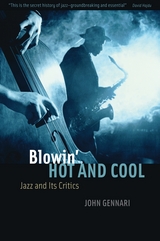 Blowin' Hot and Cool: Jazz and Its Critics
John Gennari
University of Chicago Press, 2006 In the illustrious and richly documented history of American jazz, no figure has been more controversial than the jazz critic. Jazz critics can be revered or reviled—often both—but they should not be ignored. And while the tradition of jazz has been covered from seemingly every angle, nobody has ever turned the pen back on itself to chronicle the many writers who have helped define how we listen to and how we understand jazz. That is, of course, until now.
In Blowin’ Hot and Cool, John Gennari provides a definitive history of jazz criticism from the 1920s to the present. The music itself is prominent in his account, as are the musicians—from Louis Armstrong and Duke Ellington to Charlie Parker, John Coltrane, Roscoe Mitchell, and beyond. But the work takes its shape from fascinating stories of the tradition’s key critics—Leonard Feather, Martin Williams, Whitney Balliett, Dan Morgenstern, Gary Giddins, and Stanley Crouch, among many others. Gennari is the first to show the many ways these critics have mediated the relationship between the musicians and the audience—not merely as writers, but in many cases as producers, broadcasters, concert organizers, and public intellectuals as well.
For Gennari, the jazz tradition is not so much a collection of recordings and performances as it is a rancorous debate—the dissonant noise clamoring in response to the sounds of jazz. Against the backdrop of racial strife, class and gender issues, war, and protest that has defined the past seventy-five years in America, Blowin’ Hot and Cool brings to the fore jazz’s most vital critics and the role they have played not only in defining the history of jazz but also in shaping jazz’s significance in American culture and life.
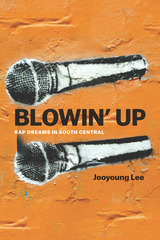 Blowin' Up: Rap Dreams in South Central
Jooyoung Lee
University of Chicago Press, 2016 Dr. Dre. Snoop Dogg. Ice Cube. Some of the biggest stars in hip hop made their careers in Los Angeles. And today there is a new generation of young, mostly black, men busting out rhymes and hoping to one day find themselves “blowin’ up”—getting signed to a record label and becoming famous. Many of these aspiring rappers get their start in Leimart Park, home to the legendary hip hop open-mic workshop Project Blowed. In Blowin’ Up, Jooyoung Lee takes us deep inside Project Blowed and the surrounding music industry, offering an unparalleled look at hip hop in the making.
While most books on rap are written from the perspective of listeners and the market, Blowin’ Up looks specifically at the creative side of rappers. As Lee shows, learning how to rap involves a great deal of discipline, and it takes practice to acquire the necessary skills to put on a good show. Along with Lee—who is himself a pop-locker—we watch as the rappers at Project Blowed learn the basics, from how to hold a microphone to how to control their breath amid all those words. And we meet rappers like E. Crimsin, Nocando, VerBS, and Flawliss as they freestyle and battle with each other. For the men at Project Blowed, hip hop offers a creative alternative to the gang lifestyle, substituting verbal competition for physical violence, and provides an outlet for setting goals and working toward them.
Engagingly descriptive and chock-full of entertaining personalities and real-life vignettes, Blowin’ Up not only delivers a behind-the-scenes view of the underground world of hip hop, but also makes a strong case for supporting the creative aspirations of young, urban, black men, who are often growing up in the shadow of gang violence and dead-end jobs.
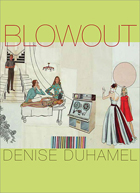 Blowout
Denise Duhamel
University of Pittsburgh Press, 2013 Finalist, National Book Critics Circle Award.
In Blowout, Denise Duhamel asks the same question that Frankie Lyman & the Teenagers asked back in 1954—"Why Do Fools Fall in Love?" Duhamel's poems readily admit that she is a love-struck fool, but also embrace the "crazy wisdom" of the Fool of the Tarot deck and the fool as entertainer or jester. From a kindergarten crush to a failed marriage and beyond, Duhamel explores the nature of romantic love and her own limitations. She also examines love through music, film, and history—Michelle and Barak Obama's inauguration and Cleopatra's ancient sex toy. Duhamel chronicles the perilous cruelties of love gone awry, but also reminds us of the compassion and transcendence in the aftermath. In "Having a Diet Coke with You," she asserts that "love poems are the most difficult poems to write / because each poem contains its opposite its loss / and that no matter how fierce the love of a couple / one of them will leave the other / if not through betrayal / then through death." Yet, in Blowout, Duhamel fiercely and foolishly embraces the poetry of love.
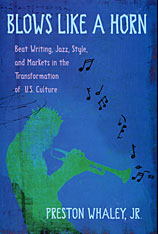 Blows Like a Horn: Beat Writing, Jazz, Style, and Markets in the Transformation of U.S. Culture
Preston Whaley, Jr.
Harvard University Press, 2004 Reopening the canons of the Beat Generation, Blows Like a Horn traces the creative counterculture movement as it cooked in the heat of Bay Area streets and exploded into spectacles, such as the scandal of the Howl trial and the pop culture joke of beatnik caricatures. Preston Whaley shows Beat artists riding the glossy exteriors of late modernism like a wave. Participants such as Lawrence Lipton, Lawrence Ferlinghetti, and at great personal cost, even Jack Kerouac, defied the traditional pride of avant-garde anonymity. They were ambitious to change the culture and used mass-mediated scandal, fame, and distortion to attract knowing consumers to their poetry and prose.
Blows Like a Horn follows the Beats as they tweaked the volume of excluded American voices. It watches vernacular energies marching through Beat texts on their migration from shadowy urban corners and rural backwoods to a fertile, new hyper-reality, where they warped into stereotypes. Some audiences were fooled. Others discovered truths and were changed.
Mirroring the music of the era, the book breaks new ground in showing how jazz, much more than an ambient soundtrack, shaped the very structures of Beat art and social life. Jazz, an American hybrid—shot through with an earned-in-the-woodshed, African American style of spontaneous intelligence—also gave Beat poetry its velocity and charisma. Blows Like a Horn plumbs the actions and the art of celebrated and arcane Beat writers, from Allen Ginsberg to ruth weiss. The poetry, the music, the style—all of these helped transform U.S. culture in ways that are still with us.
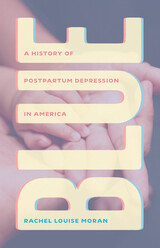 Blue: A History of Postpartum Depression in America
Rachel Louise Moran
University of Chicago Press, 2024 A powerful look at the changing cultural understanding of postpartum depression in America.
New motherhood is often seen as a joyful moment in a woman’s life; for some women, it is also their lowest moment. For much of the twentieth century, popular and medical voices blamed women who had emotional and mental distress after childbirth for their own suffering. By the end of the century, though, women with postpartum mental illnesses sought to take charge of this narrative. In Blue: A History of Postpartum Depression in America, Rachel Louise Moran explores the history of the naming and mainstreaming of postpartum depression. Coalitions of maverick psychiatrists, psychologists, and women who themselves had survived substantial postpartum distress fought to legitimize and normalize women’s experiences. They argued that postpartum depression is an objective and real illness and fought to avoid it being politicized alongside other fraught medical and political battles over women’s health.
Based on insightful oral histories and in-depth archival research, Blue reveals a secret history of American motherhood, women’s political activism, and the rise of postpartum depression advocacy amid an often-censorious conservative culture. By breaking new ground with the first book-length history of postpartum mental illness in the twentieth century, Moran brings mothers’ battles with postpartum depression out of the shadows and into the light.
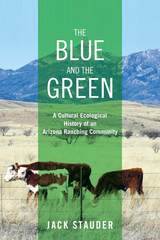 The Blue and the Green: A Cultural Ecological History of an Arizona Ranching Community
Jack Stauder
University of Nevada Press, 2016 In The Blue and the Green, anthropologist Jack Stauder analyzes how large-scale political, social, and environmental processes have transformed ranching and rural life in the West. Focusing on the community of Blue, Arizona, Stauder details how the problems of overgrazing, erosion, and environmental stresses on the open range in the early twentieth century coincided with a push by the newly created US Forest Service to develop fenced grazing allotments on federal lands. Later in the twentieth century, with the enactment of the Endangered Species Act and other laws, the growing power of urban-based environmental groups resulted in the reduction of federal grazing leases throughout the West. The author combines historical research with oral interviews to explore the impact of these transformations on the ranchers residing in the Blue River Valley of eastern Arizona. Stauder gives voice to these ranchers, along with Forest Service personnel, environmental activists, scientists, and others involved with issues on “the Blue,” shedding light on how the ranchers’ rural way of life has changed dramatically over the course of the past century. This is a fascinating case study of the effects of increasing government regulations and the influence of outsiders on ranching communities in the American West.
 The Blue and the Yellow Stars of David: The Zionist Leadership in Palestine and the Holocaust, 1939–1945
Dina Porat
Harvard University Press, 1990 Since the end of World War II the Israeli public has bitterly debated the guilt-ridden question of whether the Jewish community of Palestine really did everything in its power to rescue Jews in Nazi-occupied countries. Dina Porat gives a searching analysis of the record, basing her conclusions on archival material and other primary sources, hitherto mostly unused. She investigates how and when the Zionist leadership in Palestine fully understood that Europe's Jews were facing annihilation; what rescue plans they developed and what resources were allocated to the effort; what help they tried to get from free-world Jewry and from the British and American governments. And she looks at what went wrong—why in the end so little was done.
Porat struggles with these painful questions of accountability in the light of the Zionist enterprise, its ideologies and internal disputes. She describes the ambivalent attitude of the Zionists in Palestine, who first viewed most of the European Jews as lambs led to slaughter, compared the victims of the Holocaust unfavorably with the tough pioneers of Zion and those few in Europe who fought back, and only gradually understood that every daily struggle was a form of fighting back. Above all, the priorities of the Jewish community in Palestine reflected its overriding goal of building an independent Jewish state despite meager resources, crucial dependence on the good will of friendly powers, and a small number of survivors (instead of the millions they hoped to absorb).
The Blue and the Yellow Stars of David is an important chapter in the history of Israel and the history of World War II. And as the story of a leadership that was unable to respond adequately to a tragically urgent situation, this book focuses on questions of wide and abiding concern.
 Blue Architecture: Water, Design, and Environmental Futures
Brook Muller
University of Texas Press, 2022 2023 Finalist, PROSE Award in Architecture and Urban Planning
A guide to water-focused and climate-resilient architectural and urban design.
Le Corbusier famously said, “A house is a machine for living in.” We now confront the litany of environmental challenges associated with the legacy of the architectural machine: a changing climate, massive species die-off, diminished air and water quality, and resource scarcities. Brook Muller offers an alternative: water-centric urban design that fosters sustainability, equity, and architectural creativity. Inspired by the vernacular, such as the levadas of Madeira Island and both the arid and drenched places of the American West, Muller articulates a “hydro-logical” philosophy in which architects and planners begin by conceptualizing interactions between existing waterways and the spaces they intend to develop. From these interactions—and the new technologies and approaches enabling them—aesthetic, spatial, and experiential opportunities follow. Not content merely to work around sensitive ecology, Muller argues for genuinely climate-adapted urban landscapes in which buildings act as ecological infrastructure that actually improve watersheds while delivering functionality and beauty for diverse communities. Rich in images and practical examples, Blue Architecture will change the way we think about our designed world.
 Blue Chicago: The Search for Authenticity in Urban Blues Clubs
David Grazian
University of Chicago Press, 2003 The club is run-down and dimly lit. Onstage, a black singer croons and weeps of heartbreak, fighting back the tears. Wisps of smoke curl through the beam of a single spotlight illuminating the performer.
For any music lover, that image captures the essence of an authentic experience of the blues. In Blue Chicago, David Grazian takes us inside the world of contemporary urban blues clubs to uncover how such images are manufactured and sold to music fans and audiences. Drawing on countless nights in dozens of blues clubs throughout Chicago, Grazian shows how this quest for authenticity has transformed the very shape of the blues experience. He explores the ways in which professional and amateur musicians, club owners, and city boosters define authenticity and dish it out to tourists and bar regulars. He also tracks the changing relations between race and the blues over the past several decades, including the increased frustrations of black musicians forced to slog through the same set of overplayed blues standards for mainly white audiences night after night. In the end, Grazian finds that authenticity lies in the eye of the beholder: a nocturnal fantasy to some, an essential way of life to others, and a frustrating burden to the rest.
From B.L.U.E.S. and the Checkerboard Lounge to the Chicago Blues Festival itself, Grazian's gritty and often sobering tour in Blue Chicago shows us not what the blues is all about, but why we care so much about that question.
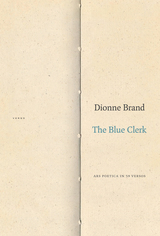 The Blue Clerk: Ars Poetica in 59 Versos
Dionne Brand
Duke University Press, 2018 On a lonely wharf a clerk in an ink-blue coat inspects bales and bales of paper that hold a poet’s accumulated left-hand pages—the unwritten, the withheld, the unexpressed, the withdrawn, the restrained, the word-shard. In The Blue Clerk renowned poet Dionne Brand stages a conversation and an argument between the poet and the Blue Clerk, who is the keeper of the poet’s pages. In their dialogues—which take shape as a series of haunting prose poems—the poet and the clerk invoke a host of writers, philosophers, and artists, from Jacob Lawrence, Lola Kiepja, and Walter Benjamin to John Coltrane, Josephine Turalba, and Jorge Luis Borges. Through these essay poems, Brand explores memory, language, culture, and time while intimately interrogating the act and difficulty of writing, the relationship between the poet and the world, and the link between author and art. Inviting the reader to engage with the resonant meanings of the withheld, Brand offers a profound and moving philosophy of writing and a wide-ranging analysis of the present world.
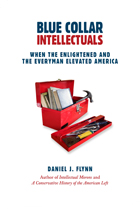 Blue Collar Intellectuals: When the Enlightened and the Everyman Elevated America
Daniel J. Flynn
Intercollegiate Studies Institute, 2011
Stupid is the new smart—but it wasn’t always so
Popular culture has divorced itself from the life of the mind. Who has time for great books or deep thought when there is Jersey Shore to watch, a txt 2 respond 2, and World of Warcraft to play?
At the same time, those who pursue the life of the mind have insulated themselves from popular culture. Speaking in insider jargon and writing unread books, intellectuals have locked themselves away in a ghetto of their own creation. It wasn’t always so. Blue Collar Intellectuals vividly captures a time in the twentieth century when the everyman aspired to high culture and when intellectuals descended from the ivory tower to speak to the everyman. Author Daniel J. Flynn profiles thinkers from working-class backgrounds who played a prominent role in American life by addressing their intellectual work to a mass audience. Blue Collar Intellectuals tells the fascinating story of:he unschooled hobo who migrated from skid row anonymity to White House chats with the president and prime-time TV specials. Blue Collar Intellectuals tells the fascinating story of:
•The scandalous teacher-student romance that spawned a half-century labor of love in writing the history of the world.
•The Ivy League Ph.D. who held neither a high school nor college degree, and fittingly launched a renaissance in reading the great books outside of formal schools.
•The scholarship student who experienced the free market firsthand waiting tables and peddling socks, and who became one of capitalism’s most influential exponents.
•The impoverished outcast who became the poet of the pulps, elevating millions of readers along with heretofore marginal genres.
Guiding us through a world now vanished, Flynn causes us to look anew at our own digital age and its nostrums: Video gaming is just a new form of literacy, Reality shows . . . Challenge our emotional intelligence, and Who cares if Johnny can’t read? The value of books is overstated. Blue Collar Intellectuals shows us how much everyone intellectual and everyman alike has suffered from mass culture’s crowding out of higher things and the elite’s failure to engage the masses.
Praise for Blue Collar Intellectuals
“This book is not only an exciting story; it also corrects a terrible cultural mistake—the mistake of treating high culture, Great Books, and other canon-making visions of tradition as exploitative and spurious. Previous generations of intellectuals believed that our great cultural inheritance belonged to everyone, rich and poor, black and white and brown. Daniel Flynn’s profiles revive that belief, and they mark a vital alternative to the complacent relativism of contemporary cultural stewards.”
—Mark Bauerlein, best-selling author of The Dumbest Generation
“Flynn’s case histories of a wonderful—and uniquely American—tradition of bringing learning to the masses offers us a morality tale in these times of spiraling tuition, esoteric publication, and an insular academia mostly cut off from wider society. The fascinating portraits here remind us how not so long ago an interest in making knowledge known beyond the campus was not antithetical to learning but the very essence of the true intellectual.”
—Victor Davis Hanson, coauthor of Who Killed Homer? and The Bonfire of the Humanities
“Back in the middle decades of the twentieth century, millions of Americans supped at the table of high culture, learning history, philosophy, and economics from intellectual entrepreneurs like Will and Ariel Durant, Mortimer Adler, and Eric Hoffer. Daniel Flynn tells their story inBlue Collar
 Blue Corn Tongue: Poems in the Mouth of the Desert
Amber McCrary
University of Arizona Press, 2025 Shí: First-person singular possessive pronoun my, mine
examples: shí heart, shí squeeze, shí hunny
In a voice that is jubilant, irreverent, sometimes scouring, sometimes heartfelt, and always unmistakably her own, Amber McCrary remaps the deserts of Arizona through the blue corn story of a young Diné woman figuring out love and life with an O’odham man. Reflecting experiences of Indigenous joy, pain, and family, these shapeshifting poems celebrate the love between two Native partners, a love that flourishes alongside the traumas they face in the present and the past. From her ethereal connection with her saguaro muse, Hosh, to the intricate tapestry of her relationships with Diné relatives and her awakening to the complex world of toxic masculinity, McCrary brings together DIY zine aesthetics, life forms of juniper and mountains, and the beauty of Diné Bizaad to tell of the enduring bonds between people and place.
Journeying from the Colorado Plateau to the Sonoran Desert and back again, Blue Corn Tongue invokes the places, plants, and people of Diné Bikéyah and O’odham jeweḍ in a deeply honest exploration of love, memory, and intimacy confronting the legacy of land violence in these desert homelands.
Blue Daughter of the Red Sea: A Memoir
Meti Birabiro
University of Wisconsin Press, 2004 Born into a life of constant financial, physical, and moral threat, Meti Birabiro takes refuge in literature and the fantastic. Blue Daughter of the Red Sea is Birabiro’s poetic account of the harsh reality of her young life spread across three continents. Her voice is a fresh mélange of child and adult perspectives, at once brutally honest and wise beyond her years. Through her journey from Ethiopia to Italy and finally to the United States, we encounter Birabiro’s relatives, friends, and enemies—relationships so intense that these people become her vampires, devils, angels, and saints. These characterizations always lead her back to the truth, helping her to decipher what is fair and good, to understand what she must cherish and what she must rage against.
Blue Desert
Charles Bowden
University of Arizona Press, 1986 In the promised land of the Sunbelt, people come by the thousands to escape the crush of Eastern cities and end up duplicating the very world they have fled. Can the land remain unchanged?
In Blue Desert, Charles Bowden presents a view of the Southwest that seeks to measure how rapid growth has taken its toll on the land. Writing with a reporter's objectivity and a desert rat's passion, Bowden takes us into the streets as well as the desert to depict not a fragile environment but the unavoidable reality of abuse, exploitation, and human cruelty. Blue Desert shows us the Sunbelt's darker side as it has developed in recent times—where “the land always makes promises of aching beauty and the people always fail the land”—and defies us to ignore it.
Blue Desert has no boundaries, no terrain, no topographical coordinates; it is a state of mind inescapable to one who sees change and knows that nothing can be done to stop it.
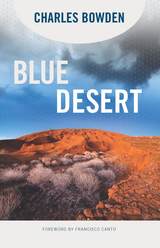 Blue Desert
Charles Bowden; Foreword by Francisco Cantú
University of Arizona Press, 2018 Published in 1986, Blue Desert was Charles Bowden’s third book-length work and takes place almost entirely in Arizona, revealing Bowden’s growing and intense preoccupation with the state and what it represented as a symbol of America’s “New West.”
Bowden presents a view of the Southwest that measures how rapid growth takes its toll on the land. Writing with a reporter’s objectivity and a desert rat’s passion, Bowden offers us his trademarked craft and wit to take us into the streets as well as the desert to depict not a fragile environment but the unavoidable reality of abuse, exploitation, and human cruelty. Blue Desert shows us the darker side of development—where “the land always makes promises of aching beauty and the people always fail the land”—and defies us to ignore it.
In a thoughtful new foreword, Francisco Cantú writes, “In Blue Desert, we follow Bowden in the processes of becoming. We see the version of Bowden that he would likely most want us to remember—someone who did their best to be an honest witness, someone who was haunted by modernity and his place in it, someone who grappled with his demons by gazing deeply into the desert.” Blue Desert is a critical piece in the oeuvre of Charles Bowden, and it continues to remind readers of the cruelty and beauty of the world around us.
The Blue Divide: Poems
Linda Nemec Foster
New Issues Poetry and Prose, 2021 The poems in this powerful new collection explore the history of conflict and resilience—whether it occurs during the Nazi occupation of Poland, the Balkan wars in Bosnia and Croatia, or within the intimate tableaux of a family’s dissonance. Weaving poems into three distinct sections, Linda Nemec Foster pays close attention to not only what divides us, but also to what can heal and redeem our common journey: an artist’s notebook; the imagined life of Mary Magdalene; a fascination with Mount Fuji; a mother’s obsession with vintage movie stars; a dead father’s love. The Blue Divide resonates with the landscape of the world and the landscape of the heart.
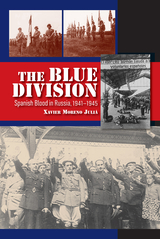 The Blue Division: Spanish Blood in Russia, 1941-1945
Xavier Moreno Julia
Sussex Academic Press, 2022 This book, translated from the original Spanish, is the primary academic and historical study of the Blue Division -- a Falangist initiative involving the dispatch of some forty-thousand Spanish combatants (over a half of whom paid with their lives, health, or liberty) to the Russian Front during the Second World War. Xavier Moreno Julia does not limit himself to relating their deeds under arms, but also analyses -- for the first time -- the political background in detail: the complex relations between the Spanish government and Hitler's Germany; the internal conflicts between the Falangists and the Army; the rise and fall of Franco's brother-in-law, Minister Ramon Serrano Suner, who inspired the Blue Division and became the second most powerful person in Spain; and the attitude of General Agustin Munoz Grandes, commander of the Blue Division, who was encouraged by Berlin to seriously consider the possibility of taking over the reins of Spanish power. In the end, there were 45,500 reasons that led to joining the Blue Division -- one for each young man who decided to enlist. To understand all of the complex reasons behind their military service under German command is impossible at this juncture. It is an irrecoverable past that lies in Spanish cemeteries and on the Russian steppes. This book, based on massive documentation in German, British and Spanish archives, is an essential source of information to understand Spain in the 1940s -- an epoch when the Caudillo's power and the regime's good fortune were less secure than is often believed. Published in association with the Canada Blanch Centre for Contemporary Spanish Studies, LSE.
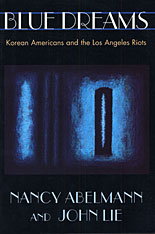 Blue Dreams: Korean Americans and the Los Angeles Riots
Nancy Abelmann and John Lie
Harvard University Press, 1995 No one will soon forget the image, blazed across the airwaves, of armed Korean Americans taking to the rooftops as their businesses went up in flames during the Los Angeles riots. Why Korean Americans? What stoked the wrath the riots unleashed against them? Blue Dreams is the first book to make sense of these questions, to show how Korean Americans, variously depicted as immigrant seekers after the American dream or as racist merchants exploiting African Americans, emerged at the crossroads of conflicting social reflections in the aftermath of the 1992 riots.
The situation of Los Angeles’s Korean Americans touches on some of the most vexing issues facing American society today: ethnic conflict, urban poverty, immigration, multiculturalism, and ideological polarization. Combining interviews and deft socio-historical analysis, Blue Dreams gives these problems a human face and at the same time clarifies the historical, political, and economic factors that render them so complex. In the lives and voices of Korean Americans, the authors locate a profound challenge to cherished assumptions about the United States and its minorities.
Why did Koreans come to the United States? Why did they set up shop in poor inner-city neighborhoods? Are they in conflict with African Americans? These are among the many difficult questions the authors answer as they probe the transnational roots and diversity of Los Angeles’s Korean Americans. Their work finally shows us in sharp relief and moving detail a community that, despite the blinding media focus brought to bear during the riots, has nonetheless remained largely silent and effectively invisible. An important corrective to the formulaic accounts that have pitted Korean Americans against African Americans, Blue Dreams places the Korean American story squarely at the center of national debates over race, class, culture, and community.
 Blue Futures, Break Open: A Novel
Zoë Gadegbeku
West Virginia University Press, 2025 Blue Basin Island is the final resting spot of formerly enslaved Africans whose souls have flown from Earth—not to heaven or purgatory but toward freedom and a new life. Lucille, the island’s seamstress, takes two forms. She lives among the inhabitants in human form and, along with the evil-repelling blue of the houses, her divine form protects people from the violence of the their former lives. Yet, even there, outside of time, the souls are not totally insulated from the world in which they were enslaved. Each time a Black person anywhere is harmed, a piece of Blue Basin disintegrates: an earthquake leaves hundreds of thousands dead, and bricks crumble on the island; when police kill a Black child asleep in her bed, the blue paint on homes throughout the island drips and then runs from the walls. Lucille must hold the island together, but she struggles to juggle the responsibility of ensuring everyone’s safety while also seeking and losing her own private love. Grounding the story in African folklore and dipping into the rich literary tradition around African people with the power of flight, Zoë Gadegbeku visualizes the destination at the end of the flight and the new life that awaits them.
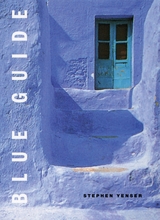 Blue Guide
Stephen Yenser
University of Chicago Press, 2006 Inspired by the miraculously mercurial potential of words, Stephen Yenser takes readers on a heady trip through a world full of promise yet compromised by human weakness. Set in sunny southern California and Greece, the poems of Blue Guide cast the shadow of mortality, and the tones are elegiac. This combination of the deadly serious and the exuberant is natural, Yenser notes; after all, work and orgy share the same etymological root, as do travail and travel, pledge and play.
Using various poetic modes, Yenser offers here a quatrain written to name a painting by Dorothea Tanning; a sequence of poems for his daughter; an excursive poem at once about Los Angeles and Baghdad and his father and a petty criminal; a group of prose poems set in penumbral bars; some postcards to a dead friend; and a meditation prompted by a sojourn on a remote Aegean island. The most unexpected work is an assemblage of quotations and glosses in the tradition of the commonplace book, except that in Yenser's hands these entries are densely interrelated
.
Blue Guide
Lee Briccetti
Four Way Books, 2018 In Blue Guide, Lee Briccetti is as much archeologist as tour guide as she excavates the layers of her life and reassembles the shards into poems that are stunning in their lyric wisdom. She moves easily, albeit restlessly, between past and present and here and there, from the streets of ancient Rome to post-9/11 lower Manhattan, ultimately concluding that “The dead / always tell us live.” Through this journey, she constructs a new architecture of the soul that realizes “In this happiness we build each other—”
The Blue Guide to Indiana
Michael Martone
University of Alabama Press, 2001 An ersatz travel book for the Hoosier State
The master of the nearly true is back with The Blue Guide to Indiana, an ersatz travel book for the Hoosier State. Michael Martone, whose trademark is the blurring of the lines between fact and fiction, has created an Indiana that almost is, a landscape marked by Lover's Lane franchises and pharmaceutical drug theme parks. Visit the Trans-Indiana Mayonnaise Pipeline and the Field of Lightbulbs. Learn about Our Lady of the Big Hair and Feet or the history of the License Plate Insurrection of 1979. Let Martone guide you through every inch of the amazing state that is home to the Hoosier Infidelity Resort Area, the National Monument for Those Killed by Tornadoes in Trailer Parks and Mobile Home Courts, and the Annual Eyeless Fish Fry. All your questions will be answered, including many you never thought to ask (like: "What's a good recipe for Pork Cake?").
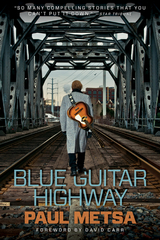 Blue Guitar Highway
Paul Metsa
University of Minnesota Press, 2011 This is a musician’s tale: the story of a boy growing up on the Iron Range, playing his guitar at family gatherings, coming of age in the psychedelic seventies, and honing his craft as a pro in Minneapolis, ground zero of American popular music in the mid-eighties. “There is a drop of blood behind every note I play and every word I write,” Paul Metsa says. And it’s easy to believe, as he conducts us on a musical journey across time and country, navigating switchbacks, detours, dead ends, and providing us the occasional glimpse of the promised land on the blue guitar highway. His account captures the thrill of the Twin Cities when acts like the Replacements, Husker Dü, and Prince were remaking pop music. It takes us right onto the stages he shared with stars like Billy Bragg, Pete Seeger, and Bruce Springsteen. And it gives us a close-up, dizzying view of the roller-coaster ride that is the professional musician’s life, played out against the polarizing politics and intimate history of the past few decades of American culture. Written with a songwriter’s sense of detail and ear for poetry, Paul Metsa’s book conveys all the sweet absurdity, dry humor, and passion for the language of music that has made his story sing.
 The Blue Guitar: Political Representation and Community
Nancy L. Schwartz
University of Chicago Press, 1988 Americans conceive of the process of political representation as operating like a "transmission belt." Elections convey citizens' preferences unchanged into the legislative assembly and thereby allow them to participate, through their representatives, in the political affairs of the nation. This conception stands firmly in the tradition of liberal thought, as does much theory about political representation. In that tradition, government is defined primarily in terms of power, and elections are little more than the means by which that power is transferred from the people to their representatives.
In The Blue Guitar (the title alludes to a poem by Wallace Stevens), Nancy L. Schwartz offers a radically new understanding of representation. As she sees it, representatives should be—and, in the past, have been—more than mere delegates or trustees of individual desires and interests and the process of representation more than the appropriation of power and control. Ideally, representation should transform both representative and citizen. Representatives should be caretakers of the community, not the watchdogs of special interest groups or individuals. Citizens in turn should feel increased personal responsibility for the whole that membership in the community entails. Moreover, representatives should serve as founders of their constituencies, constituting communities whose members value citizenship as an end in itself.
In her analysis, Schwartz canvasses the political experience of ancient, medieval, and Renaissance city-states to discover the communitarian meaning of citizenship, and she draws on classical political theory from Plato to Rousseau and Hegel, on the political sociology of Marx and Weber, and on such contemporary theorists as Arendt and Pitkin. Schwartz also enters the controversy over whether local, state, and national legislators should be selected by district or at-large elections. After examining a set of key Supreme Court cases on voting rights and district elections, she proposes that representatives come from single-member geographic districts.
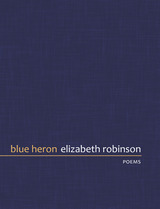 Blue Heron
Elizabeth Robinson
University Press of Colorado, 2013 The poems in Blue Heron delineate a passage through grief and change. Here, personal loss is continuous with threats to other species and landscapes. In response, Robinson has uprooted the terrain of language, “what / bestows itself from / the almost-invisible / and its stain.” If these uprootings are casualties of a poetics seeking to redress imbalance and “pollution,” then they are also opportunities to rethink what can exist in the field of poetic language as “roots also quicken, bruise their plural pronouns, lose tune, / forsake terrain by moving through and on it.” And so Blue Heron links poetic process with organic process, presence with the gap we know as hauntedness. The page is not only a resonant physical field, but also a site of dialogue between human and landscape, between lack and manifestation. If these poems constitute a poetics of loss, they are equally a movement toward a poetics of openness, risk, and renewed balance in which poetry shifts as “a form of weather, a form/of following, falling from the form/as it twists.”
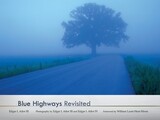 BLUE HIGHWAYS Revisited
Edgar I. Ailor III, Photography by Edgar I. Ailor III and Edgar I. Ailor IV, Foreword by William Least Heat-Moon
University of Missouri Press, 2012 In 1978, William Least Heat-Moon made a 14,000-mile journey on the back roads of America, visiting 38 states along the way. In 1982, the popular Blue Highways, which chronicled his adventures, was published. Three decades later, Edgar Ailor III and his son, Edgar IV, retraced and photographed Heat-Moon’s route, culminating in Blue Highways Revisited, released for publication on the thirtieth anniversary of Blue Highways. A foreword by Heat-Moon notes, "The photographs, often with amazing accuracy, capture my verbal images and the spirit of the book. Taking the journey again through these pictures, I have been intrigued and even somewhat reassured that America is changing not quite so fast as we often believe. The photographs, happily, reveal a recognizable continuity – but for how much longer who can say – and I'm glad the Ailors have recorded so many places and people from Blue Highways while they are yet with us."
Through illustrative photography and text, Ailor and his son capture once more the local color and beauty of the back roads, cafes, taverns, and people of Heat-Moon’s original trek. Almost every photograph in Blue Highways Revisited is referenced to a page in the original work. With side-by-side photographic comparisons of eleven of Heat-Moon’s characters, this new volume reflects upon and develops the memoir of Heat-Moon’s cross-country study of American culture and spirit. Photographs of Heat-Moon’s logbook entries, original manuscript pages, Olympia typewriter, Ford van, and other artifacts also give readers insight into Heat-Moon’s approach to his trip. Discussions with Heat-Moon about these archival images provide the reader insight into the travels and the writing of Blue Highways that only the perspective of the author could provide.
Blue Highways Revisited reaffirms that the "blue highway" serves as a romantic symbol of the free and restless American spirit, as the Ailors lose themselves to the open road as Heat-Moon did thirty years previously. This book reminds readers of the insatiable attraction of the “blue highway”—“But in those brevities just before dawn and a little after dusk—times neither day or night—the old roads return to the sky some of its color. Then, in truth, they carry a mysterious cast of blue, and it's that time when the pull of the blue highway is strongest, when the open road is a beckoning, a strangeness, a place where a man can lose himself” (Introduction to Blue Highways).
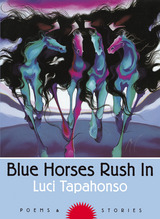 Blue Horses Rush In: Poems and Stories
Luci Tapahonso
University of Arizona Press, 1997 Wrapped in blankets and looking at the stars, a young Navajo girl listened long ago to stories that would guide her for the rest of her life. "Such summer evenings were filled with quiet voices, dogs barking far away, the fire crackling, and often we could hear the faint drums and songs of a ceremony somewhere in the distance," writes Luci Tapahonso in this compelling collection.
Blue Horses Rush In takes its title from a poem about the birth of her granddaughter Chamisa, whose heart "pounded quickly and we recognized / the sound of horses running: / the thundering of hooves on the desert floor." Through such personal insights, this collection follows the cycle of a woman's life and underlines what it means to be Navajo in the late twentieth century. The book marks a major accomplishment in American literature for its successful blending of Navajo cultural values and forms with the English language, while at the same time retaining the Navajo character. Here, Luci Tapahonso walks slowly through an ancient Hohokam village, recalling stories passed down from generation to generation. Later in the book, she may tell a funny story about a friend, then, within a few pages, describe family rituals like roasting green chiles or baking bread in an outside oven. Throughout, Tapahonso shares with readers her belief in the power of pollen and prayer feathers and sacred songs.
Many of these stories were originally told in Navajo, taking no longer than ten minutes in the telling. "Yet, in recreating them, it is necessary to describe the land, the sky, the light, and other details of time and place," writes Tapahonso. "In this way, I attempt to create and convey the setting for the oral text. In writing, I revisit the place or places concerned and try to bring the reader to them, thereby enabling myself and other Navajos to sojourn mentally and emotionally in our home, Dinétah."
The Blue Hour
Jennifer Whitaker
University of Wisconsin Press, 2016 Fairy tales both familiar and obscure create a threshold, and the The Blue Hour pulls us over it. With precise language and rich detail, these poems unflinchingly create an eerie world marked by abuse, asking readers not just to bear witness but to try to understand how we make meaning in the face of the meaningless violence.
Blue Hours: A Novel
Daphne Kalotay
Northwestern University Press, 2019 A mystery linking Manhattan circa 1991 to eastern Afghanistan in 2012, Blue Hours tells of a life-changing friendship between two memorable heroines. When we first meet Mim, she is a recent college graduate who has disavowed her lower middle class roots to befriend Kyra, a dancer and daughter of privilege, until calamity causes their estrangement. Twenty years later, Kyra has gone missing from her NGO’s headquarters in Jalalabad, and Mim—now a recluse in rural New England—embarks on a journey to find her. In its nuance, originality, and moral complexity, Blue Hours becomes an unexpected page-turner.
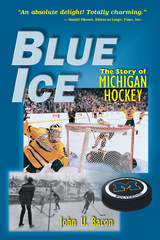 Blue Ice: The Story of Michigan Hockey
John U. Bacon
University of Michigan Press, 2001 Blue Ice relates the tale of the University of Michigan's hockey program--from its fight to become a varsity sport in the 1920s to its 1996 and 1998 NCAA national championships. This history of the hockey program profiles the personalities who shaped the program--athletic directors, coaches, and players. From Fielding Yost, who made the decision to build the team a rink with artificial ice before the Depression (which ensured hockey would be played during those lean years), to coaches Joseph Barss, who survived World War I and the ghastly Halifax explosion before becoming the program's first coach, to Red Berenson, who struggled to return his alma mater's hockey team to prominence in the 1980s and 1990s. Players from Eddie Kahn, who scored Michigan's first goal in 1923, to Brendan Morrison, who upon winning the 1996 national championship with his goal said, "This is for all the [Michigan] guys who never had a chance to win it." Blue Ice also explores the players' exotic backgrounds, from Calumet in the Upper Peninsula to Minnesota's Iron Range to Regina, Saskatchewan; how coach Vic Heygliger launched the NCAA tournament at the glamorous Broadmoor Hotel; and how commissioner Bill Beagan transformed the country's premier hockey conference. In Blue Ice, fans of hockey will learn the stories behind the curse of the Boston University Terriers, the hockey team's use of the winged helmet, and the unlikely success of Ann Arbor's home-grown talent. Unlike other sports at the collegiate level, the hockey players at Michigan haven't been motivated by fame or fortune; rather, they came to Michigan get an education and to play the game they loved. John U. Bacon has won numerous national writing awards and now freelances for Sports Illustrated,Time,ESPN Magazine,and the New York Times, among others.
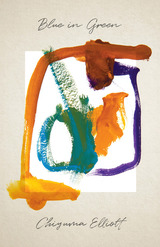 Blue in Green
Chiyuma Elliott
University of Chicago Press, 2021 Poems that address interpersonal connections while navigating life and care amid disease and disaster.
Collaboration runs through the heart of this collection. Human relationships—particularly in families—shape the poems in Blue in Green, as they consider how the question of what we expect from one another evolves into a question of what we owe. When cancer overshadows the ordinary—engrossing the labor of love, work, and friendship—disease becomes a collaborator and proposes new rules of exchange.
The forms of Elliott’s works highlight reciprocity. Here you’ll find ekphrastic poems that describe modern jazz songs, letters and letter fragments, and free verse poems in wildly variable line lengths. “When I was a wave,” the speaker repeats, each time telling a different story about intimacy and risk. Blue in Green moves through the struggle of processing the damaging interpersonal reverberations of racism, sexism, and environmental damage, while navigating intertwined personal and political incarnations of care. While a slow-growing disease burns its way through the speaker’s body, these poems reveal the feeling of perpetually existing in the shadow of catastrophe and document the slow and strange process of coming to terms with that way of living.
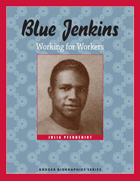 Blue Jenkins: Working for Workers
Julia Pferdehirt
Wisconsin Historical Society Press, 2011 When William "Blue" Jenkins was only six months old, he moved with his parents from a Mississippi sharecropper’s farm to the industrial city of Racine, Wisconsin with dreams of a new life. As an African-American in the pre–civil rights era, Blue came face to face with racism: the Ku Klux Klan hung a black figure in effigy from a tree in the Jenkins family’s yard. Growing up, Blue knew where blacks could shop, eat, and get a job in Racine—and where they couldn’t. The injustices that confronted Blue in his young life would drive his desire to make positive changes to his community and workplace in adulthood.
This addition to the Badger Biographies series shares Blue Jenkins’s story as it acquaints young readers with African-American and labor history. Following an all-star career as a high school football player, Blue became involved in unions through his work at Belle City Malleable. As World War II raged on, he participated in the home-front battle against discrimination in work, housing, and economic opportunity. When Blue became president of the union at Belle City, he organized blood drives and fought for safety regulations. He also helped to integrate labor union offices. In 1962, he became president of the U.A.W. National Foundry in the Midwest, and found himself in charge of 50,000 foundry union members.
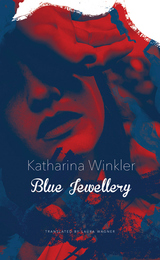 Blue Jewellery
Katharina Winkler
Seagull Books, 2018 Now in paperback, Katharina Winkler’s heartbreaking saga of a tenacious woman trapped in an abusive marriage.
Blue jewelry is private property. Not to be seen. Not to be talked about. It is worn like a bracelet around the wrists, on ribs, legs, arms. Blue jewelry is another name for the marks left on women’s bodies, inflicted by the men around them.
This novel tells the story of Filiz and Yunus. When Filiz meets Yunus, he is young and beautiful, and Filiz is proud that he wants her. Against her father’s wishes, they marry when she is thirteen. Yunus is her entire universe, all encompassing, all powerful. Soon after the wedding, Filiz’s dream of living in the West with her husband, of escaping their small village in Anatolia for freedom and autonomy, comes crashing down around her. Yunus, only a few years older than his bride, turns their marriage into a prison of dependency and violence. Trapped in her mother-in-law’s house, Filiz is subjected to physical and mental abuse, forced to veil herself, and treated as a house slave. When she becomes pregnant, Filiz seems to have reached her breaking point. But she endures. When Yunus moves his young family first to Istanbul and then to Austria, the life he had once promised her seems to be within reach. But there is no escaping the spiral of violence and love, which, to Filiz, have become inseparable.
Katharina Winkler’s powerful story of a marriage dominated by violence gives voice to a tenacious young woman whose will to survive is never broken.
 Blue Juice: Euthanasia in Veterinary Medicine
Patricia Morris
Temple University Press, 2012 Offering a candid behind-the-scenes look at small-animal veterinary practices, Blue Juice explores the emotional and ethical conflicts involved in providing a "good death" for companion animals. Patricia Morris presents a nuanced ethnographic account of how veterinarians manage patient care and client relations when their responsibility shifts from saving an animal's life to negotiating a decision to end it.
Using her own experiences and observations in veterinary settings as well as the voices of seasoned and novice vets, Morris reveals how veterinarians think about euthanasia and why this "dirty work" often precipitates "burnout," moral quandaries, and even tense or emotional interactions with clients. Closely observing these interactions, Morris illuminates the ways in which euthanasia reflects deep and unresolved tension in human-animal relationships.
Blue Juice seeks to understand how practitioners, charged with the difficult task of balancing the interests of animals and their humans, deal with the responsibility of ending their patients' lives.
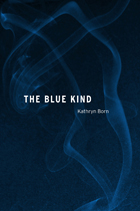 The Blue Kind
Kathryn Born
Northern Illinois University Press, 2012 In Neom the laws of physics are lax and everyone still gets high. The city squares do it so they can keep working non-stop. The hipsters do it so they can accept things as they are and not how they want them to be. And for a thousand years, Alison has done it to cope with the burdens of immortality. If you can’t die, she says, at least you can be as stoned as the living dead.
So begins The Blue Kind, a dystopian drug-fantasy that unfolds in the apocalyptic debris of an all but unrecognizable American city. In the wake of Drug War II, all the soldiers have become dealers and all the women have become collateral for the intoxicants they both peddle and pop like Skittles. But a powerful new drug is rumored to top them all, one that will fix everything wrong with Alison’s life, but one that is cooked and sold by her fiercest adversary: a dealer who threatens to destroy her entire world.
Brimming with a rich and labyrinth plot, indelible characters, and an unforgettable ending, Something Blue is as wild a ride as they come: a free-wheeling read about the cycle of addiction that is, itself, addictive.
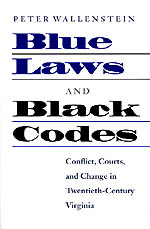 Blue Laws and Black Codes: Conflict, Courts, and Change in Twentieth-Century Virginia
Peter Wallenstein
University of Virginia Press, 2004 Women were once excluded everywhere from the legal profession, but by the 1990s the Virginia Supreme Court had three women among its seven justices. This is just one example of how law in Virginia has been transformed over the past century, as it has across the South and throughout the nation.
In Blue Laws and Black Codes, Peter Wallenstein shows that laws were often changed not through legislative action or constitutional amendment but by citizens taking cases to state and federal courtrooms. Due largely to court rulings, for example, stores in Virginia are no longer required by "blue laws" to close on Sundays.
Particularly notable was the abolition of segregation laws, modified versions of southern states' "black codes" dating back to the era of slavery and the first years after emancipation. Virginia's long road to racial equality under the law included the efforts of black civil rights lawyers to end racial discrimination in the public schools, the 1960 Richmond sit-ins, a case against segregated courtrooms, and a court challenge to a law that could imprison or exile an interracial couple for their marriage.
While emphasizing a single state, Blue Laws and Black Codes is framed in regional and national contexts. Regarding blue laws, Virginia resembled most American states. Regarding racial policy, Virginia was distinctly southern. Wallenstein shows how people pushed for changes in the laws under which they live, love, work, vote, study, and shop--in Virginia, the South, and the nation.
--------------------------------------------------------------------------------
Peter Wallenstein teaches history at Virginia Polytechnic Institute and State University. His previous books include Tell the Court I Love My Wife: Race, Marriage, and Law--An American History.
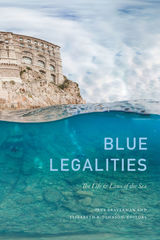 Blue Legalities: The Life and Laws of the Sea
Irus Braverman and Elizabeth R. Johnson, editors
Duke University Press, 2019 The ocean and its inhabitants sketch and stretch our understandings of law in unexpected ways. Inspired by the blue turn in the social sciences and humanities, Blue Legalities explores how regulatory frameworks and governmental infrastructures are made, reworked, and contested in the oceans. Its interdisciplinary contributors analyze topics that range from militarization and Maori cosmologies to island building in the South China Sea and underwater robotics. Throughout, Blue Legalities illuminates the vast and unusual challenges associated with regulating the turbulent materialities and lives of the sea. Offering much more than an analysis of legal frameworks, the chapters in this volume show how the more-than-human ocean is central to the construction of terrestrial institutions and modes of governance. By thinking with the more-than-human ocean, Blue Legalities questions what we think we know—and what we don’t know—about oceans, our earthly planet, and ourselves.
Contributors. Stacy Alaimo, Amy Braun, Irus Braverman, Holly Jean Buck, Jennifer L. Gaynor, Stefan Helmreich, Elizabeth R. Johnson, Stephanie Jones, Zsofia Korosy, Berit Kristoffersen, Jessica Lehman, Astrida Neimanis, Susan Reid, Alison Rieser, Katherine G. Sammler, Astrid Schrader, Kristen L. Shake, Phil Steinberg
The Blue Light
Hussein Barghouthi
Seagull Books, 2023 The Blue Light is an autobiographical novel in chapters and vignettes that travels through memory, time, and language.
Hussein Bargouthi tells his story with Bari, a Turkish American Sufi, during Bargouthi’s years as a graduate student at the University of Washington in the late 1980s. The Blue Light has several beginnings and many returns—from Beirut’s traumatic sea to musings on color and identity, from Buddhist paths to Rajneesh disciples, from military rule to colonial insanity, from drug addiction to sacred rock. Written and lived between Arabic and English, this is a unique book whose depth is as clear as its surface. It will tempt you to dismiss it as it compels you to devour it for illumination. Merging memoir with fiction, and the hallowed with the profane, The Blue Light is a meditation on and liberation from madness—a brilliant, inimitable literary achievement.
Blue Like The Heavens: New and Selected Poems
Gary Gildner
University of Pittsburgh Press, 2024 “Aliveness is Gary Gildner’s striking quality,” Crystal McLean writes in the magazine New Letters, and thise selection of Gary Gildner’s previously published poems, plus eighteen new poems, demonstrates the aptness of that perception. Accessible and eminently readable, the poems in Blue Like the Heavens also possess great emotional depth. Readers who complain about the obscurity of contemporary American poetry will delight in this book.
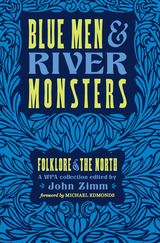 Blue Men and River Monsters: Folklore of the North
John Zimm
Wisconsin Historical Society Press, 2014 The north is a treasure trove of folklore. From magical creatures of the old country to legends of the mysterious and macabre, such lore is a fascinating record of the stories people held on to and the customs, foods, and cures that filled their lives. Collected in the 1930s as part of the Federal Writers’ Program, a Depression-era works project, these are the stories of Norwegian and Swiss immigrants, Native American medicine men and storytellers, and pioneers with memories of the earliest days of settlement in the Old Northwest. In search of stories, legends, songs, and other scraps of traditional knowledge, researchers fanned out across Wisconsin and other states. The resulting handwritten notes, thousands of pages in length, capture history as people remembered it. Blue Men and River Monsters collects the most interesting and noteworthy of these tales, placing them alongside stunning artwork collected by the Federal Art Project in Wisconsin. Peruse these pages and discover a new history of the people and places of the old north.
Blue Mistaken for Sky
Andrea Hollander
Autumn House Press, 2018 Award-winning author Andrea Hollander’s fifth full-length poetry collection explores a mature woman’s life after divorce. The poems are unselfconscious, and they detail with grace the pleasures and difficulties of aging, and the evolution of personal relationships through a life.
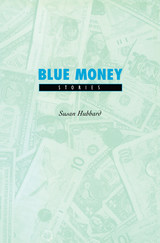 Blue Money: Stories
Stories by Susan Hubbard
University of Missouri Press, 1999 A union organizer returns to her hometown and her high school sweetheart, only to discover unexpected peril. A middle-aged man walks to meet his wife at work one day and loses her forever. A young writer's stage fright destroys her work and her marriage but offers her a new life. In Blue Money, Susan Hubbard creates a world in which the most ordinary things can be magical, and the most ordinary people can be extraordinary. "Selling the House" is the enchanting story of Marianne, a young housewife whose life is altered forever by a mysterious stranger. He suddenly appears on her doorstep one morning, offers to buy her home, quotes poetry, and just as suddenly disappears. Marianne soon discovers, however, that the stranger wants more than her house—he wants her. Although she does not accept the man's proposition, Marianne has been changed by it. His words echo throughout her life. "If she sometimes had trouble sleeping, if she spent more time reading poetry or staring out the window . . . well, those were small aberrations in an otherwise quite satisfactory life." Strangers appear and disappear in Blue Money. Shoes charm and cure. A soiled shirt conjures conscience, and a clean one promises new identity. Hubbard brilliantly weaves these fantastic elements into the fabric of her fiction. Women's relationships with men—whether they be fathers, lovers, or strangers—are a prominent theme of Hubbard's collection. "What Friends Are For" captures this theme at its most humorous and bizarre in the strange mishaps of two young girls trying to rid their lives of the stepfathers they despise. When their plan fails miserably, the girls are forced to accept the unwanted men, but not without finding brief comfort in the humor of their failure. "Then I start laughing too--a laugh I've never laughed before, like some exotic bird, high and shrill and free—and now [we're] laughing so hard that the voices outside fade away entirely." Praised by Ploughshares as "an assured storyteller and a complex narrative stylist," Hubbard excels at writing spare yet powerfully evocative prose. Haunting in its suspense and subtle grace, Blue Money celebrates Hubbard's marvelous ability to explore the power of imagination.
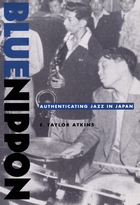 Blue Nippon: Authenticating Jazz in Japan
E. Taylor Atkins
Duke University Press, 2001 Japan’s jazz community—both musicians and audience—has been begrudgingly recognized in the United States for its talent, knowledge, and level of appreciation. Underpinning this tentative admiration, however, has been a tacit agreement that, for cultural reasons, Japanese jazz “can’t swing.” In Blue Nippon E. Taylor Atkins shows how, strangely, Japan’s own attitude toward jazz is founded on this same ambivalence about its authenticity.
Engagingly told through the voices of many musicians, Blue Nippon explores the true and legitimate nature of Japanese jazz. Atkins peers into 1920s dancehalls to examine the Japanese Jazz Age and reveal the origins of urban modernism with its new set of social mores, gender relations, and consumer practices. He shows how the interwar jazz period then became a troubling symbol of Japan’s intimacy with the West—but how, even during the Pacific war, the roots of jazz had taken hold too deeply for the “total jazz ban” that some nationalists desired. While the allied occupation was a setback in the search for an indigenous jazz sound, Japanese musicians again sought American validation. Atkins closes out his cultural history with an examination of the contemporary jazz scene that rose up out of Japan’s spectacular economic prominence in the 1960s and 1970s but then leveled off by the 1990s, as tensions over authenticity and identity persisted.
With its depiction of jazz as a transforming global phenomenon, Blue Nippon will make enjoyable reading not only for jazz fans worldwide but also for ethnomusicologists, and students of cultural studies, Asian studies, and modernism.
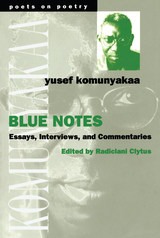 Blue Notes: Essays, Interviews, and Commentaries
Yusef Komunyakaa
University of Michigan Press, 2000 Blue Notes offers an assortment of poet Yusef Komunyakaa's writing on contemporary poetry and music. The book is arranged in four sections. The first gathers essays on the work of poets and blues and jazz musicians influential to Komunyakaa's work, from Langston Hughes and Etheridge Knight to Ma Rainey and Thelonious Monk; the second collects a gallery of Komunyakaa's poems and the poet's commentary about each of them. The third selects interviews that reveal the development of the poet's aesthetic sensibility. The final section consists of four artistic explorations that reflect the poet's current interests. Two of of these texts, "Tenebrae" and "Buddy's Monologue," have been recently performed.
As editor Radiclani Clytus makes clear in the volume's introductory essay, although Komunyakaa's poetry has its roots in the stylistic innovations of early twentieth-century American modernists, his writing often reflects his understanding that a "black" experience should not particularize the presentation of one's art. This volume, according to the editor, is an attempt to understand Komunyakaa's critical eclecticism within the context of his own words.
Yusef Komunyakaa's books of poetry include I Apologize for the Eyes in My Head, Magic City, Thieves of Paradise, and Neon Vernacular, for which he received the Pulitzer Prize and the Kingsley Tufts Poetry Award in 1994.
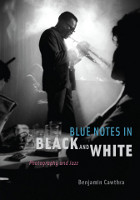 Blue Notes in Black and White: Photography and Jazz
Benjamin Cawthra
University of Chicago Press, 2011 Miles Davis, supremely cool behind his shades. Billie Holiday, eyes closed and head tilted back in full cry. John Coltrane, one hand behind his neck and a finger held pensively to his lips. These iconic images have captivated jazz fans nearly as much as the music has. Jazz photographs are visual landmarks in American history, acting as both a reflection and a vital part of African American culture in a time of immense upheaval, conflict, and celebration. Charting the development of jazz photography from the swing era of the 1930s to the rise of black nationalism in the ’60s, Blue Notes in Black and White is the first of its kind: a fascinating account of the partnership between two of the twentieth century’s most innovative art forms. Benjamin Cawthra introduces us to the great jazz photographers—including Gjon Mili, William Gottlieb, Herman Leonard, Francis Wolff, Roy DeCarava, and William Claxton—and their struggles, hustles, styles, and creative visions. We also meet their legendary subjects, such as Duke Ellington, sweating through a late-night jam session for the troops during World War II, and Dizzy Gillespie, stylish in beret, glasses, and goatee. Cawthra shows us the connections between the photographers, art directors, editors, and record producers who crafted a look for jazz that would sell magazines and albums. And on the other side of the lens, he explores how the musicians shaped their public images to further their own financial and political goals. This mixture of art, commerce, and racial politics resulted in a rich visual legacy that is vividly on display in Blue Notes in Black and White. Beyond illuminating the aesthetic power of these images, Cawthra ultimately shows how jazz and its imagery served a crucial function in the struggle for civil rights, making African Americans proudly, powerfully visible.
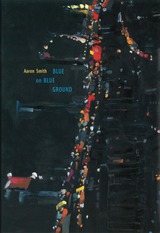 Blue on Blue Ground
Aaron Smith
University of Pittsburgh Press, 2005
Winner of the 2004 Agnes Lynch Starrett Poetry Prize
Blue on Blue Ground is about the body, desire, anxiety, and obsession—how what we want redeems and isolates us (and is sometimes used against us). These poems are artful yet accessible, lyrical yet direct, strange but recognizable.
Smith’s relentless self-examination, fear, sense of humor, and vulnerability are all laid to bare in crisp, precise language. From lonely observations, bizarre medical fascinations, emotion, loss, and honesty, Blue on Blue Ground constructs its internal and external worlds.
The metaphorical city is also a “body,” a place of exile and restoration, a symbol of hope, a catalyst for connection. The urban landscape is often the background for the moment or is the moment itself—the world looked at and sorted into words.
Though at times dark, there’s love to be found. Perhaps it’s what drives this collection, colors its observations, and leads it to finally announce: “Someone is putting the world back together.” <I>Blue on Blue Ground</I> wants to look at absolutely everything and believes that complete exploration of the physical and mental selves—fears and desires—is the key to moving and being completely alive in the material world.
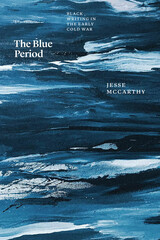 The Blue Period: Black Writing in the Early Cold War
Jesse McCarthy
University of Chicago Press, 2024 Addresses the political and aesthetic evolution of African American literature and its authors during the Cold War, an era McCarthy calls “the Blue Period.”
In the years after World War II, to be a black writer was to face a stark predicament. The contest between the Soviet Union and the United States was a global one—an ideological battle that dominated almost every aspect of the cultural agenda. On the one hand was the Soviet Union, espousing revolutionary communism that promised egalitarianism while being hostile to conceptions of personal freedom. On the other hand was the United States, a country steeped in racial prejudice and the policies of Jim Crow.
Black writers of this time were equally alienated from the left and the right, Jesse McCarthy argues, and they channeled that alienation into remarkable experiments in literary form. Embracing racial affect and interiority, they forged an aesthetic resistance premised on fierce dissent from both US racial liberalism and Soviet communism. From the end of World War II to the rise of the Black Power movement in the 1960s, authors such as Richard Wright, James Baldwin, Gwendolyn Brooks, and Paule Marshall defined a distinctive moment in American literary culture that McCarthy terms the Blue Period.
In McCarthy’s hands, this notion of the Blue Period provides a fresh critical framework that challenges long-held disciplinary and archival assumptions. Black writers in the early Cold War went underground, McCarthy argues, not to depoliticize or liberalize their work, but to make it more radical—keeping alive affective commitments for a future time.
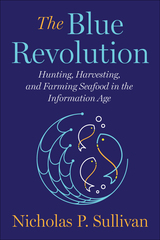 The Blue Revolution: Hunting, Harvesting, and Farming Seafood in the Information Age
Nicholas P. Sullivan
Island Press, 2022 Overfishing. For the world’s oceans, it’s long been a worrisome problem with few answers. Many of the global fish stocks are at a dangerous tipping point, some spiraling toward extinction. But as older fishing fleets retire and new technologies develop, a better, more sustainable way to farm this popular protein has emerged to profoundly shift the balance. The Blue Revolution tells the story of the recent transformation of commercial fishing: an encouraging change from maximizing volume through unrestrained wild hunting to maximizing value through controlled harvesting and farming. Entrepreneurs applying newer, smarter technologies are modernizing fisheries in unprecedented ways. In many parts of the world, the seafood on our plates is increasingly the product of smart decisions about ecosystems, waste, efficiency, transparency, and quality.
Nicholas P. Sullivan presents this new way of thinking about fish, food, and oceans by profiling the people and policies transforming an aging industry into one that is “post-industrial”—fueled by “sea-foodies” and locavores interested in sustainable, traceable, quality seafood. Catch quotas can work when local fishers feel they have a stake in the outcome; shellfish farming requires zero inputs and restores nearshore ecosystems; new markets are developing for kelp products, as well as unloved and “underutilized” fish species. Sullivan shows how the practices of thirty years ago that perpetuated an overfishing crisis are rapidly changing. In the book’s final chapters, Sullivan discusses the global challenges to preserving healthy oceans, including conservation mechanisms, the impact of climate change, and unregulated and criminal fishing in international waters.
In a fast-growing world where more people are eating more fish than ever before, The Blue Revolution brings encouraging news for conservationists and seafood lovers about the transformation of an industry historically averse to change, and it presents fresh inspiration for entrepreneurs and investors eager for new opportunities in a blue-green economy.
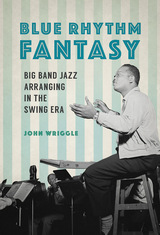 Blue Rhythm Fantasy: Big Band Jazz Arranging in the Swing Era
John Wriggle
University of Illinois Press, 2016 Behind the iconic jazz orchestras, vocalists, and stage productions of the Swing Era lay the talents of popular music's unsung heroes: the arrangers. John Wriggle takes you behind the scenes of New York City's vibrant entertainment industry of the 1930s and 1940s to uncover the lives and work of jazz arrangers, both black and white, who left an indelible mark on American music and culture. Blue Rhythm Fantasy traces the extraordinary career of arranger Chappie Willet--a collaborator of Louis Armstrong, Cab Calloway, Duke Ellington, Gene Krupa, and many others--to revisit legendary Swing Era venues and performers from Harlem to Times Square. Wriggle's insightful music analyses of big band arranging techniques explore representations of cultural modernism, discourses on art and commercialism, conceptions of race and cultural identity, music industry marketing strategies, and stage entertainment variety genres. Drawing on archives, obscure recordings, untapped sources in the African American press, and interviews with participants, Blue Rhythm Fantasy is a long-overdue study of the arranger during this dynamic era of American music history.
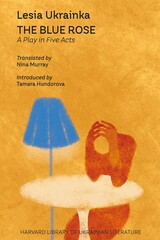 The Blue Rose: A Play in Five Acts
Lesia Ukrainka
Harvard University Press Where is the line that separates the “normal” from the “abnormal”? Liubov, a young Ukrainian woman of small nobility, struggles with this question in Lesia Ukrainka’s The Blue Rose. Living in Ukraine at the turn of the twentieth century, she finds herself outside the norms for a woman: she reads “thick books,” follows music and art, and is interested in science and psychology. She hosts a salon and challenges men in discussions about politics and culture. Liubov is also an orphan whose mother died in an asylum, and she worries about inheriting her mother’s disease as well as passing it on to future children. When Liubov falls in love with Orest, she proposes a radical solution to her dilemma: to pursue something as rare as a blue flower—“pure love” that foregoes the physical and abandons the requirement of marriage and motherhood.
In her commanding debut as a playwright, Ukrainka created a deep psychological rendering of an unattainable ideal. The Blue Rose highlights themes such as women’s struggles for liberation, social progress and its reliance on science, and resistance to change in traditional societies. Written in sophisticated Ukrainian, Ukrainka’s nuanced play helped Ukrainian culture break free of the Russian imperial mold that sought to first provincialize and then erase it. Presented here in contemporary English translation, The Blue Rose illuminates Ukraine’s intellectual history and its connections with Western culture.
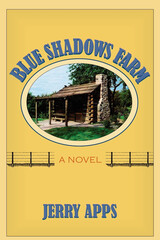 Blue Shadows Farm: A Novel
Jerry Apps
University of Wisconsin Press, 2009 Fans of Jerry Apps will delight in his latest novel, Blue Shadows Farm, which follows the intriguing family story of three generations on a Wisconsin farm.
Silas Starkweather, a Civil War veteran, is drawn to Wisconsin and homesteads 160 acres in Ames County, where he is known as the mysterious farmer forever digging holes. After years of hardship and toil, however, Silas develops a commitment to farming his land and respect for his new community. When Silas’s son Abe inherits Blue Shadows Farm he chooses to keep the land out of reluctant necessity, distilling and distributing “purified corn water” throughout Prohibition and the Great Depression in order to stay solvent. Abe’s daughter, Emma, willingly takes over the farm after her mother’s death. Emma’s love for this place inspires her to open the farm to school-children and families who share her respect for it. As she considers selling the land, Emma is confronted with a difficult question—who, through thick and thin, will care for Blue Shadows Farm as her family has done for over a century? In the midst of a controversy that disrupts the entire community, Emma looks into her family’s past to help her make crucial decisions about the future of its land.
Through the story of the Starkweather family’s changing fortunes, and each generation’s very different relationship with the farm and the land, Blue Shadows Farm is in some ways the narrative of all farmers and the increasingly difficult challenges they face as committed stewards of the land.
Finalist, General Fiction, Midwest Book Awards
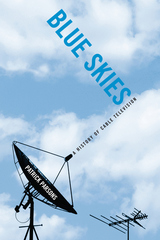 Blue Skies: A History of Cable Television
Patrick R. Parsons
Temple University Press, 2008 Cable television is arguably the dominant mass media technology in the U.S. today. Blue Skies traces its history in detail, depicting the important events and people that shaped its development, from the precursors of cable TV in the 1920s and '30s to the first community antenna systems in the 1950s, and from the creation of the national satellite-distributed cable networks in the 1970s to the current incarnation of "info-structure" that dominates our lives. Author Patrick Parsons also considers the ways that economics, public perception, public policy, entrepreneurial personalities, the social construction of the possibilities of cable, and simple chance all influenced the development of cable TV.
Since the 1960s, one of the pervasive visions of "cable" has been of a ubiquitous, flexible, interactive communications system capable of providing news, information, entertainment, diverse local programming, and even social services. That set of utopian hopes became known as the "Blue Sky" vision of cable television, from which the book takes its title.
Thoroughly documented and carefully researched, yet lively, occasionally humorous, and consistently insightful, Blue Skies is the genealogy of our media society.
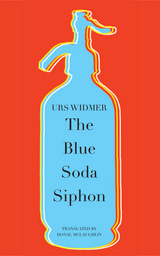 The Blue Soda Siphon
Urs Widmer
Seagull Books, 2014 A magnificent example of Widmer’s characteristic humor, literary genius, and unparalleled imagination.
In the wildly entertaining novel The Blue Soda Siphon, the narrator unexpectedly finds himself back in the world of his childhood: Switzerland in the 1940s. He returns to his childhood home to find his parents frantic because their son is missing. Then, in another switch, the young boy that he was back then turns up in the present of the early 1990s, during the Gulf War, where he meets himself as an older man, and meets his adult self’s young daughter. These head-scratching, hilarious time shifts happen when both the adult narrator and his childhood self go to the cinema and see films, the subjects of which echo their own lives.
Translated into English for the first time by Donal McLaughlin, this novel, in which the eponymous blue soda siphon bottle is a recurring symbol, is a magnificent example of Urs Widmer’s characteristic humor, literary genius, and unparalleled imagination.
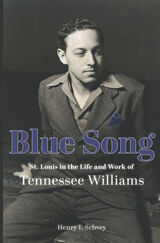 Blue Song: St. Louis in the Life and Work of Tennessee Williams
Henry I. Schvey
University of Missouri Press, 2022 In 2011, the centennial of Tennessee Williams’s birth, events were held around the world honoring America’s greatest playwright. There were festivals, conferences, and exhibitions held in places closely associated with Williams’s life and career—New Orleans held major celebrations, as did New York, Key West, and Provincetown. But absolutely nothing was done to celebrate Williams’s life and extraordinary literary and theatrical career in the place that he lived in longest, and called home longer than any other—St. Louis, Missouri.
The question of this paradox lies at the heart of this book, an attempt not so much to correct the record about Williams’s well-chronicled dislike of the city, but rather to reveal how the city was absolutely indispensable to his formation and development both as a person and artist. Unlike the prevailing scholarly narrative that suggests that Williams discovered himself artistically and sexually in the deep South and New Orleans, Blue Song reveals that Williams remained emotionally tethered to St. Louis for a host of reasons for the rest of his life.
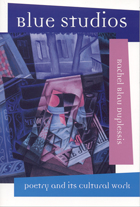 Blue Studios: Poetry and Its Cultural Work
Rachel Blau DuPlessis
University of Alabama Press, 2006 Examines the work of experimental poets and the innovative forms they create to disrupt assumptions about gender and cultural power In her now-classic The Pink Guitar, Rachel Blau DuPlessis examined a number of modern and contemporary poets and artists to explore the possibility of finding a language that would question deeply held assumptions about gender. In the 12 essays and introduction that constitute Blue Studios, DuPlessis continues that task, examining the work of experimental poets and the innovative forms they have fashioned to challenge commonplace assumptions about gender and cultural authority. The essays in “Attitudes and Practices” deal with two questions: what a feminist reading of cultural texts involves, and the nature of the essay itself as a mode of knowing: how poetry can be discursive and how the essay can be poetic. The goal of “Marble Paper,” with its studies of William Wordsworth, Ezra Pound, and Charles Olson is to suggest terms for a “feminist history of poetry.” “Perspectives must be fashioned that displace and estrange the world,” Theodore Adorno wrote, and in the section "Urrealism" DuPlessis examines the work of poets from several schools (the Objectivists, the New York School, the surrealists) whose work embodies that displacement, among them George Oppen, Lorine Niedecker, H.D., and Barbara Guest. These writers’ radical deployment of line, sound, and structure, DuPlessis argues, demonstrate poetry’s power not as a purely literary, artistic, or aesthetic force but as a rhetorical form intricately tied to issues of power and ethics. And in "Migrated Into,” the author probes the ways these issues have informed her, as a poet and a critic; how the political has “migrated into” and suffused her own work; and how the practice of poetry can be an arousal to a deeper understanding of what we stand for.
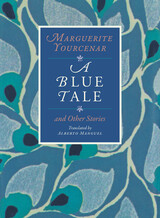 A Blue Tale and Other Stories
Marguerite Yourcenar
University of Chicago Press, 1995 This story collection is a welcome port of entry for any reader not yet familiar with Marguerite Yourcenar’s works.
Published to great acclaim in France in 1993, this collection is not only a delight for Marguerite Yourcenar fans but a welcome port of entry for any reader not yet familiar with the author's lengthier, more demanding works. This collection includes three stories written between 1927 and 1930 when the author was in her mid-twenties. These stories cover a range of themes, from an allegory on greed and a scene from the war of the sexes to a witch hunt that obsessively creates its own quarry.
For the devoted readers of Yourcenar, this collection allows a rare glimpse at the beginnings of a writer's craft. In these accomplished but forgotten pieces, edited and introduced by her biographer, Josyane Savigneau, readers will find the blend of fable and fairy tale of Oriental Tales, the psychological chronicle of Dear Departed, and the ironic realism of A Coin in Nine Hands. Read as an introduction to Yourcenar's work, the stories take us into the writer's workshop, as it were, to the early days of creation. A Blue Tale and Other Stories carries the unmistakable voice of a formidable and vastly talented writer.
Marguerite Yourcenar (her pseudonym was an anagram of her family name, Crayencour) was born in Brussels in 1903 and died in Maine in 1987. One of the most respected writers in the French language, she is best known as the author of the acclaimed Memoirs of Hadrian and The Abyss. She was awarded many literary honors, most notably election to the Académie Française in 1980, the first woman so honored.
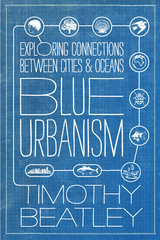 Blue Urbanism: Exploring Connections Between Cities and Oceans
Timothy Beatley
Island Press, 2014 What would it mean to live in cities designed to foster feelings of connectedness to the ocean? As coastal cities begin planning for climate change and rising sea levels, author Timothy Beatley sees opportunities for rethinking the relationship between urban development and the ocean. Modern society is more dependent upon ocean resources than people are commonly aware of—from oil and gas extraction to wind energy, to the vast amounts of fish harvested globally, to medicinal compounds derived from sea creatures, and more. In Blue Urbanism, Beatley argues that, given all we’ve gained from the sea, city policies, plans, and daily urban life should acknowledge and support a healthy ocean environment.
The book explores issues ranging from urban design and land use, to resource extraction and renewable energy, to educating urbanites about the wonders of marine life. Beatley looks at how emerging practices like “community supported fisheries” and aquaponics can provide a sustainable alternative to industrial fishing practices. Other chapters delve into incentives for increasing use of wind and tidal energy as renewable options to oil and gas extraction that damages ocean life, and how the shipping industry is becoming more “green.” Additionally, urban citizens, he explains, have many opportunities to interact meaningfully with the ocean, from beach cleanups to helping scientists gather data.
While no one city “has it all figured out,” Beatley finds evidence of a changing ethic in cities around the world: a marine biodiversity census in Singapore, decreasing support for shark-finning in Hong Kong, “water plazas” in Rotterdam, a new protected area along the rocky shore of Wellington, New Zealand, “bluebelt” planning in Staten Island, and more. Ultimately he explains we must create a culture of “ocean literacy” using a variety of approaches, from building design and art installations that draw inspiration from marine forms, to encouraging citizen volunteerism related to oceans, to city-sponsored research, and support for new laws that protect marine health.
Equal parts inspiration and practical advice for urban planners, ocean activists, and policymakers, Blue Urbanism offers a comprehensive look at the challenges and great potential for urban areas to integrate ocean health into their policy and planning goals.
Blue Venom and Forbidden Incense: Two Novellas
Syed Shamsul Haq
Seagull Books, 2018 Bangladesh in 1971 showed vividly, and terribly, the deadly effects of war. Piles of corpses, torture cells, ash and destruction everywhere in the wake of the Pakistani army’s attacks on Bengali people. Blue Venom and Forbidden Incense, two novellas by Bangladeshi writer Syed Shamsul Haq, bear bleak witness to the mindless violence and death of that period. Blue Venom tells of a middle-aged middle manager who is arrested and taken to a cell, where he is slowly tortured to death for being a namesake of a rebel poet Kazi Nazrul Islam. Forbidden Incense, meanwhile, tells of a woman’s return to her paternal village after her husband was taken by the army. In the village, she meets a boy with a Muslim name whose entire family has been killed; as they attempt together to gather and bury scattered corpses, they, too, are caught by the killers.
Blue Yodel
Eleanor Stanford
Carnegie Mellon University Press, 2024 A new poetry collection from Eleanor Stanford that is musical, sexy, and darkly funny.
These poems take the reader from Mexico City to West Philadelphia to Karachi. The works wade into the difficult joys of mothering, self-exploration, and romantic entanglement in midlife. Throughout, Eleanor Stanford embraces the mysticism of Hildegard of Bingen, the abjection of Tammy Wynette, and the wry self-appraisal of Sylvia Plath, fashioning it all into something entirely its own.
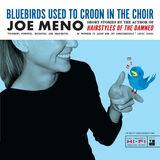 Bluebirds Used to Croon in the Choir: Stories
Joe Meno
Northwestern University Press, 2007 Winner of 2006 The Society of Midland Authors Adult Fiction Award
Children who anesthetize—and dress up—small wild animals in an ill-fated attempt to cheer their grieving mother; childhood friends who ritually return every year to the site of their near-kidnapping; an awkward teen trying to find his place among the cultural ruins of Greek Mythology Camp; brothers brought together, if not by mutual understanding, by a strange need to steal airport baggage: these are some of the characters who inhabit—and invariably tell—the stories in Joe Meno's Bluebirds Used to Croon in the Choir. Oddballs and charmers and would-be lovers, they are souls not so much lost as wandering, looking for something better, almost getting laid, trying to explain or, if all else fails, to entertain—and this they unfailingly do. Rarely has fiction so understated produced such hilarity and heartbreak.
Novelist, music journalist, and playwright Meno writes squarely in the American tradition of wringing large effects from small change, revealing the subtlety in the broad stroke, and conveying complexity with seeming simplicity. Celebrated for its "unflinching honesty" (Entertainment Weekly) and for its "poetic and visceral style" (Booklist), his work resonates with the unmistakable magic and curious mystery of modern life.
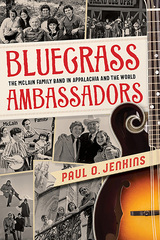 Bluegrass Ambassadors: The McLain Family Band in Appalachia and the World
Paul O. Jenkins
West Virginia University Press, 2020 Bluegrass Ambassadors is the first book-length study of the McLain Family Band, which has spread the gospel of bluegrass for more than fifty years. Rooted in bluegrass but also collaborating with classical composers and performing folk, jazz, gospel, and even marches, the band traveled to sixty-two foreign countries in the 1970s under the auspices of the State Department. The band’s verve and joyful approach to its art perfectly suited its ambassadorial role. After retiring as full-time performers, most members of the group became educators, with patriarch Raymond K. McLain’s work at Berea College playing a particularly important role in bringing bluegrass to the higher education curriculum.
Interpreting the band’s diverse repertoire as both a source of its popularity and a reason for its exclusion from the bluegrass pantheon, Paul Jenkins advances subtle arguments about genre, criticism, and audience. Bluegrass Ambassadors analyzes the McLains’ compositions, recordings, and performances, and features a complete discography.
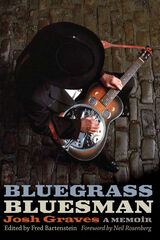 Bluegrass Bluesman: A Memoir
Josh Graves; Edited by Fred Bartenstein; Foreword by Neil Rosenberg
University of Illinois Press, 2012 A pivotal member of the hugely successful bluegrass band Flatt and Scruggs and the Foggy Mountain Boys, Dobro pioneer Josh Graves (1927-2006) was a living link between bluegrass music and the blues. In Bluegrass Bluesman, this influential performer shares the story of his lifelong career in music. In lively anecdotes, Graves describes his upbringing in East Tennessee and the climate in which bluegrass music emerged during the 1940s. Deeply influenced by the blues, he adapted Earl Scruggs's revolutionary banjo style to the Dobro resonator slide guitar and gave the Foggy Mountain Boys their distinctive sound. Graves' accounts of daily life on the road through the 1950s and 1960s reveal the band's dedication to musical excellence, Scruggs' leadership, and an often grueling life on the road. He also comments on his later career when he played in Lester Flatt's Nashville Grass and the Earl Scruggs Revue and collaborated with the likes of Boz Scaggs, Charlie McCoy, Kenny Baker, Eddie Adcock, Jesse McReynolds, Marty Stuart, Jerry Douglas, Alison Krauss, and his three musical sons. A colorful storyteller, Graves brings to life the world of an American troubadour and the mountain culture that he never left behind. Born in Tellico Plains, Tennessee, Josh Graves (1927-2006) is universally acknowledged as the father of the bluegrass Dobro. In 1997 he was inducted into the Bluegrass Hall of Fame.
Bluegrass Breakdown: The Making of the Old Southern Sound
Robert Cantwell
University of Illinois Press, 1984 Bluegrass Breakdown is an expansive foray into the makings of bluegrass. More than any other book of its kind, it gets to the roots of a uniquely American music that is deeply linked to working-class ideals and romanticism. Robert Cantwell engages the historical background, commercial origins, internal workings, and cultural and social significance of popular, old-time music to provide a unique musicological and sociological perspective. Well-versed in the history of the tradition and equally as interested in those who listen to the music as in those who create it, Cantwell links bluegrass to its hillbilly roots in Appalachia and shows how the music was transformed by African American folk traditions, the influence of jazz, ragtime, blues, and country music, and the growth of radio and recording technology.
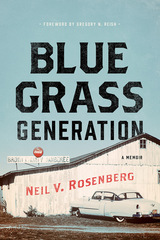 Bluegrass Generation: A Memoir
Neil V Rosenberg
University of Illinois Press, 2018 Neil V. Rosenberg met the legendary Bill Monroe at the Brown County Jamboree. Rosenberg's subsequent experiences in Bean Blossom put his feet on the intertwined musical and scholarly paths that made him a preeminent scholar of bluegrass music. Rosenberg's memoir shines a light on the changing bluegrass scene of the early 1960s. Already a fan and aspiring musician, his appetite for banjo music quickly put him on the Jamboree stage. Rosenberg eventually played with Monroe and spent four months managing the Jamboree. Those heights gave him an eyewitness view of nothing less than bluegrass's emergence from the shadow of country music into its own distinct art form. As the likes of Bill Keith and Del McCoury played, Rosenberg watched Monroe begin to share a personal link to the music that tied audiences to its history and his life--and helped turn him into bluegrass's foundational figure. An intimate look at a transformative time, Bluegrass Generation tells the inside story of how an American musical tradition came to be.
Bluegrass Odyssey: A Documentary in Pictures and Words, 1966-86
Carl Fleischhauer and Neil V. Rosenberg
University of Illinois Press, 2006 The fruit of four decades of collaboration between bluegrass music’s premier photographer and premier historian, Bluegrass Odyssey is a satisfying and visually alluring journey into the heart of a truly American music. Combining more than two hundred of Carl Fleischhauer’s photographs with Neil V. Rosenberg’s expert commentary, this elegant visual documentary captures the music-making with the culture and community that foster it.
The Bluegrass Reader
Edited by Thomas Goldsmith
University of Illinois Press, 2004 In The Bluegrass Reader, Thomas Goldsmith joins his insights as a journalist with a lifetime of experience in bluegrass to capture the full story of this beloved American music. Inspired by the question “What articles about bluegrass would you want to have with you on a desert island?” he assembled a delicious, fun-to-read collection that brings together a wide range of the very best in bluegrass writing. Goldsmith’s substantial introduction describes and traces the development of the music from its origins in Anglo-American folk tradition, overlaid with African American influences, to the breakout popularity of Ralph Stanley, Alison Krauss, and the O Brother, Where Art Thou? soundtrack. He introduces each selection offering a wealth of additional information, making The Bluegrass Reader both enjoyable and invaluable for new fans of the music as well as for its lifetime devotees.
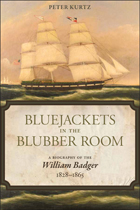 Bluejackets in the Blubber Room: A Biography of the William Badger,1828-1865
Kurtz, Peter
University of Alabama Press, 2013 Explores key events in US maritime history from the 1820s to the end of the Civil War through the biography of the sailing ship William Badger Taking a biographical approach to his subject, Peter Kurtz describes three phases of the life of the William Badger, a sailing ship with a long and exemplary life on the sea: first as a merchant ship carrying raw materials and goods between New England, the US South, and Europe; second as a whaling ship; and finally as a supply ship providing coal and stores for the North Atlantic Blockading Squadron in Beaufort, North Carolina, during the Civil War. Kurtz begins Bluejackets in the Blubber Room by exploring early American shipbuilding and shipbuilders in the Piscataqua region of Maine and New Hampshire and the kinds of raw materials harvested and used in making the wooden sailing ships of the time. After its construction, the Badger became part of the key economic trade between New England, the US South, and Europe. The ship carried raw materials such as timber from New England to New Orleans and subsequently cotton from New Orleans to Spain and Liverpool, England. Using ship logs, sailors’ accounts, and other primary sources, Kurtz delves into both the people and the economics of this critical “cotton triangle” trade. Following service as a merchant ship, the Badger became a whaling ship, carrying its New England–based crew as far as the South Pacific. Kurtz presents a colorful story of life aboard a whaling ship and in the whaling towns ranging from Lynn, Massachusetts, to Cape Leeuwin, Australia. Finally, Kurtz describes the last phase of the Badger’s life as a key player as a supply ship in the Union Navy’s blockade effort. Although not the most dramatic duty a sailor could have, blockade supply nevertheless was critical to the United States’ prosecution of the Civil War and eventual victory. Kurtz examines the decision-making involved in procuring such ships and their crew, notably “refugees” and escaped slaves known as “contrabands.”
The Blueness of the Evening: Selected Poems of Hassan Najmi
Mbarek Sryfi
University of Arkansas Press, 2018 This selection of Hassan Najmi’s poems, translated by Mbarek Sryfi and Eric Sellin, provides an excellent introduction to the work of one of Morocco’s foremost poets and to a school of modern verse emerging in the Arab World. Scenes of late night cityscapes, lonely interiors, awe-inspiring desert wastes, and seaside vistas are found within the exquisitely subtle lyric moods and nuances of Najmi’s ars poetica, providing insight into the geographical, political, and linguistic ferment that have made Morocco an exciting hub of creative activity in the twenty-first century.
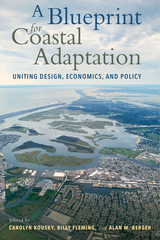 A Blueprint for Coastal Adaptation: Uniting Design, Economics, and Policy
Edited by Carolyn Kousky, Billy Fleming, and Alan M. Berger; foreword by Jeff Goodell
Island Press, 2021 Tens of millions of Americans are at risk from sea level rise, increased tidal flooding, and intensifying storms. The design and policy decisions that have shaped coastal areas are in desperate need of updates to help communities better adapt to a changing climate. A Blueprint for Coastal Adaptation identifies a bold new research and policy agenda and provides implementable options for coastal communities.
In this book, coastal adaptation experts discuss the interrelated challenges facing communities experiencing sea level rise and increasing storm impacts. These issues extend far beyond land use planning into housing policy, financing for public infrastructure, insurance, fostering healthier coastal ecosystems, and more. Deftly addressing far-reaching problems from cleaning up contaminated, abandoned sites, to changes in drinking water composition, chapters give a clear-eyed view of how we might yet chart a course for thriving coastal communities. They offer a range of climate adaptation policies that could protect coastal communities against increasing risk, while preserving the economic value of these locations, their natural environments, and their community and cultural values. Lessons are drawn from coastal communities around the United States to present equitable solutions. The book provides tools for evaluating necessary tradeoffs to think more comprehensively about the future of our coastal communities.
Coastal adaptation will not be easy, but planning for it is critical to the survival of many communities. A Blueprint for Coastal Adaptation will inspire innovative and cross-disciplinary thinking about coastal policy at the state and local level while providing actionable, realistic policy and planning options for adaptation professionals and policymakers.
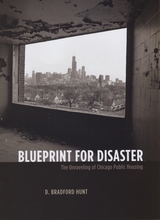 Blueprint for Disaster: The Unraveling of Chicago Public Housing
D. Bradford Hunt
University of Chicago Press, 2009 Now considered a dysfunctional mess, Chicago’s public housing projects once had long waiting lists of would-be residents hoping to leave the slums behind. So what went wrong? To answer this complicated question, D. Bradford Hunt traces public housing’s history in Chicago from its New Deal roots through current mayor Richard M. Daley’s Plan for Transformation. In the process, he chronicles the Chicago Housing Authority’s own transformation from the city’s most progressive government agency to its largest slumlord. Challenging explanations that attribute the projects’ decline primarily to racial discrimination and real estate interests, Hunt argues that well-intentioned but misguided policy decisions—ranging from design choices to maintenance contracts—also paved the road to failure. Moreover, administrators who fully understood the potential drawbacks did not try to halt such deeply flawed projects as Cabrini-Green and the Robert Taylor Homes. These massive high-rise complexes housed unprecedented numbers of children but relatively few adults, engendering disorder that pushed out the working class and, consequently, the rents needed to maintain the buildings. The resulting combination of fiscal crisis, managerial incompetence, and social unrest plunged the CHA into a quagmire from which it is still struggling to emerge. Blueprint for Disaster, then,is an urgent reminder of the havoc poorly conceived policy can wreak on our most vulnerable citizens.
 Blueprint for Greening Affordable Housing
Global Green USA
Island Press, 2007 Blueprint for Green Affordable Housing is a guide for housing developers, advocates, public agency staff, and the financial community that offers specific guidance on incorporating green building strategies into the design, construction, and operation of affordable housing developments. A completely revised and expanded second edition of the groundbreaking 1999 publication, this new book focuses on topics of specific relevance to affordable housing including: - how green building adds value to affordable housing
- the integrated design process
- best practices in green design for affordable housing
- green operations and maintenance
- innovative funding and finance
- emerging programs, partnerships, and policies
Edited by national green affordable housing expert Walker Wells and featuring a foreword by Matt Petersen, president and chief executive officer of Global Green USA, the book presents 12 case studies of model developments and projects, including rental, home ownership, special needs, senior, self-help, and co-housing from around the United States. Each case study describes the unique green features of the development, discusses how they were successfully incorporated, considers the project's financing and savings associated with the green measures, and outlines lessons learned. Blueprint for Green Affordable Housing is the first book of its kind to present information regarding green building that is specifically tailored to the affordable housing development community.
 Blueprint for Greening Affordable Housing, Revised Edition
Walker Wells and Kimberly Vermeer
Island Press, 2020 The lack of affordable housing and the climate crisis are two of the most pressing challenges facing cities today. Green affordable housing addresses both by providing housing stability, safety, and financial predictability while constructing and operating the buildings to reduce environmental and climate impacts.
Blueprint for Greening Affordable Housing is the most comprehensive resource on how green building principles can be incorporated into affordable housing design, construction, and operation. In this fully revised edition, Walker Wells and Kimberly Vermeer capture the rapid evolution of green building practices and make a compelling case for integrating green building in affordable housing. The Blueprint offers guidance on innovative practices, green building certifications for affordable housing, and the latest financing strategies. The completely new case studies share detailed insights on how the many elements of a green building are incorporated into different housing types and locations. Case studies include a geographical range, from high-desert homeownership, to southeast supportive housing, and net-zero family apartments on the coasts. The new edition includes basic planning tools such as checklists to guide the planning process, and questions to encourage reflection about how the content applies in practice.
While Blueprint for Greening Affordable Housing is especially useful to housing development project managers, the information and insights will be valuable to all participants in the affordable housing industry: developers, designers and engineers, funders, public agency staff, property and asset managers, housing advocates, and resident advocates.
Every affordable housing project can achieve the fundamentals of good green building design and practice. By sharing the authors’ years of expertise in guiding hundreds of organizations, Blueprint for Greening Affordable Housing, Revised Edition gives project teams what they need to push for excellence.
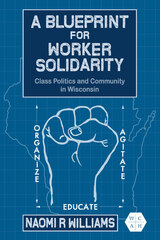 A Blueprint for Worker Solidarity: Class Politics and Community in Wisconsin
Naomi R Williams
University of Illinois Press, 2025 Like many Midwestern factory towns, deindustrialization damaged Racine in the 1970s and 1980s. But the Wisconsin city differed from others like it in one important way: workers maintained their homegrown working-class economy and political culture. Even as labor declined across the country, Racine’s workers successfully fought for fair housing and education, held politicians accountable, and allied with racial and gender justice organizations. Naomi R Williams traces the journeys of two local activists to highlight how people can support democracy and economic freedom in the twenty-first century. In Racine, ideas of class and race shifted but remained strong. The broad-based class politics that emerged drew on racial analysis, vigilant organizing, and agile labor leadership that organized more people. Unionized workers in turn won political power while uniting to resist conservative and corporate attacks. Charting Racine’s transition, Williams breaks down how worker solidarity persevered and presents lessons that can provide valuable guidance for today’s generation of activists.
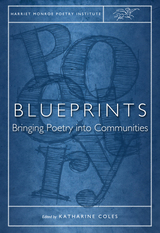 Blueprints: Bringing Poetry into Communities
Katharine Coles
University of Utah Press, 2011 How does one bring poetry to a community? And who is going to make it happen? In response to these questions posed by the Harriet Monroe Poetry Institute, Katharine Coles and a cadre of poets and artists provide this essential guide and inspiration. Blueprints creates for poets and arts organizers the sense that they are part of a larger, noble endeavor based in shared values and commitment to poetry. The first three sections include essays by a dozen poets and artists about the ways they have brought poetry into different kinds of communities. These essays demonstrate what has been done and what can be done and will inspire others to bring poetry into their own communities. The final section provides a practical "toolkit" loaded with experience-based advice and the tools and strategies necessary to acocmplish those endeavors. Essayists:
Elizabeth Alexander
Sherwin Bitsui
Lee Briccetti
Alison Hawthorne Deming
Dana Gioia
Robert Hass
Bas Kwakman
Thomas Lux
Christopher Merrill
Luis Rodriguez
Anna Deavere Smith
Patricia Smith Contributors to the Toolkit:
Elizabeth Allen
Susan Boskoff
Katharine Coles
Tree Swenson
Orlando White
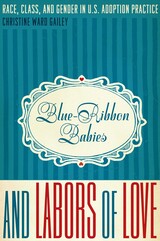 Blue-Ribbon Babies and Labors of Love: Race, Class, and Gender in U.S. Adoption Practice
By Christine Ward Gailey
University of Texas Press, 2010 Most Americans assume that shared genes or blood relationships provide the strongest basis for family. What can adoption tell us about this widespread belief and American kinship in general? Blue-Ribbon Babies and Labors of Love examines the ways class, gender, and race shape public and private adoption in the United States. Christine Ward Gailey analyzes the controversies surrounding international, public, and transracial adoption, and how the political and economic dynamics that shape adoption policies and practices affect the lives of people in the adoption nexus: adopters, adoptees, birth parents, and agents within and across borders. Interviews with white and African-American adopters, adoption social workers, and adoption lawyers, combined with her long-term participant-observation in adoptive communities, inform her analysis of how adopters' beliefs parallel or diverge from the dominant assumptions about kinship and family. Gailey demonstrates that the ways adoptive parents speak about their children vary across hierarchies of race, class, and gender. She shows that adopters' notions about their children's backgrounds and early experiences, as well as their own "family values," influence child rearing practices. Her extensive interviews with 131 adopters reveal profoundly different practices of kinship in the United States today. Moving beyond the ideology of "blood is thicker than water," Gailey presents a new way of viewing kinship and family formation, suitable to times of rapid social and cultural change.
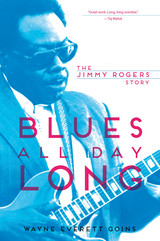 Blues All Day Long: The Jimmy Rogers Story
Wayne Everett Goins, foreword by Kim Wilson
University of Illinois Press, 2014 A member of Muddy Waters' legendary late 1940s-1950s band, Jimmy Rogers pioneered a blues guitar style that made him one of the most revered sidemen of all time. Rogers also had a significant if star-crossed career as a singer and solo artist for Chess Records, releasing the classic singles "That's All Right" and "Walking By Myself."
In Blues All Day Long, Wayne Everett Goins mines seventy-five hours of interviews with Rogers' family, collaborators, and peers to follow a life spent in the blues. Goins' account takes Rogers from recording Chess classics and barnstorming across the South to a late-in-life renaissance that included new music, entry into the Blues Hall of Fame, and high profile tours with Eric Clapton and the Rolling Stones. Informed and definitive, Blues All Day Long fills a gap in twentieth century music history with the story of one of the blues' eminent figures and one of the genre's seminal bands.
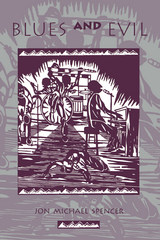 Blues and Evil
Yahya Jongintaba
University of Tennessee Press, 1993 The term “blues” has traditionally conveyed an image of hard-living, hard-drinking, carousing singers and musicians grinding out melancholy tunes and evil lyrics. Contesting that stereotypical notion, this study argues that spiritual values are clearly reflected in the blues’ mythologized history, folk-theological language, and philosophical speculation on the dual existence of good and evil. By using a theomusicalogical approach, Yahya Jongintaba (formerly Jon Michael Spencer) is able to push aside accepted attitudes and present a unique study of the blues and the culture that created it. He reveals religious substance in this music’s content and language that has been gradually obscured as the blues evolved from a simple rural music following Reconstruction to its present urban form. The evidence strongly implies a fundamental religious concern for the same life issues expressed in orthodox religious music. Spencer suggests that white blues scholars have tended to overlook the religious nature of the blues partly because they have not fully understood African-American culture. They have tended to give validity to the old southern folkloric belief that blues music was “devil’s music,” disregarding the ethos of the blues as it exists on the periphery of doctrinal Christianity where religious pondering, as well as opposition to white oppression, could be expressed behind a protective veil of music.
Blues and Roots/Rue and Bluets: A Garland for the Southern Appalachians
Jonathan Williams
Duke University Press, 1985 Jonathan Williams’s poetry has been described as brilliant, sensuous, lyrical, quirky, suave, vital, joyful, sardonic, melodious, passionate, alive, pyrotechnic. This new, much enlarged edition of Blues and Roots displays all of the above. Williams has tramped the Appalachian Trail for decades, botanizing, jotting down specimens of authentic American speech, graffiti, superstitions, and nostrums—always curious, alert, and affectionately attentive. Blues and Roots focuses on the linguistic horizon of Appalachia in lyrics of wonder and light, of wit and comic incongruity, in found poems of the speech of his mountain neighbors. Publishers Weekly said of the earlier edition, “One of the most beautiful and evocative tributes to the Appalachians and its people yet published.” Blues and Roots is a fine celebration; Wiliams is a joyful ringmaster.
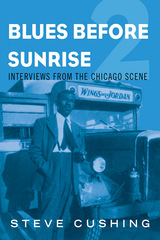 Blues Before Sunrise 2: Interviews from the Chicago Scene
Steve Cushing
University of Illinois Press, 2019 In this new collection of interviews, Steve Cushing once again invites readers into the vaults of Blues Before Sunrise, his acclaimed nationally syndicated public radio show. Icons from Memphis Minnie to the Gay Sisters stand alongside figures like schoolteacher Flossie Franklin, who helped Leroy Carr pen some of his most famous tunes; saxman Abb Locke and his buddy Two-Gun Pete, a Chicago cop notorious for killing people in the line of duty; and Scotty "The Dancing Tailor" Piper, a font of knowledge on the black entertainment scene of his day. Cushing also devotes a section to religious artists, including the world-famous choir Wings Over Jordan and their travails touring and performing in the era of segregation. Another section focuses on the jazz-influenced Bronzeville scene that gave rise to Marl Young, Andrew Tibbs, and many others while a handful of Cushing's early brushes with the likes of Little Brother Montgomery, Sippi Wallace, and Blind John Davis round out the volume.Diverse and entertaining, Blues Before Sunrise 2 adds a chorus of new voices to the fascinating history of Chicago blues.
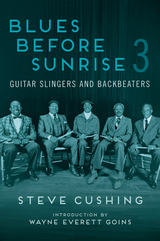 Blues Before Sunrise 3: Guitar Slingers and Backbeaters
Steve Cushing. Introduction by Wayne Everett Goins
University of Illinois Press, 2025 Steve Cushing’s third volume of interviews from Blues Before Sunrise puts fans face-to-face with music legends and industry figures. The volume kicks off with a roundtable featuring drumming all-stars Earl Phillips, S.P. Leary, Odie Payne, Clifton James, and Fred Below discussing their lives and craft. Cushing segues to one-on-one interviews with Howlin’ Wolf sideman Phillips; Leary, a fellow Wolf alum and player with Sonny Boy Williamson II; Payne, known for his kick drum technique; longtime Muddy Waters drummer Willie “Big Eyes” Smith; next-generation standard bearer and session mainstay Casey Jones; and King Records house drummer Phillip Paul. Interviews with guitarists include talks with Honeyboy Edwards, whose friendships with innumerable Chicago blues legends (and Robert Johnson) predated the Great Migration; jazz player turned bluesman Guitar Shorty; and figures like Texas native Roy Gaines, Johnny Heartsman of Oakland, and Memphis-born Floyd Murphy. A final section offers interviews with vocalists, record label founders, and other figures. Music scholar Wayne Everett Goins provides an introduction on blues history, blues style, and the careers of the featured artists. Interviews: Joel Dorn, Honeyboy Edwards, Slim Gaillard, Roy Gaines, Johnny Heartsman, Franz Jackson, Casey Jones, S.P. Leary, Floyd Murphy, Jimmy “T-99” Nelson, Johnny Parth, Phillip Paul, Odie Payne, Earl Phillips, Art Sheridan, Guitar Shorty, Willie “Big Eyes” Smith, and Norvel Taborn
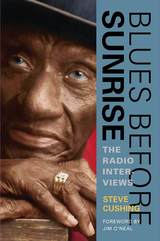 Blues Before Sunrise: The Radio Interviews
Steve Cushing, Foreword by Jim O'Neal
University of Illinois Press, 2010 This collection assembles the best interviews from Steve Cushing's long-running radio program Blues Before Sunrise, the nationally syndicated, award-winning program focusing on vintage blues and R&B. As both an observer and performer, Cushing has been involved with the blues scene in Chicago for decades. His candid, colorful interviews with prominent blues players, producers, and deejays reveal the behind-the-scenes world of the formative years of recorded blues. Many of these oral histories detail the careers of lesser-known but greatly influential blues performers and promoters. The book focuses in particular on pre–World War II blues singers, performers active in 1950s Chicago, and nonperformers who contributed to the early blues world. Interviewees include Alberta Hunter, one of the earliest African American singers to transition from Chicago's Bronzeville nightlife to the international spotlight, and Ralph Bass, one of the greatest R&B producers of his era. Blues expert, writer, record producer, and cofounder of Living Blues Magazine Jim O'Neal provides the book's foreword.
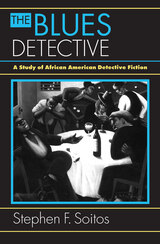 The Blues Detective: A Study of African American Detective Fiction
Stephen Soitos
University of Massachusetts Press, 1996 This illuminating book makes the case for a tradition of African American detective fiction--novels written by black Americans about black detectives and incorporating distinctly African American tropes and themes. Beginning with Pauline Hopkins in 1901, black authors consciously altered and subverted the formulas of detective fiction in significant ways. Such writers as J. E. Bruce, Rudolph Fisher, Chester Himes, Ishmael Reed, and Clarence Major created a new genre that responded to the social and political concerns of the black community.
Examining the work of these authors, Stephen Soitos frames his analysis in terms of four uniquely African American tropes: altered detective personas, double-consciousness detection, black vernaculars, and hoodoo. He argues that black writers created sleuths who were in fact "blues detectives," engaged not only in solving crimes, but also in exploring the mysteries of black life and culture.
Soitos grounds his study in African American literary theory, particularly the work of Houston Baker, Bernard Bell, and Henry Louis Gates, Jr. He offers both a new way of conceiving black detective fiction and a series of insightful readings of books in this genre.
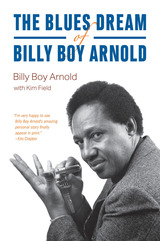 The Blues Dream of Billy Boy Arnold
Billy Boy Arnold with Kim Field
University of Chicago Press, 2021 The frank, funny, and unforgettable autobiography of a living legend of Chicago blues.
Simply put, Billy Boy Arnold is one of the last men standing from the Chicago blues scene’s raucous heyday. What’s more, unlike most artists in this electrifying melting pot, who were Southern transplants, Arnold—a harmonica master who shared stages with Bo Diddley, Muddy Waters, and Howlin’ Wolf, plus a singer and hitmaker in his own right who first recorded the standards “I Wish You Would” and “I Ain’t Got You”—was born right here and has lived nowhere else. This makes his perspective on Chicago blues, its players, and its locales all the rarer and all the more valuable. Arnold has witnessed musical generations come and go, from the decline of prewar country blues to the birth of the electric blues and the worldwide spread of rock and roll. Working here in collaboration with writer and fellow musician Kim Field, he gets it all down. The Blues Dream of Billy Boy Arnold is a remarkably clear-eyed testament to more than eighty years of musical love and creation, from Arnold’s adolescent quest to locate the legendary Sonny Boy Williamson, the story of how he named Bo Diddley Bo Diddley, and the ups and downs of his seven-decade recording career. Arnold’s tale—candidly told with humor, insight, and grit—is one that no fan of modern American music can afford to miss.
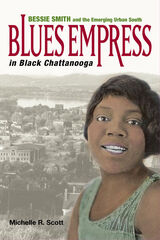 Blues Empress in Black Chattanooga: Bessie Smith and the Emerging Urban South
Michelle R. Scott
University of Illinois Press, 2007 As one of the first African American vocalists to be recorded, Bessie Smith is a prominent figure in American popular culture and African American history. Michelle R. Scott uses Smith's life as a lens to investigate broad issues in history, including industrialization, Southern rural to urban migration, black community development in the post-emancipation era, and black working-class gender conventions. Arguing that the rise of blues culture and the success of female blues artists like Bessie Smith are connected to the rapid migration and industrialization in the late nineteenth and early twentieth centuries, Scott focuses her analysis on Chattanooga, Tennessee, the large industrial and transportation center where Smith was born. This study explores how the expansion of the Southern railroads and the development of iron foundries, steel mills, and sawmills created vast employment opportunities in the postbellum era. Chronicling the growth and development of the African American Chattanooga community, Scott examines the Smith family's migration to Chattanooga and the popular music of black Chattanooga during the first decade of the twentieth century, and culminates by delving into Smith's early years on the vaudeville circuit.
Blues for Cannibals: The Notes from Underground
By Charles Bowden
University of Texas Press, 2018 Cultivated from the fierce ideas seeded in Blood Orchid, Blues for Cannibals is an elegiac reflection on death, pain, and a wavering confidence in humanity’s own abilities for self-preservation. After years of reporting on border violence, sex crimes, and the devastation of the land, Bowden struggles to make sense of the many ways in which we destroy ourselves and whether there is any way to survive. Here he confronts a murderer facing execution, sex offenders of the most heinous crimes, a suicidal artist, a prisoner obsessed with painting portraits of presidents, and other people and places that constitute our worst impulses and our worst truths. Painful, heartbreaking, and forewarning, Bowden at once tears us apart and yearns for us to find ourselves back together again.
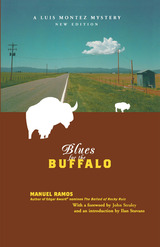 Blues for the Buffalo
Manuel Ramos
Northwestern University Press, 2004
Winner, 2013 3rd Annual Latino Books Into Movies Award for Suspensee/Mystery
The sun, the sand, a young beauty named Rachel in a white bikini—there's no better way to recover from the aches and pains of your latest case. At least that's what attorney and part-time detective Luis Montez thinks until the woman gives him the manuscript of her novel and vanishes.
Montez just wants to rebuild his Denåver practice, but an aggressive young P.I. with an emotional attachment to Rachel draws him in. With the woman's powerful adopted family on one side and unexplained death of a writer friend on the other, Montez digs up a series of long-told lies and long-hidden ugly truths. He also finds himself confronting one of the great unsolved mysteries of recent Chicano history. What happened to Oscar "Zeta" Acosta, the iconic activist-writer presumed dead since 1974? More to the point, what made Rachel insist the legendary Brown Buffalo was alive-and that he was her real father?
Blues for Unemployed Secret Police: Poems by Doug Anderson
Doug Anderson
Northwestern University Press, 2000 Doug Anderson's "Blues For Unemployed Secret Police" dramatically reflects his experience of growing up in the sixties, serving as a field medical corpsman in Viet Nam, and confronting the modern era where "a good torturer can always find a job." With passion, humor, and strikingly original images, these poems illuminate everything from bad politics to love gone wrong.
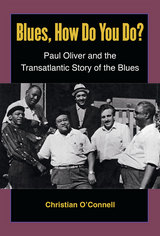 Blues, How Do You Do?: Paul Oliver and the Transatlantic Story of the Blues
Christian O’Connell
University of Michigan Press, 2015 Recent revisionist scholarship has argued that representations by white “outsider” observers of black American music have distorted historical truths about how the blues came to be. While these scholarly arguments have generated an interesting debate concerning how the music has been framed and disseminated, they have so far only told an American story, failing to acknowledge that in the post-war era the blues had spread far beyond the borders of the United States. As Christian O’Connell shows in Blues, How Do You Do? Paul Oliver’s largely neglected scholarship—and the unique transatlantic cultural context it provides—is vital to understanding the blues. O’Connell’s study begins with Oliver’s scholarship in his early days in London as a writer for the British jazz press and goes on to examine Oliver’s encounters with visiting blues musicians, his State Department–supported field trip to the US in 1960, and the resulting photographs and oral history he produced, including his epic “blues narrative,” The Story of the Blues (1969). Blues, How Do You Do? thus aims to move away from debates that have been confined within the limits of national borders—or relied on clichés of British bands popularizing American music in America—to explore how Oliver’s work demonstrates that the blues became a reified ideal, constructed in opposition to the forces of modernity.
Blues, Ideology, and Afro-American Literature: A Vernacular Theory
Houston A. Baker Jr.
University of Chicago Press, 1987 Relating the blues to American social and literary history and to Afro-American expressive culture, Houston A. Baker, Jr., offers the basis for a broader study of American culture at its "vernacular" level. He shows how the "blues voice" and its economic undertones are both central to the American narrative and characteristic of the Afro-American way of telling it.
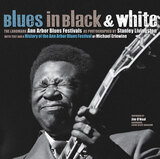 Blues in Black and White: The Landmark Ann Arbor Blues Festivals
As photographed by Stanley Livingston with Text and a History of the Ann Arbor Blues Festival by Michael Erlewine
University of Michigan Press, 2010 "This was really the first time that blues music, especially Chicago/urban blues, was showcased in this way. Sadly, the festivals were not recorded professionally. So Mr. Livingston's photos are the best record of the festivals."
---Michael Jewett, longtime weekday afternoon host of 89.1 Jazz and host of "Blues & Some Uthuh Stuff" "The photos are works of art. It is great to see photos of musicians such as Buddy Guy and James Cotton looking so young and vibrant. And it is great to see photos of blues legends such as John Lee Hooker, Roosevelt Sykes, Howlin' Wolf, and Son House, who have long since passed away."
---Peter Madcat Ruth, Grammy-winning blues harmonica player "If Woodstock was one of the Fifty Moments That Changed Rock 'n' Roll History, as honored in Rolling Stone magazine, then the Ann Arbor Blues Festival was the coronation for the blues roots that sired rock to begin with. . . . finally we have this amazing book of Stanley Livingston's priceless images, along with Michael Erlewine's detailed chronology."
---From the foreword by Jim O'Neal, Cofounder, Living Blues Magazine In 1969 and 1970, the first Ann Arbor Blues Festivals brought together the greatest-ever selection of blues performers---an enormous blues party that seemed to feature every big name in the world of blues. The Ann Arbor Blues Festival was just that: a festival and celebration of city blues. It helped to mark the discovery of modern blues music (and the musicians who made that music) by a much larger audience. The festival, however, was something more than just a white audience discovering black music. Never before had such a far-reaching list of performers been assembled, including the grandfathers of southern country blues and the hottest electric bands from Chicago. These groundbreaking festivals were the seed that grew into the Ann Arbor Blues and Jazz Festival, which was continued annually for many years. To name just a few of the dozens of artists who performed at the festival: Luther Allison, John Lee Hooker, Howlin' Wolf, B.B. King, Muddy Waters, Otis Rush, Hound Dog Taylor, Big Mama Thorton, T-Bone Walker, Sippie Wallace, Junior Wells, and Mighty Joe Young. Stanley Livingston, a professional photographer from Ann Arbor, captured these legendary performances onstage---as well as the goings-on backstage. Livingston's thousands of photographs from these festivals, previously unpublished and known only to a few, are among the finest candid blues shots ever taken. Together with editor and archivist Michael Erlewine's text accompaniments, these photographs, reproduced here as high-quality duotones, comprise a visual history and important keepsake for blues aficionados everywhere. Stanley Livingston was an award-winning photographer living and working in Ann Arbor until he passed away in 2010, after the book was released. Michael Erlewine, also from Ann Arbor, is a renowned archivist of popular culture and founder of the All-Music Guide (allmusic.com) and editor of a number of books on blues and jazz. Cover photo of B.B. King by Stanley Livingston
 Blues in the Blood
Julien Delmaire
Seagull Books, 2023 A moving ode to the Mississippi delta inspired by magical realism and written in vibrant and poetic prose.
Blues in the Blood is an ode to the spring of 1932 in the Mississippi delta, when stifling heat crushed the countryside and threatened the harvest, pervasive injustice ruled the day, and ghostly riders of the Ku Klux Klan spread terror. A panoramic historical and musical portrait, Blues in the Blood follows a poor young Black couple who believe their love for each other will save them from this devastation. Julien Delmaire introduces us to a gallery of figures: Blacks, Whites, Native Americans, mulattos, landowners, itinerant bluesmen, preachers, witches, corrupt politicians, prisoners, bootleggers, and Legba, the voodoo god, “master of crossroads,” who, like an otherworldly detective, watches over people’s destinies. As the story unfolds, a world is reborn: the delta, the birthplace of the blues, in which oppressed women and men rediscover the voices and rhythms of their humanity.
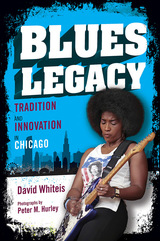 Blues Legacy: Tradition and Innovation in Chicago
David Whiteis
University of Illinois Press, 2019 Chicago blues musicians parlayed a genius for innovation and emotional honesty into a music revered around the world. As the blues evolves, it continues to provide a soundtrack to, and a dynamic commentary on, the African American experience: the legacy of slavery; historic promises and betrayals; opportunity and disenfranchisement; the ongoing struggle for freedom. Through it all, the blues remains steeped in survivorship and triumph, a music that dares to stare down life in all its injustice and iniquity and still laugh--and dance--in its face. David Whiteis delves into how the current and upcoming Chicago blues generations carry on this legacy. Drawing on in-person interviews, Whiteis places the artists within the ongoing social and cultural reality their work reflects and helps create. Beginning with James Cotton, Eddie Shaw, and other bequeathers, he moves through an all-star council of elders like Otis Rush and Buddy Guy and on to inheritors and today's heirs apparent like Ronnie Baker Brooks, Shemekia Copeland, and Nellie "Tiger" Travis. Insightful and wide-ranging, Blues Legacy reveals a constantly adapting art form that, whatever the challenges, maintains its links to a rich musical past.
 Blues Mamas and Broadway Belters: Black Women, Voice, and the Musical Stage
Masi Asare
Duke University Press, 2024 In Blues Mamas and Broadway Belters, songwriter, scholar, and dramatist Masi Asare explores the singing practice of black women singers in US musical theatre between 1900 and 1970. Asare shows how a vanguard of black women singers including Gertrude “Ma” Rainey, Bessie Smith, Ethel Waters, Pearl Bailey, Juanita Hall, Lena Horne, Eartha Kitt, Diahann Carroll, and Leslie Uggams created a lineage of highly trained and effective voice teachers whose sound and vocal techniques continue to be heard today. Challenging pervasive narratives that these and other black women possessed “untrained” voices, Asare theorizes singing as a form of sonic citational practice—how the sound of the teacher’s voice lives on in the student’s singing. From vaudeville-blues shouters, black torch singers, and character actresses to nightclub vocalists and Broadway glamour girls, Asare locates black women of the musical stage in the context of historical voice pedagogy. She invites readers not only to study these singers, but to study with them—taking seriously what they and their contemporaries have taught about the voice. Ultimately, Asare speaks to the need to feel and hear the racial history in contemporary musical theatre.
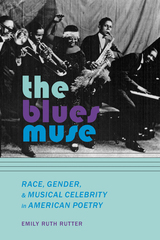 The Blues Muse: Race, Gender, and Musical Celebrity in American Poetry
Emily Ruth Rutter
University of Alabama Press, 2018 A critical analysis of the poetic representations and legacies of five landmark blues artists
The Blues Muse: Race, Gender, and Musical Celebrity in American Poetry focuses on five key blues musicians and singers—Gertrude “Ma” Rainey, Bessie Smith, Billie Holiday, Robert Johnson, and Lead Belly—and traces the ways in which these artists and their personas have been invoked and developed throughout American poetry. This study spans nearly one hundred years of literary and musical history, from the New Negro Renaissance to the present.
Emily Ruth Rutter not only examines blues musicians as literary touchstones or poetic devices, but also investigates the relationship between poetic constructions of blues icons and shifting discourses of race and gender. Rutter’s nuanced analysis is clear, compelling, and rich in critical assessments of these writers’ portraits of the musical artists, attending to their strategies and oversights.
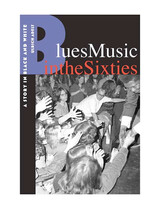 Blues Music in the Sixties: A Story in Black and White
Ulrich Adelt
Rutgers University Press, 2010 Can a type of music be "owned"? Examining how music is linked to racial constructs and how African American musicians and audiences reacted to white appropriation, Blues Music in the Sixties shows the stakes when whites claim the right to play and live the blues.
In the 1960s, within the larger context of the civil rights movement and the burgeoning counterculture, the blues changed from black to white in its production and reception, as audiences became increasingly white. Yet, while this was happening, blackness--especially black masculinity--remained a marker of authenticity. Crossing color lines and mixing the beats of B.B. King, Eric Clapton, and Janis Joplin; the Newport Folk Festival and the American Folk Blues Festival; and publications such as Living Blues, Ulrich Adelt discusses these developments, including the international aspects of the blues. He highlights the performers and venues that represented changing racial politics and addresses the impact and involvement of audiences and cultural brokers.
Blues of a Lifetime: Autobiography of Cornell Woolrich
Edited by Mark T. Bassett
University of Wisconsin Press, 1991 Blues of a Lifetime is essential reading for people interested in suspense novelist Cornell Woolrich, author of Rear Window. Woolrich’s autobiography includes accounts of his working methods, his family and home, memories of childhood, college experience, and his philosophy of life.
Blues of Heaven, The: Poems
Barbara Ras
University of Pittsburgh Press, 2021 In The Blues of Heaven, Barbara Ras delivers her characteristic subjects with new daring that both rattles and beguiles. Here are poems of grief over her brother’s death; doors to an idiosyncratic working-class childhood among Polish immigrants; laments for nature and politics out of kilter. Ras portrays the climate crisis, guns out of control, the reckless injustice and ignorance of the United States government. At the same time, her poems nimbly focus on particulars—these facts, these consequences—bringing the wreckage of unfathomable harm home with immediacy and integrity. Though her subjects may be dire, Ras also weaves her wise humor throughout, moving deftly from sardonic to whimsical to create an expansive, ardent, and memorable book.
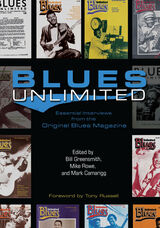 Blues Unlimited: Essential Interviews from the Original Blues Magazine
Edited by Bill Greensmith, Mike Rowe, and Mark Camarigg
University of Illinois Press, 2015 British blues fan Mike Leadbitter launched the magazine Blues Unlimited in 1963. The groundbreaking publication fueled the then-nascent, now-legendary blues revival that reclaimed seminal figures like Son House and Skip James from obscurity. Throughout its history, Blues Unlimited heightened the literacy of blues fans, documented the latest news and career histories of countless musicians, and set the standard for revealing long-form interviews. Conducted by Bill Greensmith, Mike Leadbitter, Mike Rowe, John Broven, and others, and covering a who's who of blues masters, these essential interviews from Blues Unlimited shed light on their subjects while gleaning colorful detail from the rough and tumble of blues history. Here is Freddie King playing a string of one-nighters so grueling it destroys his car; five-year-old Fontella Bass gigging at St. Louis funeral homes; and Arthur "Big Boy" Crudup rising from life in a packing crate to music stardom. Here, above all, is an eyewitness history of the blues written in neon lights and tears, an American epic of struggle and transcendence, of Saturday night triumphs and Sunday morning anonymity, of clean picking and dirty deals. Featuring interviews with: Fontella Bass, Ralph Bass, Fred Below, Juke Boy Bonner, Roy Brown, Albert Collins, James Cotton, Arthur "Big Boy" Crudup, Joe Dean, Henry Glover, L.C. Green, Dr. Hepcat, Red Holloway, Louise Johnson, Floyd Jones, Moody Jones, Freddie King, Big Maceo Merriweather, Walter Mitchell, Louis Myers, Johnny Otis, Snooky Pryor, Sparks Brothers, Jimmy Thomas, Jimmy Walker, and Baby Boy Warren.
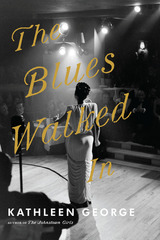 The Blues Walked In
Kathleen George
University of Pittsburgh Press, 2018 In 1936, life on the road means sleeping on the bus or in hotels for blacks only. After finishing her tour with Nobel Sissel’s orchestra, nineteen-year-old Lena Horne is walking the last few blocks to her father’s hotel in Pittsburgh’s Hill District. She stops at a lemonade stand and meets a Lebanese American girl, Marie David. Marie loves movies and adores Lena, and their chance meeting sparks a relationship that will intertwine their lives forever. Lena also meets Josiah Conner, a charismatic teenager who helps out at her father Teddy’s hotel. Josiah often skips school, dreams of being a Hollywood director, and has a crush on Lena. Although the three are linked by a determination to be somebody, issues of race, class, family, and education threaten to disrupt their lives and the bonds between them.
Lena’s father wants her to settle down and give up show business, but she’s entranced by the music and culture of the Hill. It’s a mecca for jazz singers and musicians, and nightspots like the Crawford Grill attract crowds of blacks and whites. Lena table-hops with local jazzmen as her father chaperones her through the clubs where she‘ll later perform. Singing makes her feel alive, and to her father’s dismay, reviewers can’t get enough of her. Duke Ellington adores her, Billy Strayhorn can’t wait to meet her, and she becomes “all the rage” in clubs and Hollywood for her beauty and almost-whiteness. Her signature version of “Stormy Weather” makes her a legend. But after sitting around for years at MGM as the studio heads try to figure out what to do with her, she isn’t quite sure what she’s worth.
Marie and Josiah follow Lena’s career in Hollywood and New York through movie magazines and the Pittsburgh Courier. Years pass until their lives are brought together again when Josiah is arrested for the murder of a white man. Marie and Lena decide they must get Josiah out of prison—whatever the personal cost.
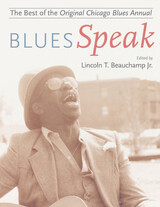 BluesSpeak: Best of the Original Chicago Blues Annual
Lincoln T. Beauchamp, Jr.
University of Illinois Press, 2010 This incomparable anthology collects articles, interviews, fiction, and poetry from the Original Chicago Blues Annual, one of music history's most significant periodical blues publications. Founded and operated from 1989 to 1995 by African American musician and entrepreneur Lincoln T. Beauchamp Jr., OCBA gave voice to the blues community and often frankly addressed contentious issues within the blues such as race, identity, prejudice, wealth, gender, and inequity. OCBA often expressed an explicitly black perspective, but its contributors were a mix of black and white, American and international. Likewise, although OCBA's roots and main focus were in Chicago, Beauchamp's vision for the publication (and his own activities as a blues performer and promoter) embraced an international dimension, reflecting a broad diversity of blues audiences and activities in locations as farflung as Iceland, Poland, France, Italy, and South Africa. This volume includes key selections from OCBA's seven issues and features candid interviews with blues luminaries such as Koko Taylor, Eddie Boyd, Famoudou Don Moye, Big Daddy Kinsey, Lester Bowie, Junior Wells, Billy Boy Arnold, Herb Kent, Barry Dolins, and many more. Also featured are heartfelt memorials to bygone blues artists, insightful observations on the state of the blues in Chicago and beyond, and dozens of photographs of performers, promoters, and other participants in the worldwide blues scene.
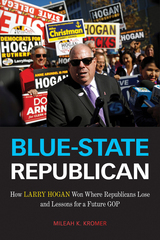 Blue-State Republican: How Larry Hogan Won Where Republicans Lose and Lessons for a Future GOP
Mileah K. Kromer
Temple University Press, 2023 Larry Hogan is one of the most popular political figures in the United States today. The two-term Republican governor of Maryland first won his seat after upsetting a favorite of the Democratic political establishment, and then overcame the Trump-driven wave in the heartland of the #resistance to win a second term in 2018. Blue-State Republican is the remarkable story of how his carefully messaged, pragmatic approach to governance helped build a coalition of moderate and conservative Democrats, independents, women, college-educated and Black voters and maintained his GOP base during a time of polarization and negative partisanship. Mileah Kromer takes readers inside Maryland politics to illustrate exactly how Hogan won where Republicans lose and consider whether the un-Trump Republican offers any lessons for how the GOP can win the center-right voters who continue to make up a majority of the country. Kromer conducts interviews with key political leaders and insiders, including Hogan himself, to explain the mechanics of his political success. She also provides a cogent analysis of public opinion polls and focus groups, ultimately showing why the success of a blue-state Republican matters outside of his home state, especially as Hogan considers a 2024 Presidential run.
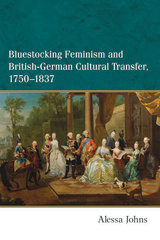 Bluestocking Feminism and British-German Cultural Transfer, 1750-1837
Alessa Johns
University of Michigan Press, 2014 Bluestocking Feminism and British-German Cultural Transfer, 1750–1837 examines the processes of cultural transfer between Britain and Germany during the Personal Union, the period from 1714 to 1837 when the kings of England were simultaneously Electors of Hanover. While scholars have generally focused on the political and diplomatic implications of the Personal Union, Alessa Johns offers a new perspective by tracing sociocultural repercussions and investigating how, in the period of the American and French Revolutions, Britain and Germany generated distinct discourses of liberty even though they were nonrevolutionary countries. British and German reformists—feminists in particular—used the period’s expanded pathways of cultural transfer to generate new discourses as well as to articulate new views of what personal freedom, national character, and international interaction might be. Johns traces four pivotal moments of cultural exchange: the expansion of the book trade, the rage for translation, the effect of revolution on intra-European travel and travel writing, and the impact of transatlantic journeys on visions of reform. Johns reveals the way in which what she terms “bluestocking transnationalism” spawned discourses of liberty and attempts at sociocultural reform during this period of enormous economic development, revolution, and war.
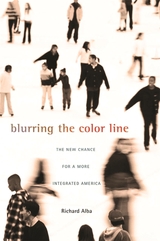 Blurring the Color Line: The New Chance for a More Integrated America
Richard Alba
Harvard University Press, 2009 Richard Alba argues that the social cleavages that separate Americans into distinct, unequal ethno-racial groups could narrow dramatically in the coming decades. During the mid-twentieth century, the dominant position of the United States in the postwar world economy led to a rapid expansion of education and labor opportunities. As a result of their newfound access to training and jobs, many ethnic and religious outsiders, among them Jews and Italians, finally gained full acceptance as members of the mainstream. Alba proposes that this large-scale assimilation of white ethnics was a result of “non-zero-sum mobility,” which he defines as the social ascent of members of disadvantaged groups that can take place without affecting the life chances of those who are already members of the established majority.
Alba shows that non-zero-sum mobility could play out positively in the future as the baby-boom generation retires, opening up the higher rungs of the labor market. Because of the changing demography of the country, many fewer whites will be coming of age than will be retiring. Hence, the opportunity exists for members of other groups to move up. However, Alba cautions, this demographic shift will only benefit disadvantaged American minorities if they are provided with access to education and training. In Blurring the Color Line, Alba explores a future in which socially mobile minorities could blur stark boundaries and gain much more control over the social expression of racial differences.
|
|

